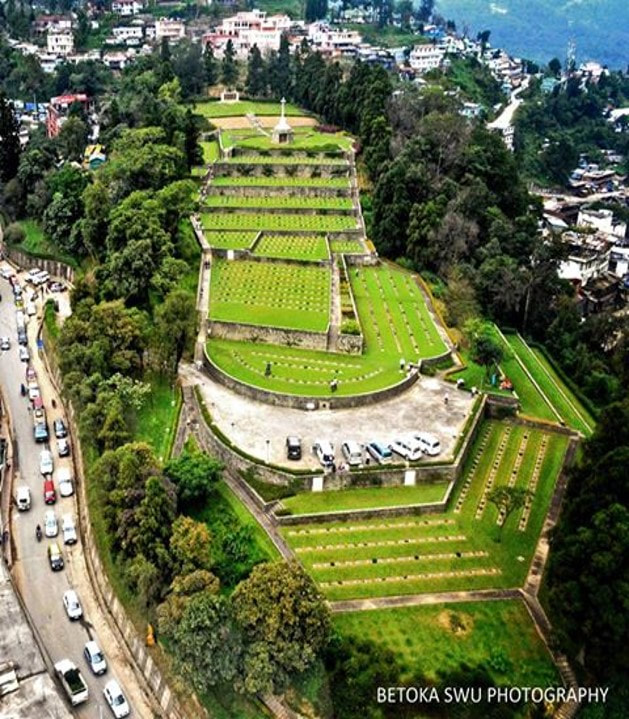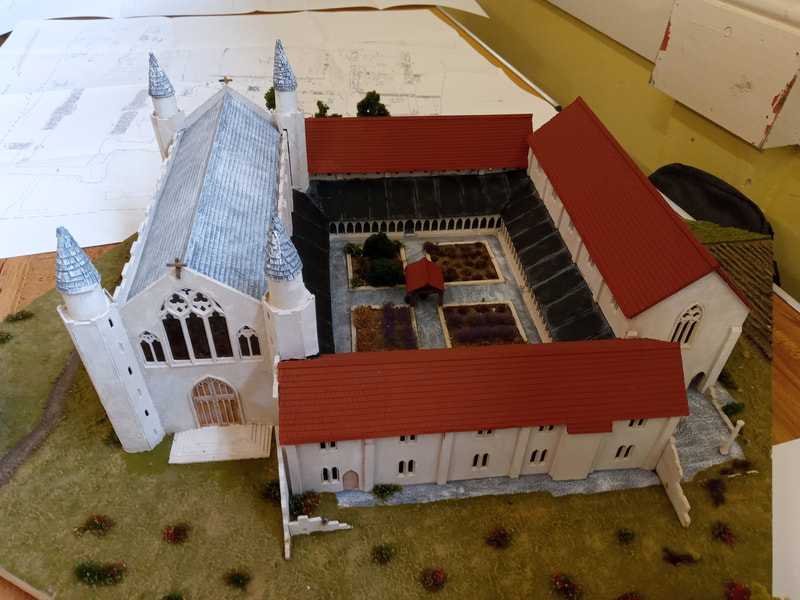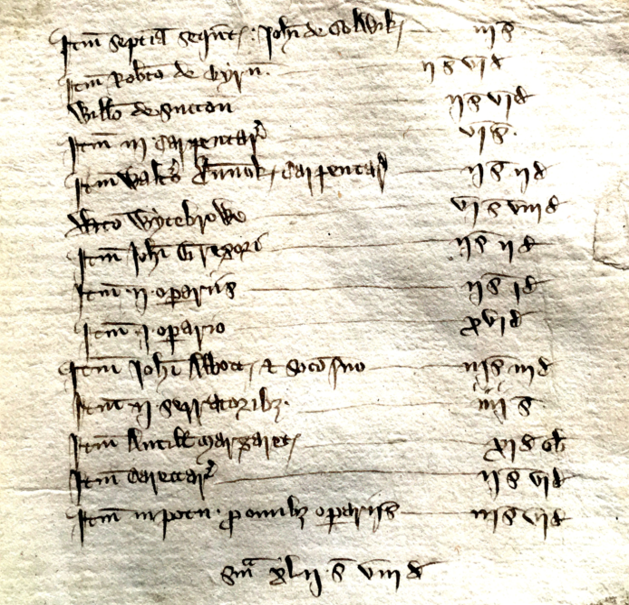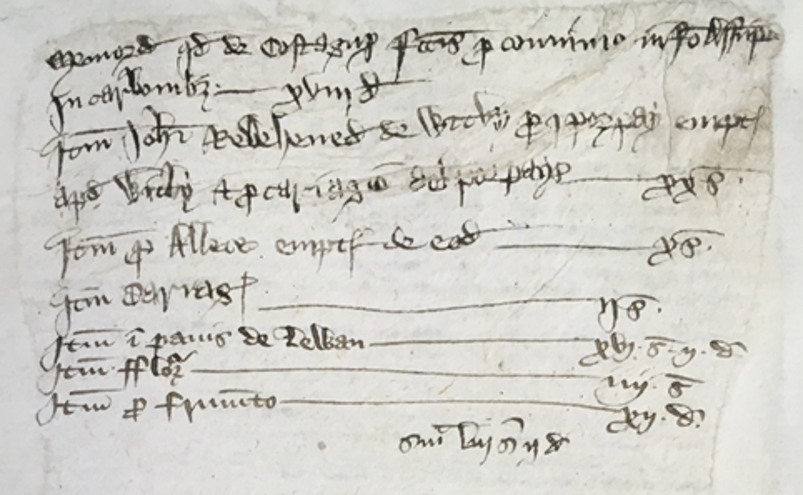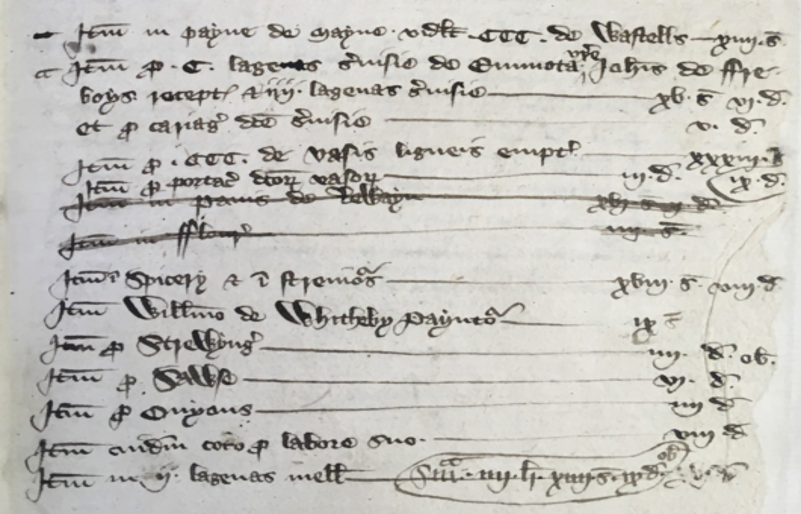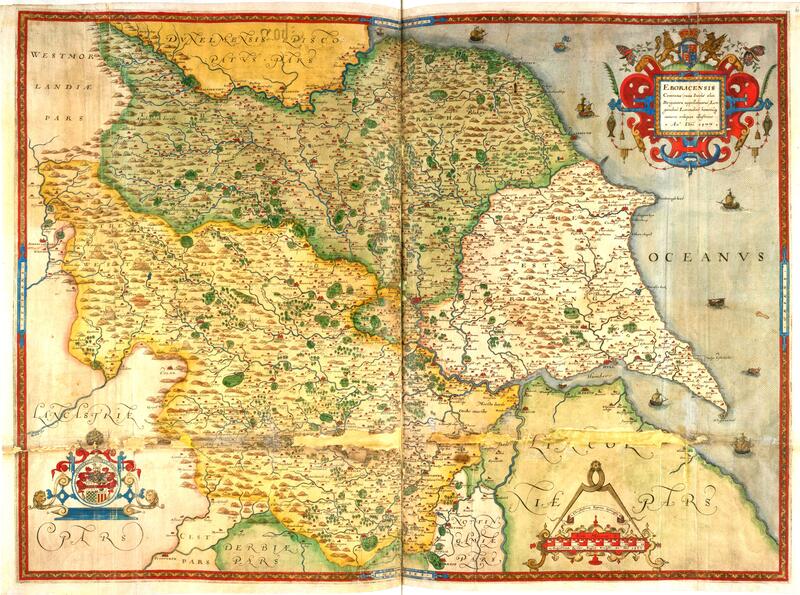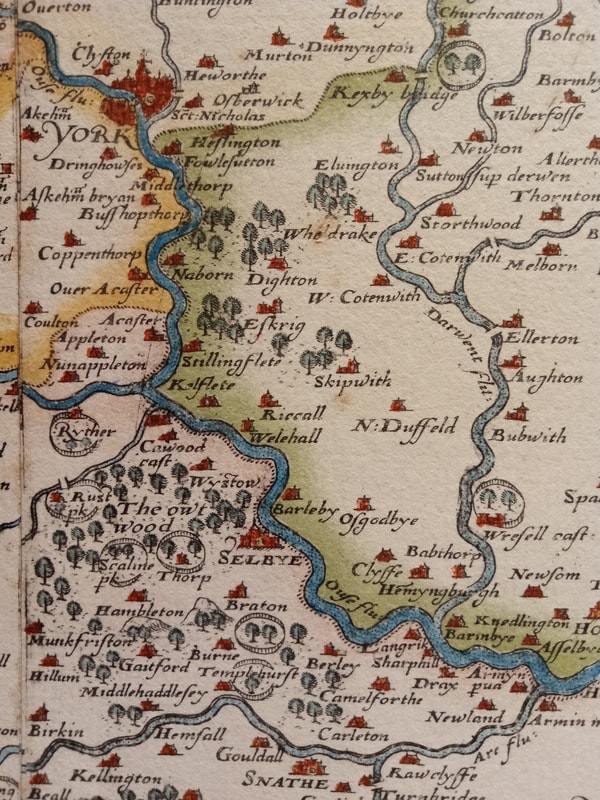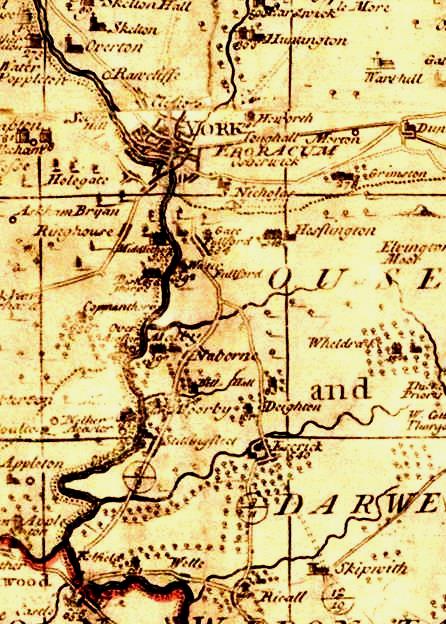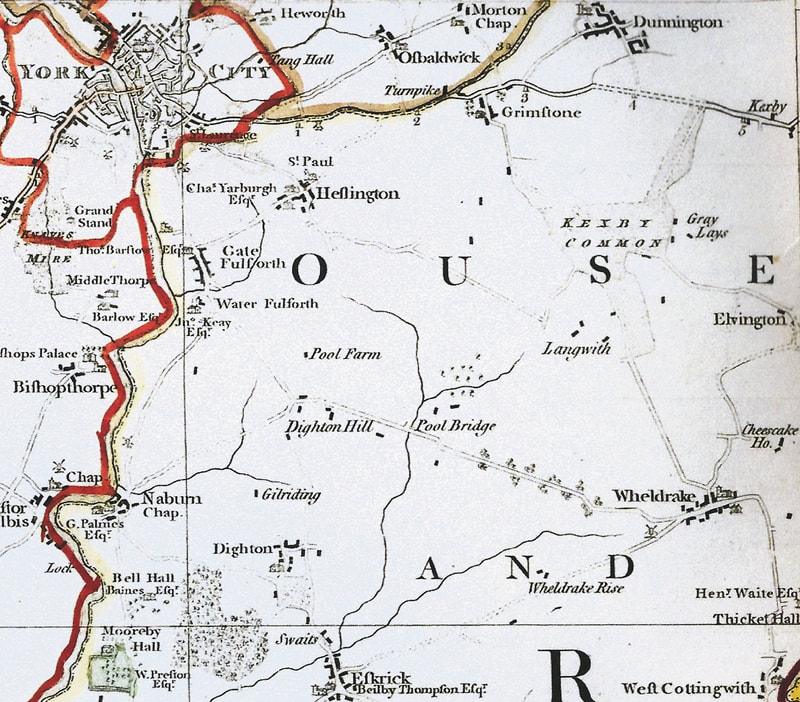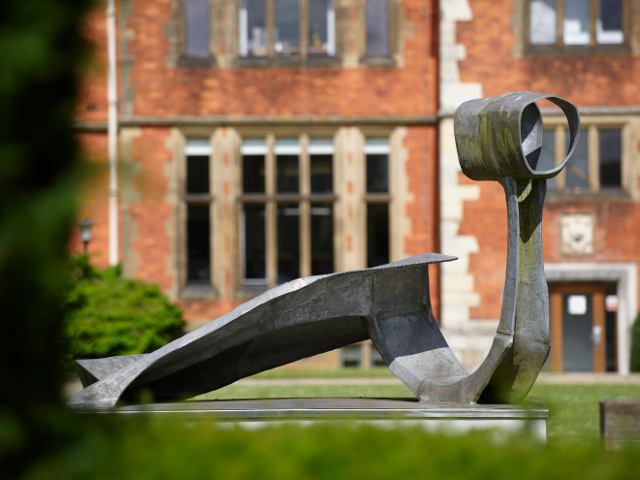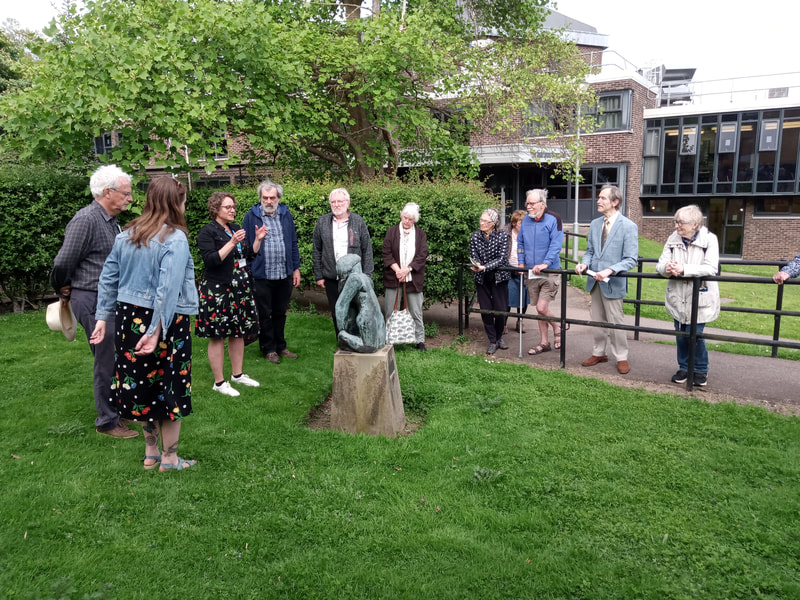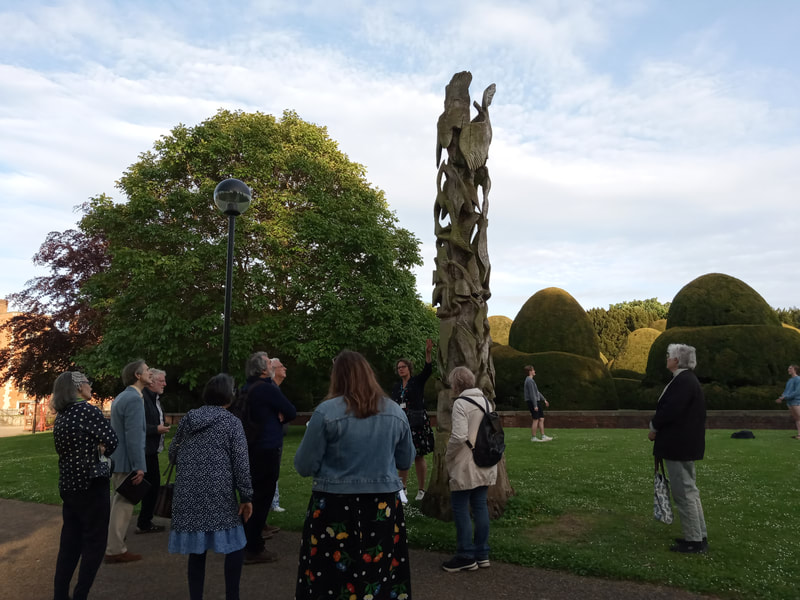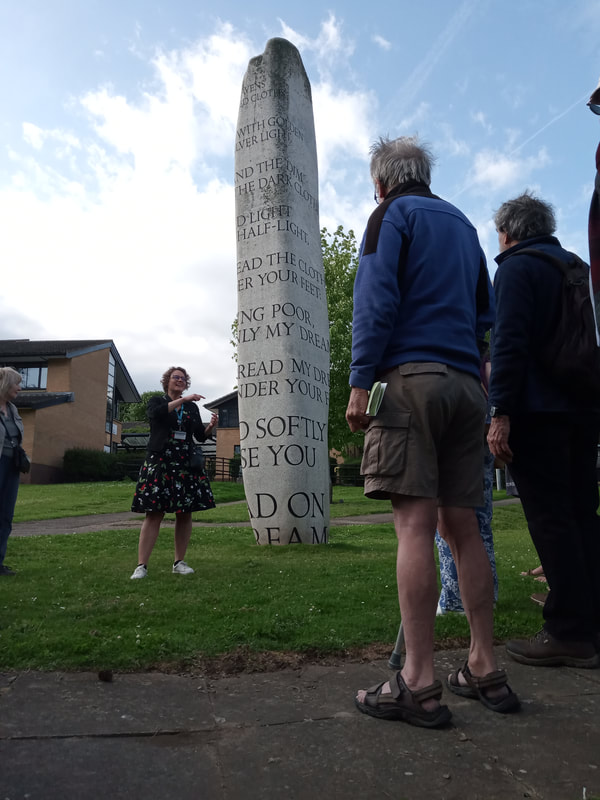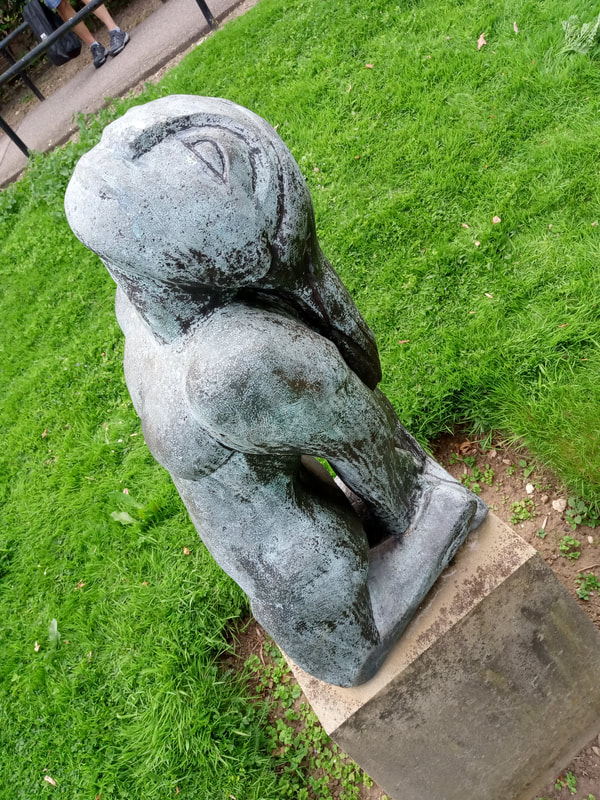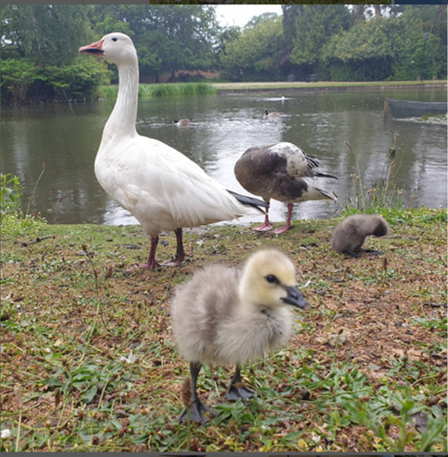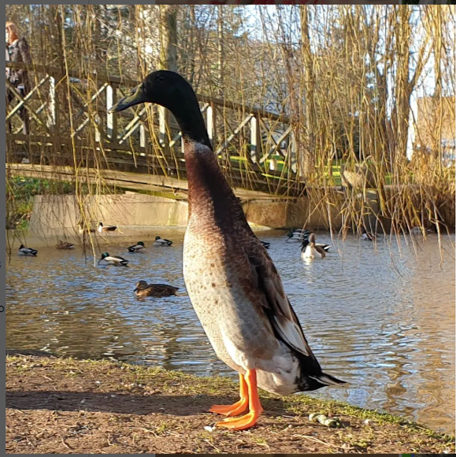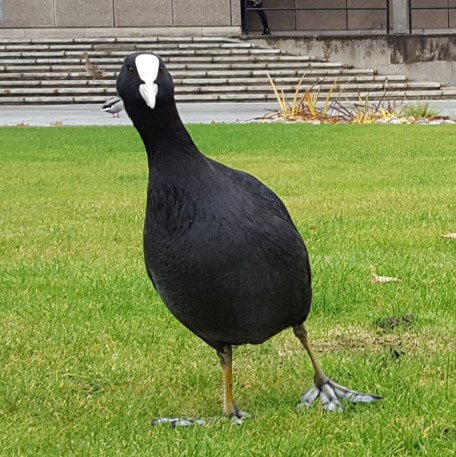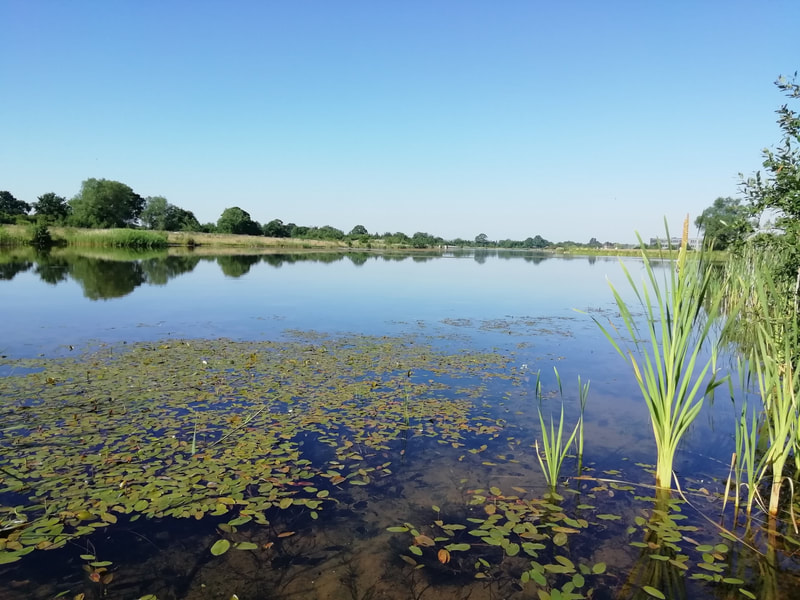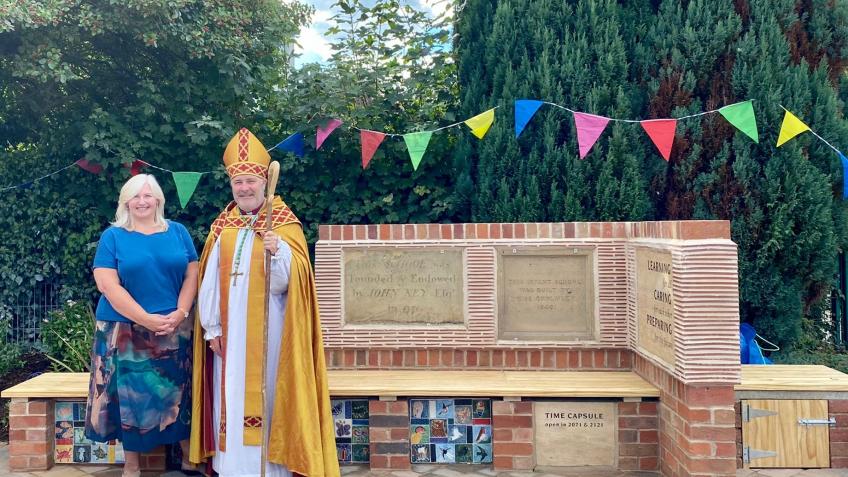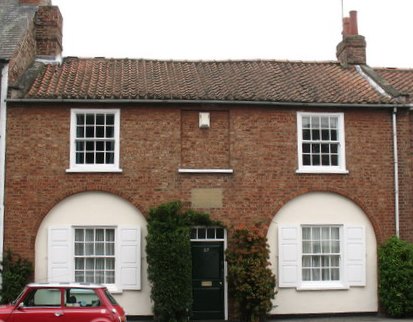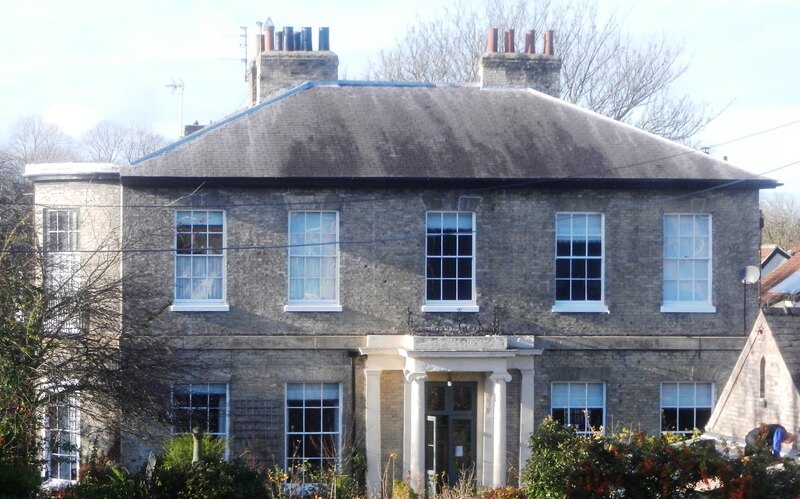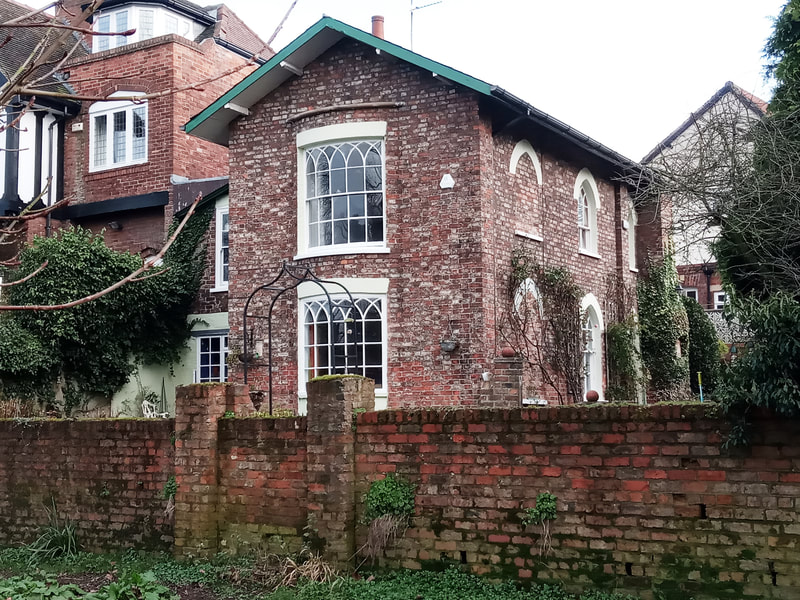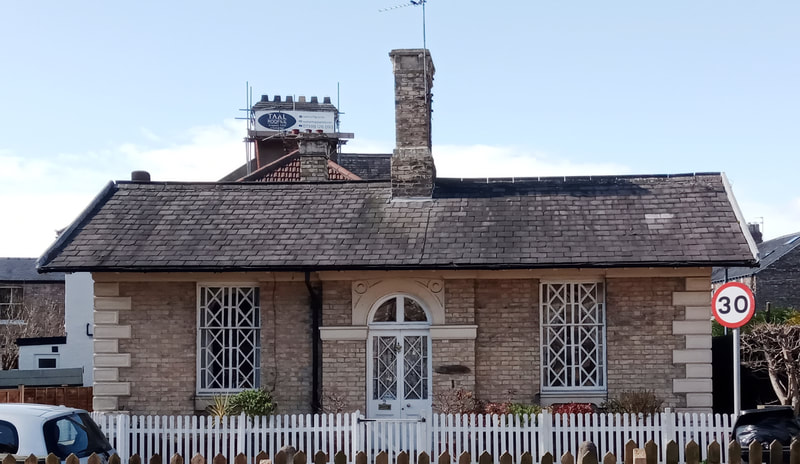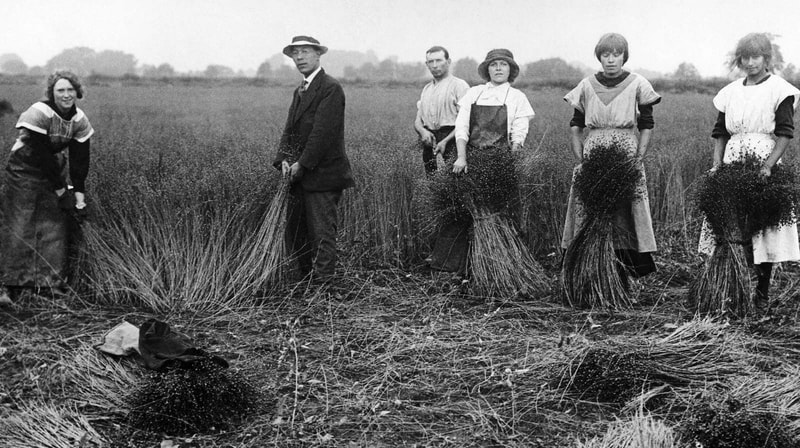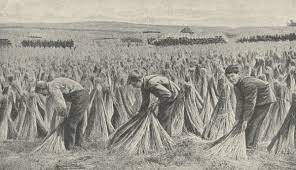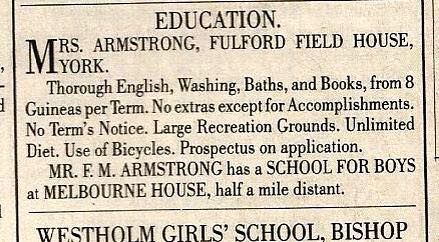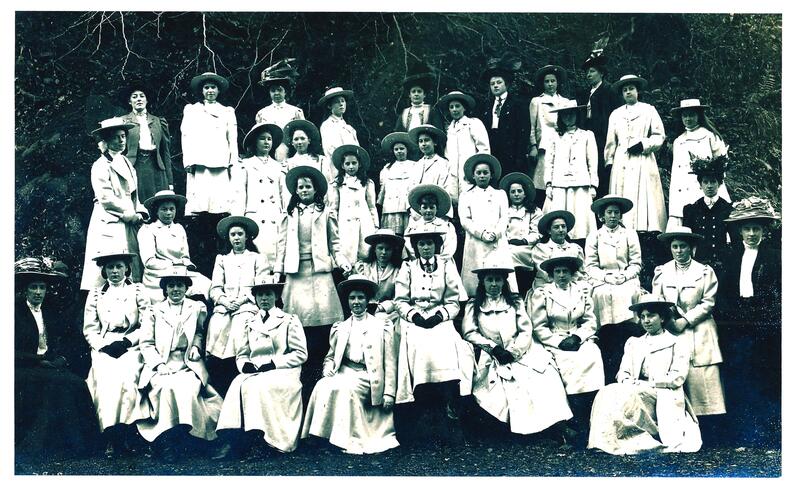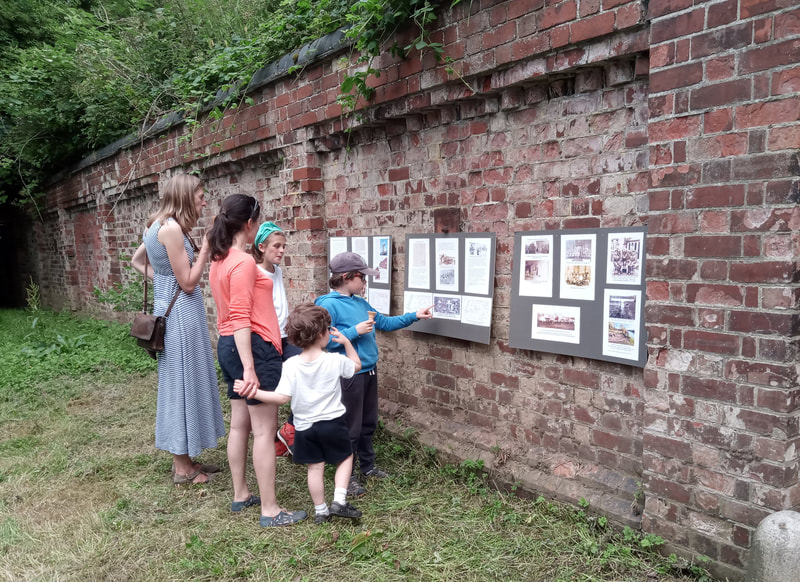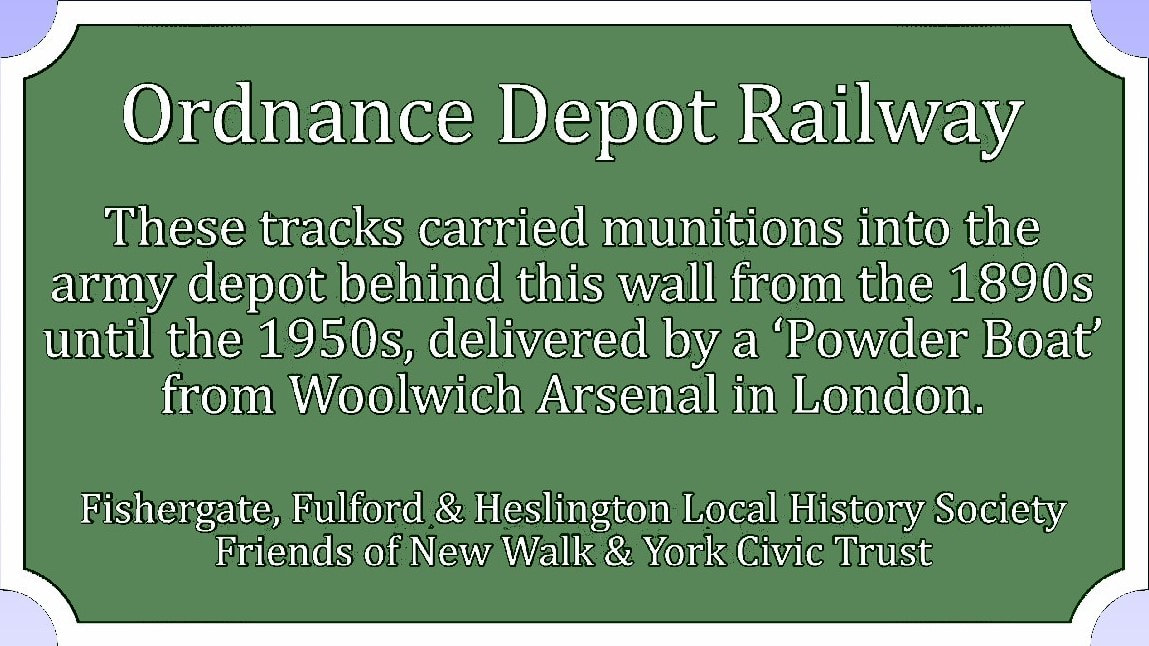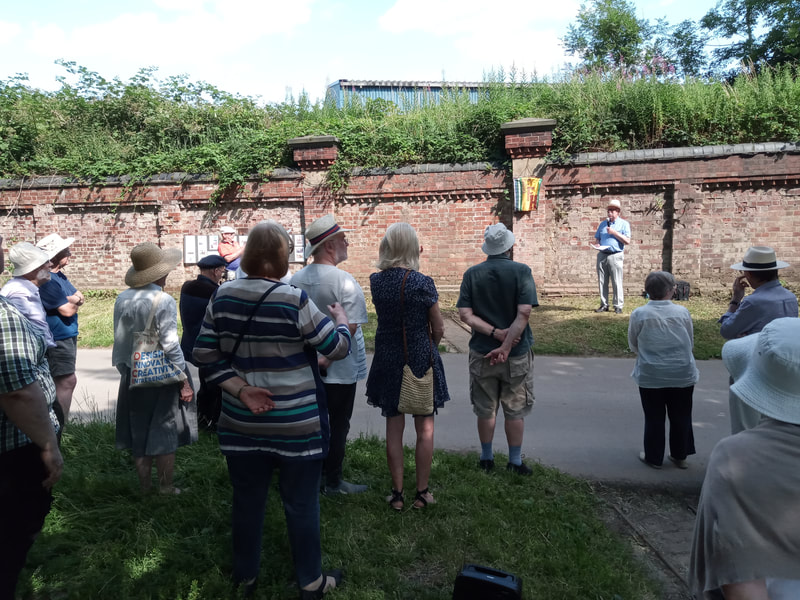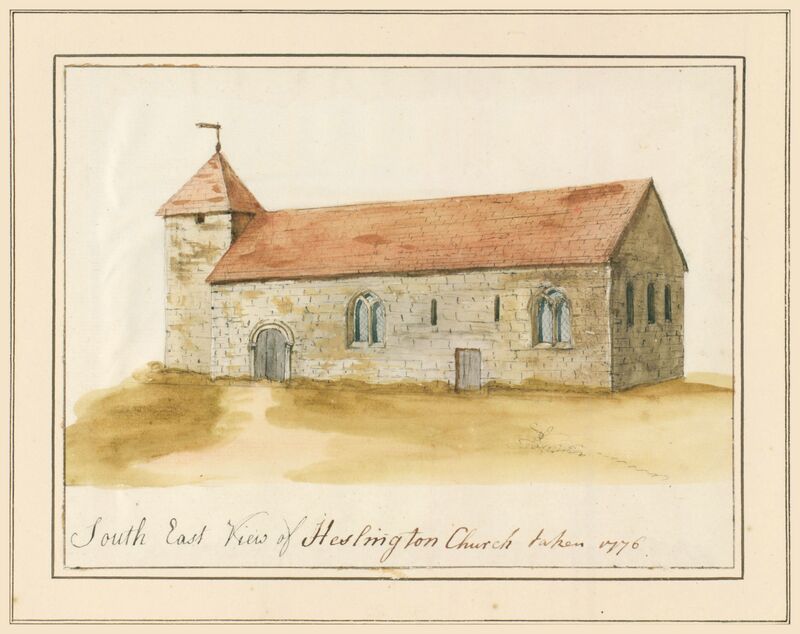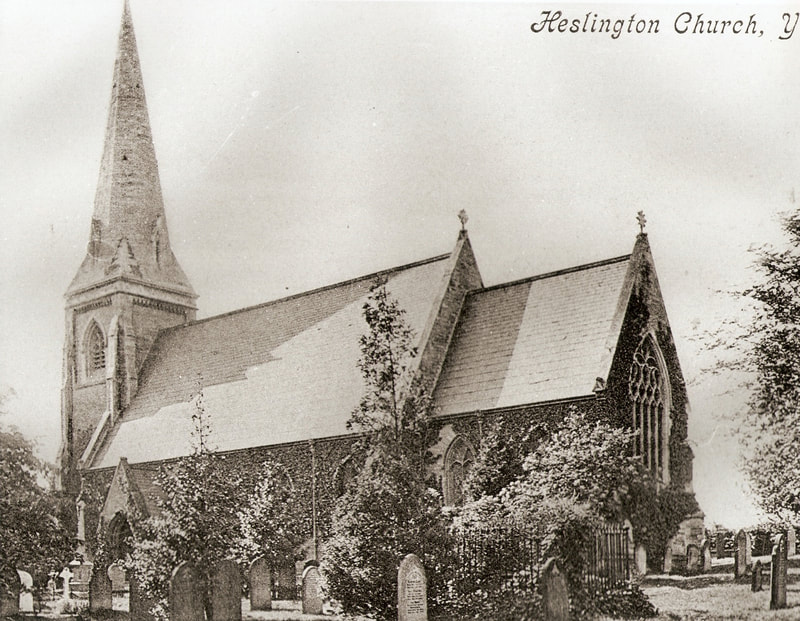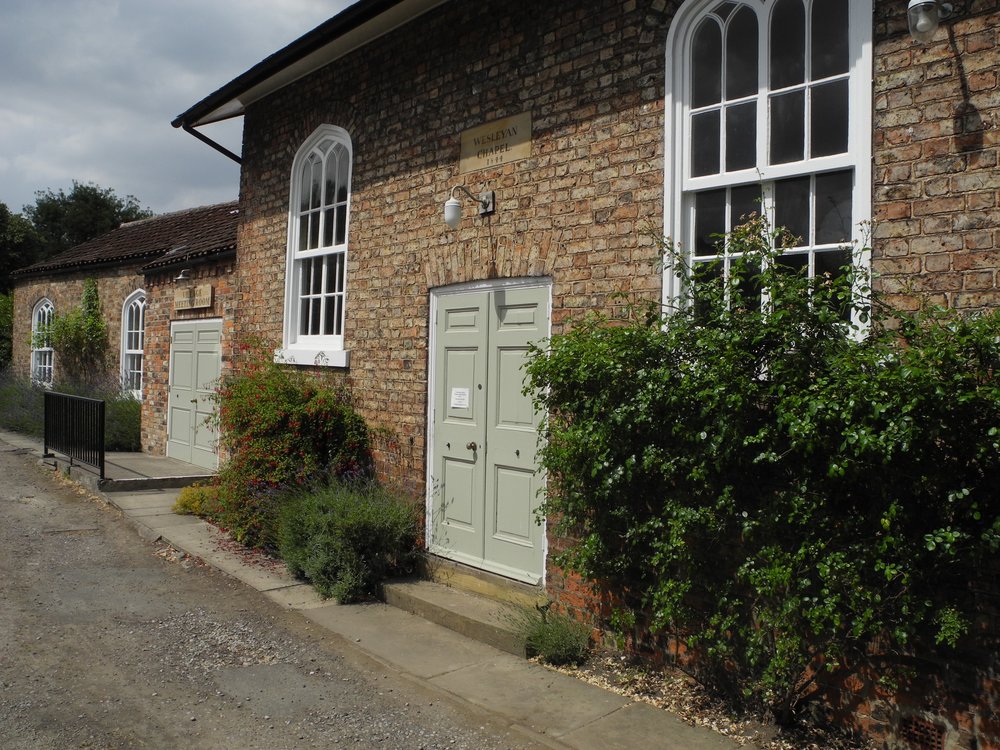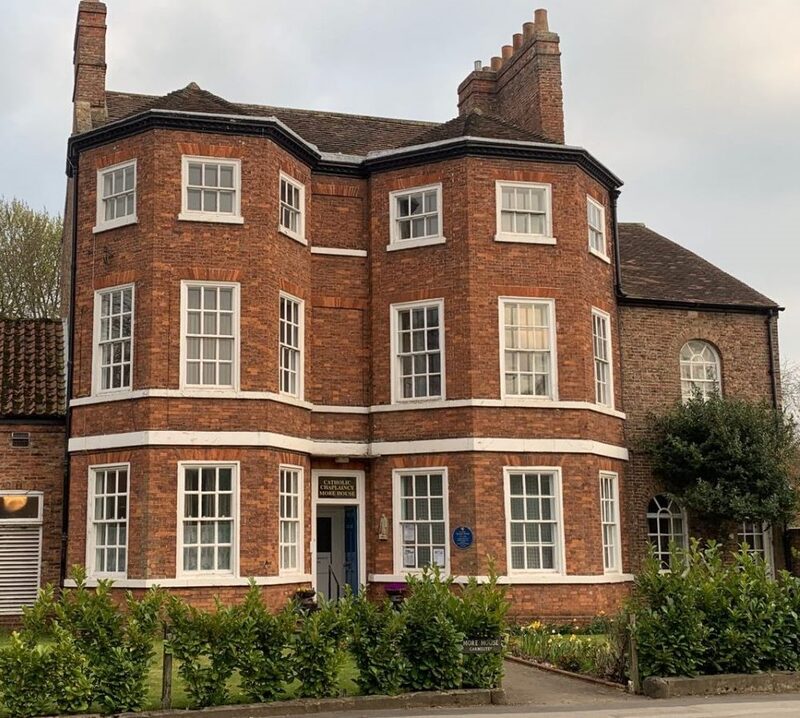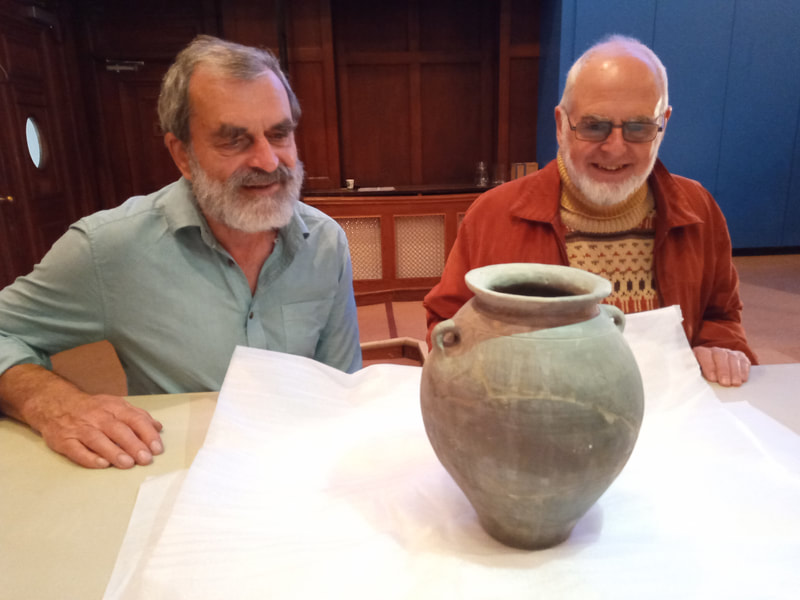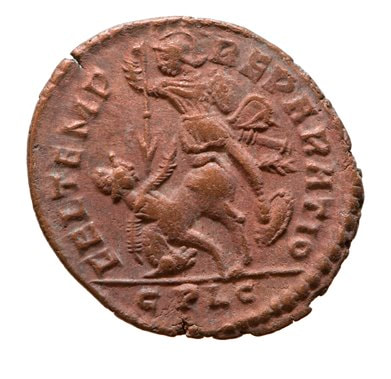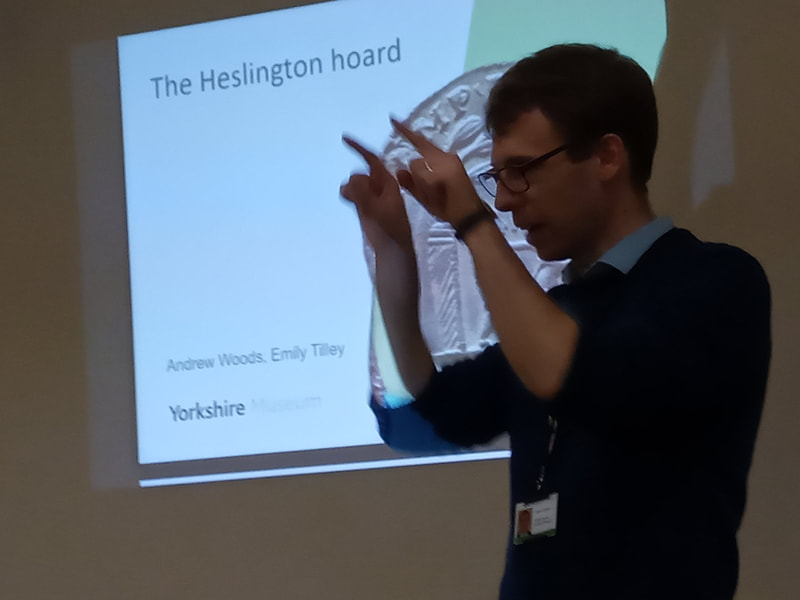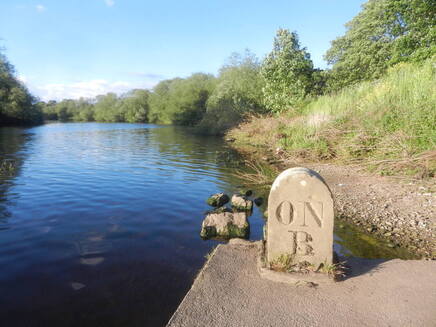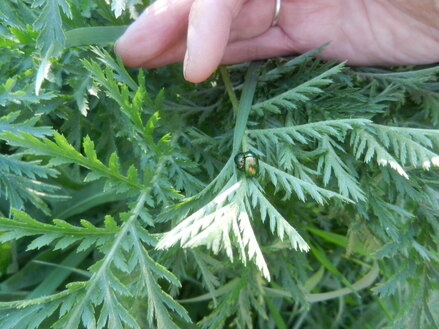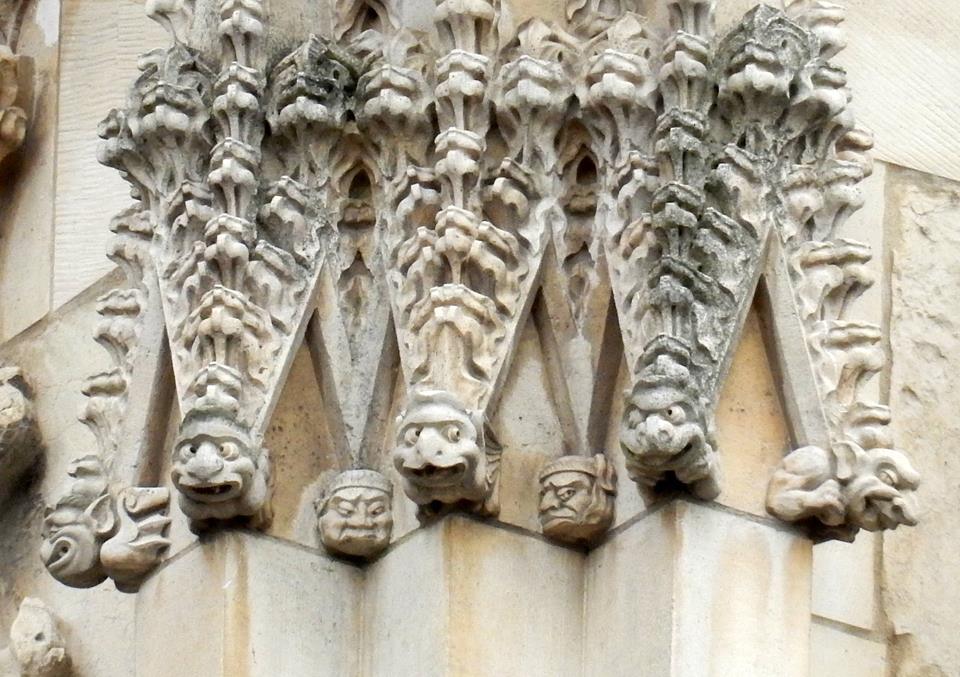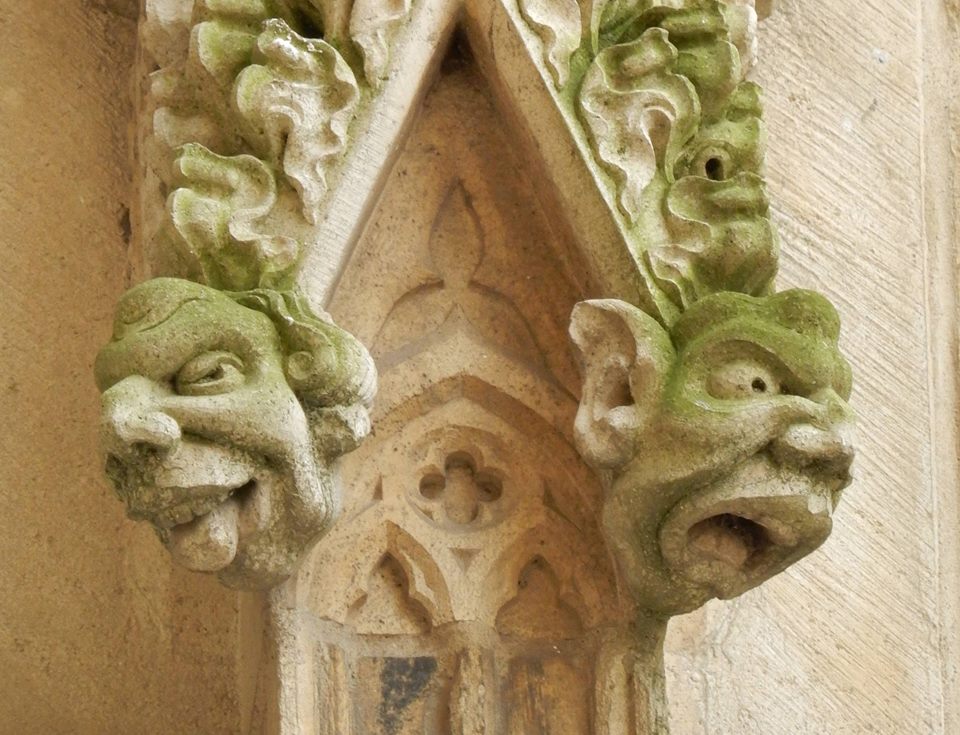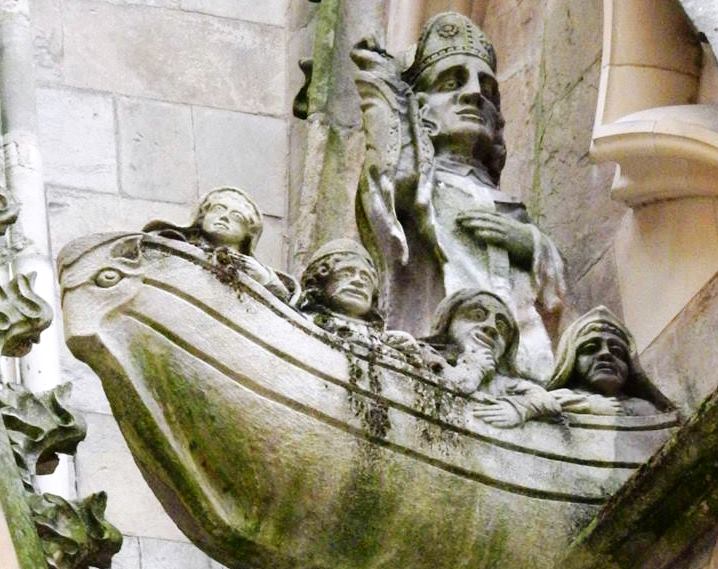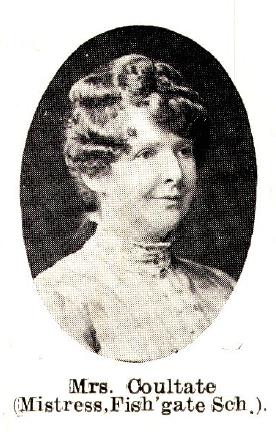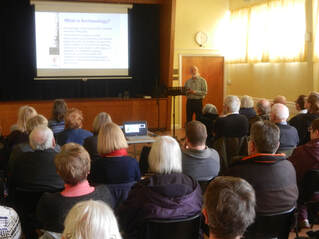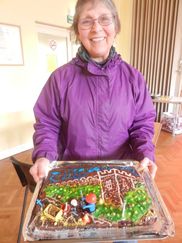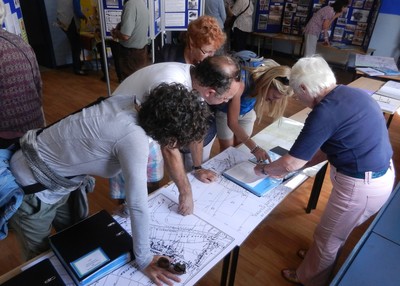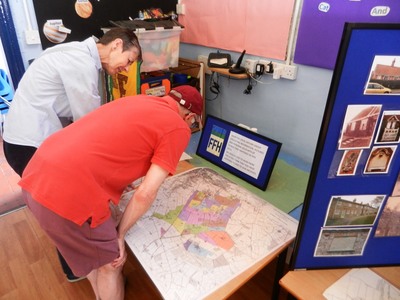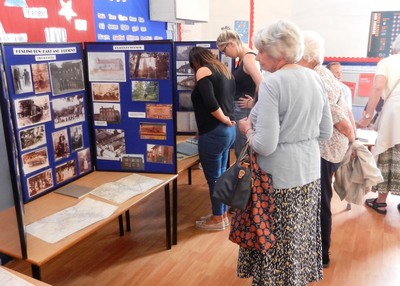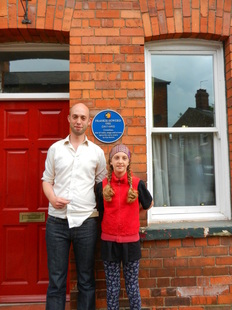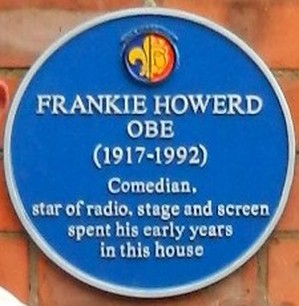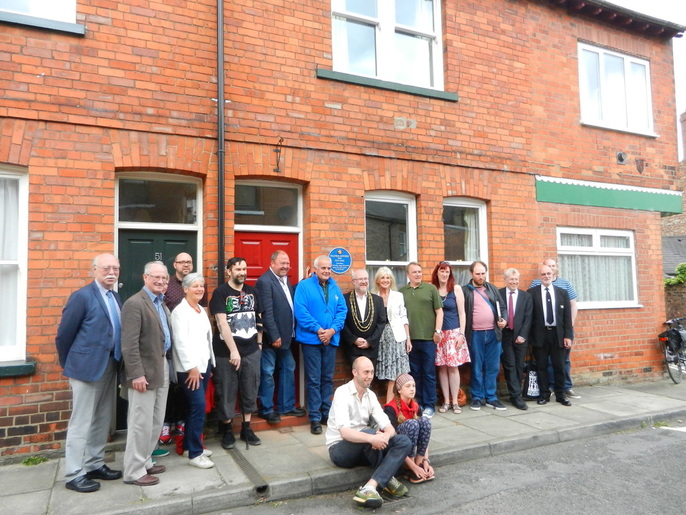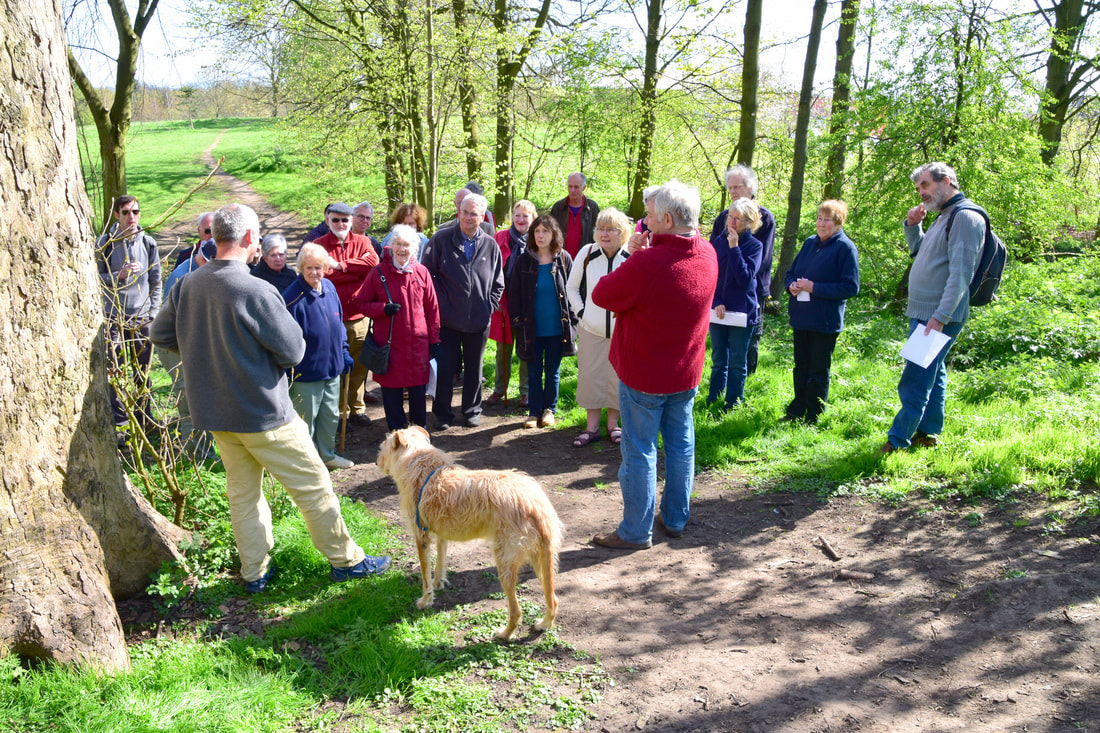Read about our past events
2024 Event Reports
 The Rowntree men. From the left; Joseph Seebohm Rowntree (son), Benjamin Seebohm Rowntree (son), Joseph Rowntree II, Arnold Stephenson Rowntree (nephew), Oscar Frederick Rowntree (son).
Image The Rowntree Society and the Joseph Rowntree Trust Collection
The Rowntree men. From the left; Joseph Seebohm Rowntree (son), Benjamin Seebohm Rowntree (son), Joseph Rowntree II, Arnold Stephenson Rowntree (nephew), Oscar Frederick Rowntree (son).
Image The Rowntree Society and the Joseph Rowntree Trust Collection
20 January- WHY ARE THE ROWNTREES STILL RELEVANT?
An illustrated talk by Sarah and Bill Sheils
‘History is not the study of the past – it’s the present’.
This quote of Arnold Rowntree, neatly encapsulates the life’s work of both these remarkable men. Learning from the past, studying the present and building a better future.
We had a full house of over 80 members and friends to hear the first occasion when Sarah and Bill Sheils have been on the same platform, giving stimulating and thought-provoking talks about these two significant and influential figures in the first half of 20th century.
The event comprised two talks; Bill spoke on one of the lesser-studied concerns of Benjamin Seebohm Rowntree; the workplace environment (a topic which has current relevance in the light of AI, the gig economy, and the increase in home working). He focused particularly on Seebohm's book, The Human Needs of Labour (1918), and the policies which he introduced into the company factory while Managing Director. Many of the principles he outlined in this book have since been adopted as good practice.
Sarah spoke about the work of Arnold Stephenson Rowntree, Seebohm's cousin, speaking on his role as York's M.P. between 1909 and 1918, including his difficulties in supporting Pacifism during the Great War, but also his advocacy of children's welfare, school meals, public transport and the importance of giving people information on matters such as Lloyd George's National Insurance proposals and Adult education.
Both Sarah and Bill also considered Seebohm and Arnold's national reputation and the lasting legacy of their work in the fabric of our society today.
Both speakers have kindly given FFH the text of their talks and some of their slides have been incorporated to provide illustration.
You can download Sarah Sheils talk on Arnold Rowntree HERE
You can download Bill Sheils talk on Seebohm Rowntree HERE
Bill Sheils is Professor Emeritus of History at the University of York and a specialist on the Reformation and its aftermath in Britain. He has also written on the history of York, an interest fostered many years ago by listing the papers of Seebohm Rowmtree, now held at the Borthwick Institute. He recently gave the Sheldon Memorial Lecture on another Quaker businessman, William Sessions, and his contribution to 20th century York.
Sarah Sheils taught history at the Mount School, The Open University and for the Continuing Education Department of York University. Many of these courses involved aspects of the history of York in the modern period. She has published histories of the Mount School and of the Yorkshire Philosophical Society, as well as other pieces about York and the Rowntrees, including the Sheldon Lecture on Arnold Rowntree which was later published in The York Historian.
An illustrated talk by Sarah and Bill Sheils
‘History is not the study of the past – it’s the present’.
This quote of Arnold Rowntree, neatly encapsulates the life’s work of both these remarkable men. Learning from the past, studying the present and building a better future.
We had a full house of over 80 members and friends to hear the first occasion when Sarah and Bill Sheils have been on the same platform, giving stimulating and thought-provoking talks about these two significant and influential figures in the first half of 20th century.
The event comprised two talks; Bill spoke on one of the lesser-studied concerns of Benjamin Seebohm Rowntree; the workplace environment (a topic which has current relevance in the light of AI, the gig economy, and the increase in home working). He focused particularly on Seebohm's book, The Human Needs of Labour (1918), and the policies which he introduced into the company factory while Managing Director. Many of the principles he outlined in this book have since been adopted as good practice.
Sarah spoke about the work of Arnold Stephenson Rowntree, Seebohm's cousin, speaking on his role as York's M.P. between 1909 and 1918, including his difficulties in supporting Pacifism during the Great War, but also his advocacy of children's welfare, school meals, public transport and the importance of giving people information on matters such as Lloyd George's National Insurance proposals and Adult education.
Both Sarah and Bill also considered Seebohm and Arnold's national reputation and the lasting legacy of their work in the fabric of our society today.
Both speakers have kindly given FFH the text of their talks and some of their slides have been incorporated to provide illustration.
You can download Sarah Sheils talk on Arnold Rowntree HERE
You can download Bill Sheils talk on Seebohm Rowntree HERE
Bill Sheils is Professor Emeritus of History at the University of York and a specialist on the Reformation and its aftermath in Britain. He has also written on the history of York, an interest fostered many years ago by listing the papers of Seebohm Rowmtree, now held at the Borthwick Institute. He recently gave the Sheldon Memorial Lecture on another Quaker businessman, William Sessions, and his contribution to 20th century York.
Sarah Sheils taught history at the Mount School, The Open University and for the Continuing Education Department of York University. Many of these courses involved aspects of the history of York in the modern period. She has published histories of the Mount School and of the Yorkshire Philosophical Society, as well as other pieces about York and the Rowntrees, including the Sheldon Lecture on Arnold Rowntree which was later published in The York Historian.
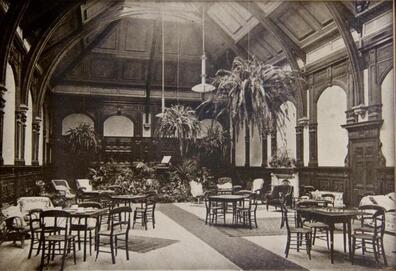 Bootham Park Hospital Recreation Hall. Image York Press
Bootham Park Hospital Recreation Hall. Image York Press
17 February
A HISTORY OF BOOTHAM PARK HOSPITAL
and the story behind its sudden closure
A talk by Ann Weerakoon.
An unusually large audience gathered for our 17th February 2024 talk about the history of York’s Bootham Park mental hospital, its sudden closure and current worries about the future of its historic buildings. Our speaker was Ann Weerakoon who for 10 years was Matron of Acute In-patient Care at Bootham Park Hospital, the culmination of a 42 year career in mental health services in York.
She described the creation of the hospital in the late 18th century, initially as the ‘York Lunatic Asylum’. It was a pioneering venture, preceding the York Retreat, at a time when only four such institutions already existed in Britain. As throughout Bootham Park’s history, great attention was paid to top quality physical fabric. Yorkshire’s celebrity architect, John Carr, was commissioned to design the palatial Palladian building. Alas, high quality buildings proved simpler to engineer than the high quality mental health care for which Bootham Park also aimed. By the end of the 18th century the hospital faced severe criticism for mistreatment of a Quaker patient. This scandal led to Yorkshire Quakers creating the Retreat as an alternative.
But Bootham Park Hospital strove to improve itself. We heard about an energetic sequence of developments throughout the 19th century. Wards became decked with paintings, statuettes, plants, flowers, goldfish and caged singing birds. Innovations like gas lighting, mains water and water closets kept the hospital on the cutting edge of progress. From mid-19th century much spectacularly beautiful stained-glass, Minton tilework, and ornate plaster and woodwork was added to the interior, plus an attractive chapel. On the walls of the meeting hall, our speaker displayed photos of architectural detail from this splendid interior, worthy of a stately home or a grand hotel. Nor was it only the quality of the buildings which got praised. She pointed out that in 1909 two visiting American doctors had described Bootham Park Hospital as the most progressive institution in Europe.
In 1948 Bootham Park Hospital became part of the NHS. But by late 20th century mental hospital buildings of similar age were being systematically closed down all round Britain. This reflected a government plan to phase out large, remote, hard-to-staff, inward-looking institutions, which were seen as isolating patients from their communities. Bootham Park did not particularly fit this negative stereotype. It was fairly small and was located in the very heart of the community it served. We heard how County flower shows, school sports and club cricket took place in the hospital’s grounds, softening the divide between hospital and community.
However in September 2015 Bootham Park Hospital was suddenly ordered to close within five days, as unsafe and unfit. We heard about various questionable aspects of that decision and the failure of NHS bodies to co-ordinate with each other. Much had been made of the need for repairs to the building; yet this had long been recognised and repairs promised but they had not been completed. Some of the audience came away wondering whether problems with the building were simply a pretext for a closure which NHS managers were seeking anyway out of dislike for buildings as old as Bootham Park.
The extraordinary suddenness of closure meant a long gap before York again had in-patient mental health wards which were as close to patients’ homes as was previously provided by Bootham Park Hospital. Some audience members recalled news reports from the moment of the closure that half the patients receiving acute in-patient care were simply sent home, while a smaller number were sent to hospital beds in Middlesborough, 50 miles away.
The talk ended on the question of what now may happen to the Bootham Park building. We heard how Early Retirement Living had obtained York Council permission to demolish parts of it but then abandoned their plan to use the site. No plan now existed for the building, parts of which are Grade One Listed. Despite repeated questions, no information has been received about the whereabouts of antique furnishings which were donated to Bootham Park Hospital and were on its premises at the time of closure.
Our speaker noted the worrying possibility that the building might be left unused and without maintenance until its decay is used to justify its demolition and the lucrative subsequent use of the choice empty site. She urged audience members who belonged to organisations like York Civic Trust, Historic England and the Georgian Society to engage these bodies to lobby on behalf of this important heritage building.
Ann Weerakoon has kindly given FFH a copy of her talk which you can download HERE
You can read a Guardian article about the closure HERE
A HISTORY OF BOOTHAM PARK HOSPITAL
and the story behind its sudden closure
A talk by Ann Weerakoon.
An unusually large audience gathered for our 17th February 2024 talk about the history of York’s Bootham Park mental hospital, its sudden closure and current worries about the future of its historic buildings. Our speaker was Ann Weerakoon who for 10 years was Matron of Acute In-patient Care at Bootham Park Hospital, the culmination of a 42 year career in mental health services in York.
She described the creation of the hospital in the late 18th century, initially as the ‘York Lunatic Asylum’. It was a pioneering venture, preceding the York Retreat, at a time when only four such institutions already existed in Britain. As throughout Bootham Park’s history, great attention was paid to top quality physical fabric. Yorkshire’s celebrity architect, John Carr, was commissioned to design the palatial Palladian building. Alas, high quality buildings proved simpler to engineer than the high quality mental health care for which Bootham Park also aimed. By the end of the 18th century the hospital faced severe criticism for mistreatment of a Quaker patient. This scandal led to Yorkshire Quakers creating the Retreat as an alternative.
But Bootham Park Hospital strove to improve itself. We heard about an energetic sequence of developments throughout the 19th century. Wards became decked with paintings, statuettes, plants, flowers, goldfish and caged singing birds. Innovations like gas lighting, mains water and water closets kept the hospital on the cutting edge of progress. From mid-19th century much spectacularly beautiful stained-glass, Minton tilework, and ornate plaster and woodwork was added to the interior, plus an attractive chapel. On the walls of the meeting hall, our speaker displayed photos of architectural detail from this splendid interior, worthy of a stately home or a grand hotel. Nor was it only the quality of the buildings which got praised. She pointed out that in 1909 two visiting American doctors had described Bootham Park Hospital as the most progressive institution in Europe.
In 1948 Bootham Park Hospital became part of the NHS. But by late 20th century mental hospital buildings of similar age were being systematically closed down all round Britain. This reflected a government plan to phase out large, remote, hard-to-staff, inward-looking institutions, which were seen as isolating patients from their communities. Bootham Park did not particularly fit this negative stereotype. It was fairly small and was located in the very heart of the community it served. We heard how County flower shows, school sports and club cricket took place in the hospital’s grounds, softening the divide between hospital and community.
However in September 2015 Bootham Park Hospital was suddenly ordered to close within five days, as unsafe and unfit. We heard about various questionable aspects of that decision and the failure of NHS bodies to co-ordinate with each other. Much had been made of the need for repairs to the building; yet this had long been recognised and repairs promised but they had not been completed. Some of the audience came away wondering whether problems with the building were simply a pretext for a closure which NHS managers were seeking anyway out of dislike for buildings as old as Bootham Park.
The extraordinary suddenness of closure meant a long gap before York again had in-patient mental health wards which were as close to patients’ homes as was previously provided by Bootham Park Hospital. Some audience members recalled news reports from the moment of the closure that half the patients receiving acute in-patient care were simply sent home, while a smaller number were sent to hospital beds in Middlesborough, 50 miles away.
The talk ended on the question of what now may happen to the Bootham Park building. We heard how Early Retirement Living had obtained York Council permission to demolish parts of it but then abandoned their plan to use the site. No plan now existed for the building, parts of which are Grade One Listed. Despite repeated questions, no information has been received about the whereabouts of antique furnishings which were donated to Bootham Park Hospital and were on its premises at the time of closure.
Our speaker noted the worrying possibility that the building might be left unused and without maintenance until its decay is used to justify its demolition and the lucrative subsequent use of the choice empty site. She urged audience members who belonged to organisations like York Civic Trust, Historic England and the Georgian Society to engage these bodies to lobby on behalf of this important heritage building.
Ann Weerakoon has kindly given FFH a copy of her talk which you can download HERE
You can read a Guardian article about the closure HERE
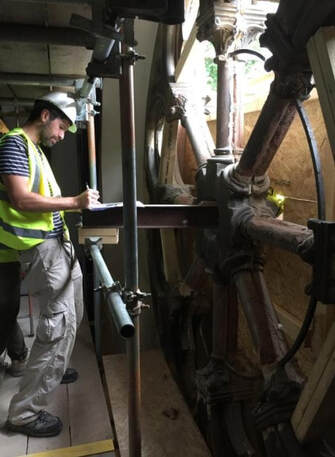 Repaiting the Rose Window at St Oswald's Church, Fulford.
Image: Ian Hayton
Repaiting the Rose Window at St Oswald's Church, Fulford.
Image: Ian Hayton
16 March - Our Annual General Meeting
Followed by Ian Hayton on the Role and Activities of a Conservation Architect
Our Annual General Meeting was cheerfully led by our Chair, Louise Wheatley. One member wrote to Louise afterwards saying it was “the most comprehensive and clear AGM I have ever attended…..I love coming to the meetings, everyone is so friendly…”
Two new members were elected to the Steering Committee, Glennis Whyte and Pat Hill, joining Barbara King, Judy Nicholson, Lauren Grindley, Peter Mott, Terry Court, Margaret Scott, Charles Padmore, Chris Rainger and Louise Wheatley. Louise was re-elected Chair and Peter as Treasurer. Andrew Scott was reappointed to scrutinise the annual accounts.
Louise had already sent her colourfully illustrated Annual Report (READ IT HERE) to the membership and she briefly mentioned some past and forthcoming events in this year’s programme. As Membership Secretary, she reported that we had 99 members by the turn of the year.
Peter explained the annual accounts and confirmed that our finances are in a healthy state thanks to the entry fees at our events, and the generosity of our members and friends.
Chris encouraged members to look at the website to see the new pages and articles, many of which have links to more information about the subject. Many of our speakers have kindly given a copy of their presentation to add to the website. You can read Chris’s website and facebook report HERE
After a short break for refreshments and much conversation, we reconvened to hear Ian Hayton describe the role of a Conservation Architect.
Ian Hayton is an award winning Architect with Ferrey & Mennnim the well respected York practice founded in 1922. He is the Environmental Advisor to the York Diocesan Advisory Committee for C of E churches (which is somewhat like local authority planning and building control) and an Inspecting Architect for the York, Leeds and Sheffield Dioceses.
In this role, he was responsible for the recent repairs to St Oswald's church.
Ian began with a slide showing the stunning view from the tower of St Mary’s Church, Scarborough, saying that the weather vane had fallen off and he had to work out how to put it back! Exploring amazing ancient buildings and discovering parts not usually accessible to the public is one of the many exciting aspects of his job.
The practice he works for describe themselves as ‘York based conservation, residential and ecclesiastical architects, passionately committed to conserving and enhancing historic buildings and a contemporary, timeless architecture’. As well as being inspecting architects for 232 churches in the York, Sheffield, Leeds and Lincoln Dioceses, they also have responsibility for Kirkwall Cathedral, Hull Minster, Guild Halls, Museums and a number of country houses.
Architects are often the first - and last - people involved in a scheme, working with the client to define what they want to do, be it a new build or repairs to an old structure, and seeing the project through to a happy conclusion. Ian said he works with a range of specialists, such as structural and M&E engineers, drawing up designs and estimates, preparing contracts and tenders, making planning applications, and managing the construction process to ensure the client’s brief is delivered.
Conservation architects are usually working with existing buildings, sometimes of great age and heritage significance, and it can be difficult to discover the cause of a problem (often water penetration) and devise an appropriate and cost-effective solution. The project will sometimes include designing improvements to other parts of the building, such as installing toilets, kitchens, or adding new buildings. All the work will need to respect the heritage value of the building, but that requires the value to be properly understood. Sometimes it is evident because of the historical significance, but aesthetic significance can be trickier to judge and there may also be commercial or practical constraints.
Ian illustrated some of these issues with slides of the Robert Fitzroy Academy in Croydon, where the designs required different treatments for the various buildings depending on their heritage value. Another project Ian discussed was Hereford Museum and Gallery, where as well as major internal changes, care was needed when adding an additional storey to the roof, so as not to spoil views of this very significant landmark building.
Returning to the Yorkshire churches for which he is responsible, Ian explained that as well as needing planning permission, the church authorities also have to be consulted and give permission through the Faculty process. Most churches have been in continuous use by the local community for hundreds of years and have special spiritual as well as aesthetic significance, so changes can have a different impact compared to other buildings.
Ian ended by giving an example of how well-meaning changes can have unanticipated consequences, such as the conversion of the footpath outside St Oswald’s church into a shared cycleway. This brought cyclists into proximity with the sharp-topped railings and concern has been growing of a possible serious injury. The railings are an interesting design and date from construction of the church so there has been much discussion with city planners and church authorities over the level of risk and possible solution. In the end, it all came down to agreeing the size of balls to cover the spikes!
You can see Ian's Presentation, including the view from St Mary's church, Scarborough HERE
Followed by Ian Hayton on the Role and Activities of a Conservation Architect
Our Annual General Meeting was cheerfully led by our Chair, Louise Wheatley. One member wrote to Louise afterwards saying it was “the most comprehensive and clear AGM I have ever attended…..I love coming to the meetings, everyone is so friendly…”
Two new members were elected to the Steering Committee, Glennis Whyte and Pat Hill, joining Barbara King, Judy Nicholson, Lauren Grindley, Peter Mott, Terry Court, Margaret Scott, Charles Padmore, Chris Rainger and Louise Wheatley. Louise was re-elected Chair and Peter as Treasurer. Andrew Scott was reappointed to scrutinise the annual accounts.
Louise had already sent her colourfully illustrated Annual Report (READ IT HERE) to the membership and she briefly mentioned some past and forthcoming events in this year’s programme. As Membership Secretary, she reported that we had 99 members by the turn of the year.
Peter explained the annual accounts and confirmed that our finances are in a healthy state thanks to the entry fees at our events, and the generosity of our members and friends.
Chris encouraged members to look at the website to see the new pages and articles, many of which have links to more information about the subject. Many of our speakers have kindly given a copy of their presentation to add to the website. You can read Chris’s website and facebook report HERE
After a short break for refreshments and much conversation, we reconvened to hear Ian Hayton describe the role of a Conservation Architect.
Ian Hayton is an award winning Architect with Ferrey & Mennnim the well respected York practice founded in 1922. He is the Environmental Advisor to the York Diocesan Advisory Committee for C of E churches (which is somewhat like local authority planning and building control) and an Inspecting Architect for the York, Leeds and Sheffield Dioceses.
In this role, he was responsible for the recent repairs to St Oswald's church.
Ian began with a slide showing the stunning view from the tower of St Mary’s Church, Scarborough, saying that the weather vane had fallen off and he had to work out how to put it back! Exploring amazing ancient buildings and discovering parts not usually accessible to the public is one of the many exciting aspects of his job.
The practice he works for describe themselves as ‘York based conservation, residential and ecclesiastical architects, passionately committed to conserving and enhancing historic buildings and a contemporary, timeless architecture’. As well as being inspecting architects for 232 churches in the York, Sheffield, Leeds and Lincoln Dioceses, they also have responsibility for Kirkwall Cathedral, Hull Minster, Guild Halls, Museums and a number of country houses.
Architects are often the first - and last - people involved in a scheme, working with the client to define what they want to do, be it a new build or repairs to an old structure, and seeing the project through to a happy conclusion. Ian said he works with a range of specialists, such as structural and M&E engineers, drawing up designs and estimates, preparing contracts and tenders, making planning applications, and managing the construction process to ensure the client’s brief is delivered.
Conservation architects are usually working with existing buildings, sometimes of great age and heritage significance, and it can be difficult to discover the cause of a problem (often water penetration) and devise an appropriate and cost-effective solution. The project will sometimes include designing improvements to other parts of the building, such as installing toilets, kitchens, or adding new buildings. All the work will need to respect the heritage value of the building, but that requires the value to be properly understood. Sometimes it is evident because of the historical significance, but aesthetic significance can be trickier to judge and there may also be commercial or practical constraints.
Ian illustrated some of these issues with slides of the Robert Fitzroy Academy in Croydon, where the designs required different treatments for the various buildings depending on their heritage value. Another project Ian discussed was Hereford Museum and Gallery, where as well as major internal changes, care was needed when adding an additional storey to the roof, so as not to spoil views of this very significant landmark building.
Returning to the Yorkshire churches for which he is responsible, Ian explained that as well as needing planning permission, the church authorities also have to be consulted and give permission through the Faculty process. Most churches have been in continuous use by the local community for hundreds of years and have special spiritual as well as aesthetic significance, so changes can have a different impact compared to other buildings.
Ian ended by giving an example of how well-meaning changes can have unanticipated consequences, such as the conversion of the footpath outside St Oswald’s church into a shared cycleway. This brought cyclists into proximity with the sharp-topped railings and concern has been growing of a possible serious injury. The railings are an interesting design and date from construction of the church so there has been much discussion with city planners and church authorities over the level of risk and possible solution. In the end, it all came down to agreeing the size of balls to cover the spikes!
You can see Ian's Presentation, including the view from St Mary's church, Scarborough HERE
 Map showing Japanese advance in red. Image: Wikipedia
Map showing Japanese advance in red. Image: Wikipedia
30 April - The Battle of Kohima April-June 1944
An illustrated talk by Bob White, Curator of the Kohima Museum, Imphal Barracks, York
80 years ago, England was full of soldiers and their equipment preparing for D-Day, but in northern Burma, Japanese soldiers were tramping through jungle on their way to invade India. Their aim was to cut off British supplies to Chiang Kai-shek’s army of resistance to the Japanese occupation of China. If they could take control of the British military bases at Dimapur, Imphal and Kohima in the north-east of India, the Japanese would be able to stop supplies to China and also open the way to invade India. They didn’t succeed - but at dreadful cost to all combatants.
Our speaker, Bob White, gave a detailed and gripping account of the ferocious resistance of the small British garrison and Indian army soldiers who fought tenaciously and withstood a two week siege at Kohima, against overwhelming odds, until reinforcements arrived and the Japanese were eventually pushed back. You can download Bob's presentation HERE
Dimapur had airfields and rail connections and was 130 miles by road from Imphal, where Allied IV Corps was based. In between, the road was dominated by the steep-sided and thickly-wooded Kohima Ridge. There were minimal defences at Kohima as the terrain was thought impassable for large units coming through the jungle-covered mountains from Japanese-occupied Burma.
But on March 15th, Japanese 31st Division set off for Kohima, 120 miles away, with mules & elephants carrying their equipment, but no motor vehicles.
When news reached the Allied Headquarters, British & Indian troops, equipment and pack animals, were air-lifted to Dimapur, with the 4th Battalion Royal West Kents reaching Kohima, on 4th April. The first Japanese arrived the same day, after the 1st Assam Regt and 3rd Assam Rifles had fought heroically to slow this Japanese advance guard.
It is estimated that Lieutenant General Sato had some 15,000 – 20,000 battle-hardened Japanese troops, with light artillery. Such was the Japanese confidence in their campaign, their soldiers only had rations for the 20 days it took to reach Kohima. The plan was that they would quickly over-run the British and Indian defenders and capture their supplies.
On 6th April, Transport Ridge & Jail Hill were stormed by the Japanese and the defenders were overwhelmed, suffering some 200 casualties. These positions allowed Japanese to overlook adjacent Allied positions, who found themselves under constant fire from artillery and mortars. Snipers watched for movement and shot at anyone who broke cover.
On 8th April, Sato was ordered to press on to Dimapur, but the High Command countermanded this order, completely undermining the strategy. This decision ended the ‘March on Delhi’ and put the whole mission in jeopardy.
As the siege progressed, the Allies attempted to supply the Kohima garrison by air, but most parachutes missed their target and were gathered by grateful Japanese soldiers, who dubbed them “Churchill rations”.
At north-east tip of ridge, Japanese were dug in just 20 yards from British, close enough to be constantly exchanging hand grenades. Many attacks came under cover of darkness, and there were repeated waves of frontal assaults. When the Japanese broke through into Allied trenches, there was savage hand-to-hand fighting.
By 10th April, 75th Indian Field Ambulance was caring for some 200 casualties, resting in shallow trenches on Garrison Hill. Two 6 feet deep pits were used as makeshift operating theatres, one had a timber roof, the other canvas and lit by hurricane lamps. But on 13th April, the operating pits took 4 direct hits, killing 21, including 2 doctors.
Relief was on its way. The British 2nd Division Commanded by Major General John Grover, travelled 2,000 miles across India by rail and reached Dimapur between April 1st and 11th. And on 18th April, 1/1 Punjab & 2 Division arrived at Kohima bringing tanks and lorries to rescue over 600 wounded. Snipers and shells caused more casualties during the evacuation of wounded. Of the 446 West Kents who arrived on 4th April, 278 were dead or wounded.
The new troops began to push the Japanese off the Kohima Ridge. They were well dug in and fought tenaciously, despite dwindling food and munitions, but with the help of tanks, the Allies overwhelmed the Japanese positions and machine gun nests.
On 30th April, General Sato signalled to the Japanese High Command “31 Division at limit of endurance”. But they clung on until 15th May, when they began to fall back from the Kohima ridge. On 1st June, Sato asked for permission to withdraw, but was refused.
He messaged again on 4th June with this poignant message “Our swords are broken and our arrows spent. Shedding bitter tears, I now leave Kohima”. Even so, the Japanese fought a series of delaying actions to slow the Allied advance and it took until 22nd June for the Durham Light Infantry to meet up with the 5th Indian Division and re-open the road to Imphal.
The Japanese dream of capturing north ease India had failed at a dreadful cost, with many dying of starvation and disease on the retreat. Of the 65,000 combatant troops who had invaded India in March, 81% were casualties, some 30,000 killed and 23,000 wounded. Only 600 Japanese were taken prisoner. Allied British and Indian losses were 4,064 men, dead, missing and wounded.
The battles of Kohima & Imphal were decisive defeats for the Japanese, destroying their 15th Army. Burma. Earl Mountbatten, Supreme Commander South East Asia, described Kohima as ‘probably one of the greatest battles in history’.
In 1984, Japanese veterans of the battle came to York and laid wreaths in a moving ceremony of reconciliation at the memorial in Minster gardens.
On the Saturday after Bob’s talk, FFH members were kindly invited to visit the Kohima museum in Imphal Barracks. The museum is open to the public on Thursday mornings between 9am and 12.15pm. Check with the museum website and phone to confirm your visiting arrangements: HERE
Note: Fulford Army Barracks was named Imphal Barracks & not Kohima Barracks, because the British 2nd Division remained overseas after WW2 & only returned to York in 1983. The West Yorkshire Regiment was back much sooner & they had fought at the Battle of Imphal.
An illustrated talk by Bob White, Curator of the Kohima Museum, Imphal Barracks, York
80 years ago, England was full of soldiers and their equipment preparing for D-Day, but in northern Burma, Japanese soldiers were tramping through jungle on their way to invade India. Their aim was to cut off British supplies to Chiang Kai-shek’s army of resistance to the Japanese occupation of China. If they could take control of the British military bases at Dimapur, Imphal and Kohima in the north-east of India, the Japanese would be able to stop supplies to China and also open the way to invade India. They didn’t succeed - but at dreadful cost to all combatants.
Our speaker, Bob White, gave a detailed and gripping account of the ferocious resistance of the small British garrison and Indian army soldiers who fought tenaciously and withstood a two week siege at Kohima, against overwhelming odds, until reinforcements arrived and the Japanese were eventually pushed back. You can download Bob's presentation HERE
Dimapur had airfields and rail connections and was 130 miles by road from Imphal, where Allied IV Corps was based. In between, the road was dominated by the steep-sided and thickly-wooded Kohima Ridge. There were minimal defences at Kohima as the terrain was thought impassable for large units coming through the jungle-covered mountains from Japanese-occupied Burma.
But on March 15th, Japanese 31st Division set off for Kohima, 120 miles away, with mules & elephants carrying their equipment, but no motor vehicles.
When news reached the Allied Headquarters, British & Indian troops, equipment and pack animals, were air-lifted to Dimapur, with the 4th Battalion Royal West Kents reaching Kohima, on 4th April. The first Japanese arrived the same day, after the 1st Assam Regt and 3rd Assam Rifles had fought heroically to slow this Japanese advance guard.
It is estimated that Lieutenant General Sato had some 15,000 – 20,000 battle-hardened Japanese troops, with light artillery. Such was the Japanese confidence in their campaign, their soldiers only had rations for the 20 days it took to reach Kohima. The plan was that they would quickly over-run the British and Indian defenders and capture their supplies.
On 6th April, Transport Ridge & Jail Hill were stormed by the Japanese and the defenders were overwhelmed, suffering some 200 casualties. These positions allowed Japanese to overlook adjacent Allied positions, who found themselves under constant fire from artillery and mortars. Snipers watched for movement and shot at anyone who broke cover.
On 8th April, Sato was ordered to press on to Dimapur, but the High Command countermanded this order, completely undermining the strategy. This decision ended the ‘March on Delhi’ and put the whole mission in jeopardy.
As the siege progressed, the Allies attempted to supply the Kohima garrison by air, but most parachutes missed their target and were gathered by grateful Japanese soldiers, who dubbed them “Churchill rations”.
At north-east tip of ridge, Japanese were dug in just 20 yards from British, close enough to be constantly exchanging hand grenades. Many attacks came under cover of darkness, and there were repeated waves of frontal assaults. When the Japanese broke through into Allied trenches, there was savage hand-to-hand fighting.
By 10th April, 75th Indian Field Ambulance was caring for some 200 casualties, resting in shallow trenches on Garrison Hill. Two 6 feet deep pits were used as makeshift operating theatres, one had a timber roof, the other canvas and lit by hurricane lamps. But on 13th April, the operating pits took 4 direct hits, killing 21, including 2 doctors.
Relief was on its way. The British 2nd Division Commanded by Major General John Grover, travelled 2,000 miles across India by rail and reached Dimapur between April 1st and 11th. And on 18th April, 1/1 Punjab & 2 Division arrived at Kohima bringing tanks and lorries to rescue over 600 wounded. Snipers and shells caused more casualties during the evacuation of wounded. Of the 446 West Kents who arrived on 4th April, 278 were dead or wounded.
The new troops began to push the Japanese off the Kohima Ridge. They were well dug in and fought tenaciously, despite dwindling food and munitions, but with the help of tanks, the Allies overwhelmed the Japanese positions and machine gun nests.
On 30th April, General Sato signalled to the Japanese High Command “31 Division at limit of endurance”. But they clung on until 15th May, when they began to fall back from the Kohima ridge. On 1st June, Sato asked for permission to withdraw, but was refused.
He messaged again on 4th June with this poignant message “Our swords are broken and our arrows spent. Shedding bitter tears, I now leave Kohima”. Even so, the Japanese fought a series of delaying actions to slow the Allied advance and it took until 22nd June for the Durham Light Infantry to meet up with the 5th Indian Division and re-open the road to Imphal.
The Japanese dream of capturing north ease India had failed at a dreadful cost, with many dying of starvation and disease on the retreat. Of the 65,000 combatant troops who had invaded India in March, 81% were casualties, some 30,000 killed and 23,000 wounded. Only 600 Japanese were taken prisoner. Allied British and Indian losses were 4,064 men, dead, missing and wounded.
The battles of Kohima & Imphal were decisive defeats for the Japanese, destroying their 15th Army. Burma. Earl Mountbatten, Supreme Commander South East Asia, described Kohima as ‘probably one of the greatest battles in history’.
In 1984, Japanese veterans of the battle came to York and laid wreaths in a moving ceremony of reconciliation at the memorial in Minster gardens.
On the Saturday after Bob’s talk, FFH members were kindly invited to visit the Kohima museum in Imphal Barracks. The museum is open to the public on Thursday mornings between 9am and 12.15pm. Check with the museum website and phone to confirm your visiting arrangements: HERE
Note: Fulford Army Barracks was named Imphal Barracks & not Kohima Barracks, because the British 2nd Division remained overseas after WW2 & only returned to York in 1983. The West Yorkshire Regiment was back much sooner & they had fought at the Battle of Imphal.
11 May - A YORKSHIRE FOLK PARK AT FULFORD INGS:
A DREAM WHICH NEARLY CAME TRUE
Dr Sally-Anne Shearn, Borthwick Institute for Archives, University of York
A DREAM WHICH NEARLY CAME TRUE
Dr Sally-Anne Shearn, Borthwick Institute for Archives, University of York
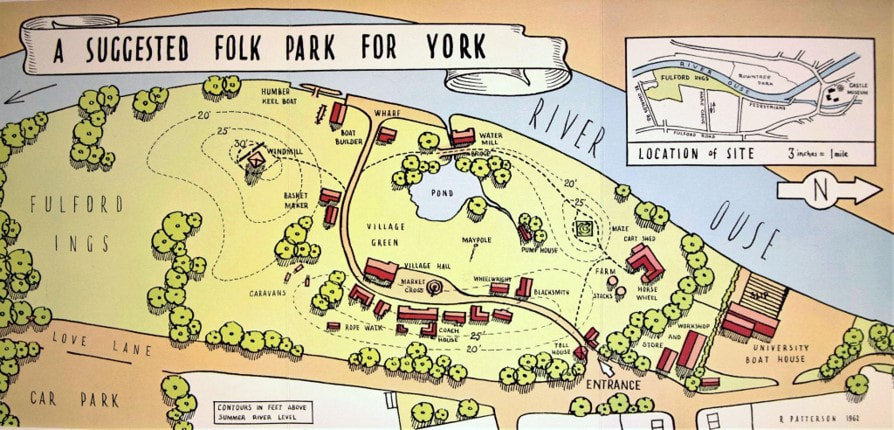 J.B. Morrell's 1962 Christmas Card Illustrating his design for a Folk Park on Fulford Ings. Image: Borthwick Institute
J.B. Morrell's 1962 Christmas Card Illustrating his design for a Folk Park on Fulford Ings. Image: Borthwick Institute
 Skansen Folk Museum, Stockholm, Sweden. Image: Wikimedia Commons
Skansen Folk Museum, Stockholm, Sweden. Image: Wikimedia Commons
Sally-Anne Shearn gave us the most fascinating talk about something that never happened! Along the way, we met J.B. Morrell, one of those big figures in the history of York, who doesn’t seem to have an equivalent today. Sally-Anne became interested in this project in 2022 when her work cataloguing the large archive of the Joseph Rowntree Reform Trust uncovered a bulging file labelled ‘York Folk Park’, which told the story of Morrell’s attempt to create a living museum of rural life in 1960s York as a sister attraction to the popular York Castle Museum.
The origins of the York Folk Park do not lie in Yorkshire at all, but in Sweden, where the first ‘Folk Park’ was created in 1891 at Skansen in Stockholm. In a century of extremely rapid change, Skansen was created to preserve evidence of a pre-industrial Swedish way of life before it was lost forever. The term ‘folk’ in this context refers to the customs and culture of ordinary working people, whose homes, material possessions, crafts and stories were less likely to be preserved than those of the wealthy, and therefore far more at risk of disappearing.
The methods used to assemble the park were novel for the time, its founder Artur Hazelius travelled around the country, buying some 150 houses which he then had carefully dismantled and shipped to Stockholm to be rebuilt in the large park as authentic representations of historic Sweden. All of the buildings were opened to the public and the park showcased traditional crafts, clothing, and furnishings, along with the buildings themselves, in both country and small town settings. The park proved enormously popular and another Swedish example was created at Lund in1892, followed by a Norwegian open air museum in 1902, the Old Town museum in Denmark in 1914, and the The Netherlands Open Air Museum which opened at Arnhem in 1918.
The idea soon caught on in Britain too, where the history of the ordinary and the pre-industrial began to be given greater prominence in regional museums. By the 1930s Hereford Museum had an ‘old country life’ section with dairy churns and smocks highlighting the region’s farming history, Northampton Central Museum had a reconstructed cobbler’s shop to demonstrate the region’s history of shoemaking, and York had Kirkgate at the Castle Museum, with its replica Victorian street showcasing a mix of 19th century trades and crafts, all of which had been drawn from the local area. In the 1950s Frank Atkinson, Director of Halifax Museums and the man who’d later create Beamish Open Air Museum, spent years collecting and photographing materials and skills used by craftsmen in South and West Yorkshire, seeking to preserve what he called the evidence of the mundane, grubby and everyday.
The Folk Park or open air museum offered an ideal way to combine these elements, creating a lost world in microcosm, made up of buildings and artefacts that had been preserved, relocated and rebuilt so that visitors could more authentically experience - in so much as that was possible - how people lived and worked in the past. As Iorwerth Peate said when he opened the Museum of Welsh Life in Cardiff in the 1940s, the task was not to create a museum which preserved the dead past under glass, but one which used the past to link up with the present, highlighting the continuity in a time of rapid and dramatic change.
The origins of the York Folk Park do not lie in Yorkshire at all, but in Sweden, where the first ‘Folk Park’ was created in 1891 at Skansen in Stockholm. In a century of extremely rapid change, Skansen was created to preserve evidence of a pre-industrial Swedish way of life before it was lost forever. The term ‘folk’ in this context refers to the customs and culture of ordinary working people, whose homes, material possessions, crafts and stories were less likely to be preserved than those of the wealthy, and therefore far more at risk of disappearing.
The methods used to assemble the park were novel for the time, its founder Artur Hazelius travelled around the country, buying some 150 houses which he then had carefully dismantled and shipped to Stockholm to be rebuilt in the large park as authentic representations of historic Sweden. All of the buildings were opened to the public and the park showcased traditional crafts, clothing, and furnishings, along with the buildings themselves, in both country and small town settings. The park proved enormously popular and another Swedish example was created at Lund in1892, followed by a Norwegian open air museum in 1902, the Old Town museum in Denmark in 1914, and the The Netherlands Open Air Museum which opened at Arnhem in 1918.
The idea soon caught on in Britain too, where the history of the ordinary and the pre-industrial began to be given greater prominence in regional museums. By the 1930s Hereford Museum had an ‘old country life’ section with dairy churns and smocks highlighting the region’s farming history, Northampton Central Museum had a reconstructed cobbler’s shop to demonstrate the region’s history of shoemaking, and York had Kirkgate at the Castle Museum, with its replica Victorian street showcasing a mix of 19th century trades and crafts, all of which had been drawn from the local area. In the 1950s Frank Atkinson, Director of Halifax Museums and the man who’d later create Beamish Open Air Museum, spent years collecting and photographing materials and skills used by craftsmen in South and West Yorkshire, seeking to preserve what he called the evidence of the mundane, grubby and everyday.
The Folk Park or open air museum offered an ideal way to combine these elements, creating a lost world in microcosm, made up of buildings and artefacts that had been preserved, relocated and rebuilt so that visitors could more authentically experience - in so much as that was possible - how people lived and worked in the past. As Iorwerth Peate said when he opened the Museum of Welsh Life in Cardiff in the 1940s, the task was not to create a museum which preserved the dead past under glass, but one which used the past to link up with the present, highlighting the continuity in a time of rapid and dramatic change.
 John Bowes Morrell 1873-1963. Image Borthwick Institute
John Bowes Morrell 1873-1963. Image Borthwick Institute
For J.B. Morrell, the Folk Park filled an obvious gap. In the 1930s he had helped Dr John Kirk turn his collection of historic artefacts, or ‘bygones’, into the hugely successful York Castle Museum, but this was, Morrell wrote later, an illustration mainly of city life, telling only half of the story. He was aware that the Castle Museum was already in possession of, or had been offered a number of buildings it could not re-erect and display in its central York location, including a watermill and two timber houses. A Folk Park would allow these to be rebuilt and displayed to the public in an authentic setting, capturing a rural way of life before it was lost forever.
The earliest surviving document setting out his vision for a folk park is dated November 1956 and it shows that the title of ‘Yorkshire’ or ‘York’ folk park is a bit of a misnomer, because what Morrell was envisaging was actually an English Folk Park that just happened to be based in York. In the memorandum, he argues that folk materials, that is the mundane items which exemplify the history of ordinary people, had only recently begun to be given the prominence which their importance and interest deserve.
It was not enough however to merely display them in cases in museums. The setting should be as authentic as the buildings and objects themselves. Even the best museums, he wrote, are of necessity limited in their scope and in the aspects of the past that they can illustrate. To see life in the round as our ancestors lived it needed something more - a reconstruction of their homes in surroundings as like as possible to those they knew.
The memorandum goes on to say that there were still, throughout England, fine examples of old watermills and windmills, small town dwellings, workshops, country cottages, farmsteads, barns and other such buildings which were just as historically important as the great mansions. But every year saw more and more of them falling into ruin or being demolished to make way for new housing estates and other schemes. Unless an attempt was made to preserve them, in a very short time they would nearly all have disappeared.
The earliest surviving document setting out his vision for a folk park is dated November 1956 and it shows that the title of ‘Yorkshire’ or ‘York’ folk park is a bit of a misnomer, because what Morrell was envisaging was actually an English Folk Park that just happened to be based in York. In the memorandum, he argues that folk materials, that is the mundane items which exemplify the history of ordinary people, had only recently begun to be given the prominence which their importance and interest deserve.
It was not enough however to merely display them in cases in museums. The setting should be as authentic as the buildings and objects themselves. Even the best museums, he wrote, are of necessity limited in their scope and in the aspects of the past that they can illustrate. To see life in the round as our ancestors lived it needed something more - a reconstruction of their homes in surroundings as like as possible to those they knew.
The memorandum goes on to say that there were still, throughout England, fine examples of old watermills and windmills, small town dwellings, workshops, country cottages, farmsteads, barns and other such buildings which were just as historically important as the great mansions. But every year saw more and more of them falling into ruin or being demolished to make way for new housing estates and other schemes. Unless an attempt was made to preserve them, in a very short time they would nearly all have disappeared.

The site Morrell has in mind is the Heslington Hall estate, which in 1955 had been put up for auction by its owners, the Deramore family. Morrell stepped in swiftly to purchase it through the Joseph Rowntree Reform Trust, of which he was a Director, for the sum of £10,500. In his 1956 memorandum, Morrell wrote that the estate would provide ample room for a park, which he felt would need at least fifteen or more acres, with room for further expansion.
Heslington Hall offered all of this and more. The main house would provide accommodation for a library, exhibition and lecture room, offices, workshops, stores, a flat for a caretaker and even a restaurant, whilst the existing 18th century gazebo and orangery in the grounds could also be incorporated into the park, along with its fine collection of 16th century Yew trees and kitchen and flower gardens. He imagines the gardens planted with appropriate English flowers and shrubs, together with a small herb garden, while the small stream running to the lake would make an ideal setting for the old Water Mill.
Beyond the Hall he imagined a village of small cottages, shops and workshops showing different periods and styles of architecture, each appropriately furnished. There would be a smithy, wheelwright and joiner, a weaver, rope maker, potter and other crafts that once flourished in small communities. Alongside these would be an inn and brew house, a church and school, and one or two shops. All of these would be grouped, along with houses and cottages, around a village green on which could be staged open air plays, archery displays, morris dancing and other games, sports and pastimes. The shops would sell their own commodities and old craftsmen could ply their trade in the various workshops. At a distance from the central village, the estate offered space for farm buildings, a windmill and what he called other typical features of the countryside.
To better capture his vision for the park, he had a small booklet printed through the York Civic Trust the following year, setting out his argument and showing two detailed illustrations of the proposed layout.
The process of making this dream a reality was, however, slow. In 1956 the Joseph Rowntree Reform Trust began considering Morrell’s plan for the Heslington estate and in 1957 the York Civic Trust and York Corporation’s Castle Museum Committee both expressed themselves in favour of it, but there was still much discussion over costs and who would launch and who would maintain such a park. Initially it was intended that the York Civic Trust should launch the park and the City Corporation would maintain it. The Corporation was still in the process of negotiating its take over of York’s Museum Gardens, however, so Morrell felt the Folk Park plan should wait until this had been completed.
In the meantime, plans for the creation of a University of York were underway and it was this which ultimately put pay to the plan for a Heslington Folk Park. The university scheme, of which Morrell was a major supporter, urgently needed a large site close to the city and the Heslington estate proved too ideal to pass up. It was Morrell himself who in a 1959 meeting of the Trust, proposed the transfer of the land to the new university, once its creation was certain. Government approval was finally given in 1960 and in 1962 the Reform Trust formally transferred the Heslington estate to the new University of York.
Heslington Hall offered all of this and more. The main house would provide accommodation for a library, exhibition and lecture room, offices, workshops, stores, a flat for a caretaker and even a restaurant, whilst the existing 18th century gazebo and orangery in the grounds could also be incorporated into the park, along with its fine collection of 16th century Yew trees and kitchen and flower gardens. He imagines the gardens planted with appropriate English flowers and shrubs, together with a small herb garden, while the small stream running to the lake would make an ideal setting for the old Water Mill.
Beyond the Hall he imagined a village of small cottages, shops and workshops showing different periods and styles of architecture, each appropriately furnished. There would be a smithy, wheelwright and joiner, a weaver, rope maker, potter and other crafts that once flourished in small communities. Alongside these would be an inn and brew house, a church and school, and one or two shops. All of these would be grouped, along with houses and cottages, around a village green on which could be staged open air plays, archery displays, morris dancing and other games, sports and pastimes. The shops would sell their own commodities and old craftsmen could ply their trade in the various workshops. At a distance from the central village, the estate offered space for farm buildings, a windmill and what he called other typical features of the countryside.
To better capture his vision for the park, he had a small booklet printed through the York Civic Trust the following year, setting out his argument and showing two detailed illustrations of the proposed layout.
The process of making this dream a reality was, however, slow. In 1956 the Joseph Rowntree Reform Trust began considering Morrell’s plan for the Heslington estate and in 1957 the York Civic Trust and York Corporation’s Castle Museum Committee both expressed themselves in favour of it, but there was still much discussion over costs and who would launch and who would maintain such a park. Initially it was intended that the York Civic Trust should launch the park and the City Corporation would maintain it. The Corporation was still in the process of negotiating its take over of York’s Museum Gardens, however, so Morrell felt the Folk Park plan should wait until this had been completed.
In the meantime, plans for the creation of a University of York were underway and it was this which ultimately put pay to the plan for a Heslington Folk Park. The university scheme, of which Morrell was a major supporter, urgently needed a large site close to the city and the Heslington estate proved too ideal to pass up. It was Morrell himself who in a 1959 meeting of the Trust, proposed the transfer of the land to the new university, once its creation was certain. Government approval was finally given in 1960 and in 1962 the Reform Trust formally transferred the Heslington estate to the new University of York.
 Final plan for the Folk Park on Fulford Ings published in the Yorkshire Evening Press, 9 February 1962. Image: Evening Press
Final plan for the Folk Park on Fulford Ings published in the Yorkshire Evening Press, 9 February 1962. Image: Evening Press
With the Heslington site gone, Morrell was now on the look out for a new location for his Folk Park. He soon lit upon an area of land at Fulford to the south of the city which was already owned by York Corporation and which had, conveniently, already been raised above flood level. So keen was Morrell on this new site, that he had Mr Patterson, the Curator of the Castle Museum, create a coloured plan for it and he turned this plan into his Christmas card for 1962, giving an idea of how the Folk Park might look and what it might include. (see the illustration at the top of this report).
Morrell described this park as showing the evolution of the English way of life in village and country during the past 500 years. In a new memorandum setting out his revised plan, he wrote that the village green would be available for open air plays, folk singing and dancing and traditional country games. It would be the site of the village cross, the pound, a well and a maypole, as well as a replica of the Troy Town maze near Terrington. As at Heslington, the park would include the post mill, water mill, and horse mill that had already been donated or purchased. There would also be a village inn, a blacksmiths, wheelwrights, boat builder and Romany encampment, with workshops showing traditional crafts and industries in action.
The new site also allowed for some exciting changes however. The riverside location would allow visitors to be brought by boat direct to the park’s own landing stage, and the wharf could be used to display historic vessels like the Humber barge, a canal boat, and a coracle. Fulford also had a disused parish church, St Oswalds, that Morrell thought could easily be incorporated into the folk village, showcasing its religious and ritual life.
J.B. Morrell celebrated his 90th birthday in April 1963 but died less than two weeks later. Although he had not succeeded in achieving his dream of a folk park in his lifetime, Morrell had left the plan on a secure footing, having found a site, secured initial funding, and made an approach to the city council, and his family were keen to see his campaign succeed. Following his death, his son William Bowes Morrell took up the baton, taking his father’s place on the York Castle Museums Committee and continuing to campaign for the park for the next 17 years.
Progress remained slow, but in February 1972 the plan for a 30 acre folk park was finally approved in principle by the council’s York Castle Museum Committee, for consideration by the Finance and Planning Committee. W.B. Morrell made sure it made the front page of the Press, claiming that the park might be ready to open to the public as soon as eight to ten buildings had been erected, which would take perhaps six years in all, including a full year to prepare the site.
While the Corporation committees were deliberating, an article appeared in the Yorkshire Evening Press included the last known illustration of the Yorkshire Folk Park. It shows the full extent of the park, stretching from the end of the New Walk right across to St Oswald’s Road and including the old church of St Oswald. All the features of the 1962 plan are there - the village, the caravans, the windmill and farm, but there are additions too. There’s a small manor house now, a pinfold, well, and pigeon cote, as well as practical additions like toilets, refreshment huts, picnic areas, offices, a caretakers house, and storage shed.
Sadly, this proved to be the closest the scheme ever came to reality. Based on the documents in the file the plan stalled and then ultimately was abandoned for a number of reasons, but mainly the escalating cost. In November 1975 the Chief Executive of York City Council wrote to W.B. Morrell to say that the Council had, reluctantly, had to abandon the Folk Park project.
The idea limped on for a few more years, with various ideas put forward to try and keep the essence of the folk park scheme alive. The entire scheme, from Morrell’s initial memorandum to the final failure of the project, lasted just over twenty years and leaves us with many ‘what ifs’. Ultimately it seems to have been a case of the wrong place and the wrong time, but the fact that the scheme was put forward at all speaks to a very real concern about what was being lost, as well as gained, in the rapid progress of the twentieth century, and the importance of the ordinary and the everyday in our understanding not just of the past, but also of the present and how we came to be where we are.
Sally-Anne Shearn has very kindly given FFH her presentation and script which tells the story in greater detail and includes further information on the buildings which were intended to be included in the park.
You can download her presentation HERE
Morrell described this park as showing the evolution of the English way of life in village and country during the past 500 years. In a new memorandum setting out his revised plan, he wrote that the village green would be available for open air plays, folk singing and dancing and traditional country games. It would be the site of the village cross, the pound, a well and a maypole, as well as a replica of the Troy Town maze near Terrington. As at Heslington, the park would include the post mill, water mill, and horse mill that had already been donated or purchased. There would also be a village inn, a blacksmiths, wheelwrights, boat builder and Romany encampment, with workshops showing traditional crafts and industries in action.
The new site also allowed for some exciting changes however. The riverside location would allow visitors to be brought by boat direct to the park’s own landing stage, and the wharf could be used to display historic vessels like the Humber barge, a canal boat, and a coracle. Fulford also had a disused parish church, St Oswalds, that Morrell thought could easily be incorporated into the folk village, showcasing its religious and ritual life.
J.B. Morrell celebrated his 90th birthday in April 1963 but died less than two weeks later. Although he had not succeeded in achieving his dream of a folk park in his lifetime, Morrell had left the plan on a secure footing, having found a site, secured initial funding, and made an approach to the city council, and his family were keen to see his campaign succeed. Following his death, his son William Bowes Morrell took up the baton, taking his father’s place on the York Castle Museums Committee and continuing to campaign for the park for the next 17 years.
Progress remained slow, but in February 1972 the plan for a 30 acre folk park was finally approved in principle by the council’s York Castle Museum Committee, for consideration by the Finance and Planning Committee. W.B. Morrell made sure it made the front page of the Press, claiming that the park might be ready to open to the public as soon as eight to ten buildings had been erected, which would take perhaps six years in all, including a full year to prepare the site.
While the Corporation committees were deliberating, an article appeared in the Yorkshire Evening Press included the last known illustration of the Yorkshire Folk Park. It shows the full extent of the park, stretching from the end of the New Walk right across to St Oswald’s Road and including the old church of St Oswald. All the features of the 1962 plan are there - the village, the caravans, the windmill and farm, but there are additions too. There’s a small manor house now, a pinfold, well, and pigeon cote, as well as practical additions like toilets, refreshment huts, picnic areas, offices, a caretakers house, and storage shed.
Sadly, this proved to be the closest the scheme ever came to reality. Based on the documents in the file the plan stalled and then ultimately was abandoned for a number of reasons, but mainly the escalating cost. In November 1975 the Chief Executive of York City Council wrote to W.B. Morrell to say that the Council had, reluctantly, had to abandon the Folk Park project.
The idea limped on for a few more years, with various ideas put forward to try and keep the essence of the folk park scheme alive. The entire scheme, from Morrell’s initial memorandum to the final failure of the project, lasted just over twenty years and leaves us with many ‘what ifs’. Ultimately it seems to have been a case of the wrong place and the wrong time, but the fact that the scheme was put forward at all speaks to a very real concern about what was being lost, as well as gained, in the rapid progress of the twentieth century, and the importance of the ordinary and the everyday in our understanding not just of the past, but also of the present and how we came to be where we are.
Sally-Anne Shearn has very kindly given FFH her presentation and script which tells the story in greater detail and includes further information on the buildings which were intended to be included in the park.
You can download her presentation HERE
 Aerial View the archaeological excavations on the site of the former Rialto Cinema, latterly MECCA Bingo. Image York Archaeology
Aerial View the archaeological excavations on the site of the former Rialto Cinema, latterly MECCA Bingo. Image York Archaeology
8 June – OUR FESTIVAL OF IDEAS EVENT 40 YEARS OF EXPLORING FISHERGATE'S AMAZING ARCHAEOLOGY
A review of the 2023 Rialto excavations in the context of Fewster Way, Blue Bridge Lane and Fishergate House
Illustrated talks by Ian Milsted and Lucy Johnson of York Archaeology
Almost 10 years to the day after we held our first Festival of Ideas conference on Anglian Fishergate and Pre-Viking York, more than 70 people filled the hall to hear two excellent talks:
Lucy Johnson gave the first presentation on last year's excavations on the site of the former Rialto Cinema, and Ian Milsted showed how these latest investigations built on the 1985 excavations at what is now Fewster Way, and in 2001 on both sides of Blue Bridge Lane, greatly increasing the way we understand the history of our city.
Ian began by reminding the audience of the first excavations on part of the former Glassworks site in Fewster Way, where York Archaeology found the largest Anglian site in York. Evidence of timber buildings and boundary ditches demonstrated that the area had been deliberately laid out between the river Foss and the former Roman Road (now Fawcett Street). Finds in the many rubbish pits and elsewhere gave evidence of craft working and trade with the Low Countries. This site was found to have been cleared and re-established after the Viking take-over of the city, with occupation continuing into the Anglo-Scandinavian period when the first timber church of St Andrew was built. The church was rebuilt in stone after the Norman Conquest, and in 1202 it was incorporated into the new Gilbertine Priory. Much to the delight of our audience, Ian and Lucy brought along the superbly detailed model of the priory after its reconstruction in the 14th century, with its church, refectory, dormitories and cloisters forming a neat square.
You can see Ian's presentation slides HERE
You can download copies of the reports on the 1985 investigation from the Yorkshire Archaeology digital archive HERE
You can read the really thorough and interesting FAS report on these excavations HERE
A review of the 2023 Rialto excavations in the context of Fewster Way, Blue Bridge Lane and Fishergate House
Illustrated talks by Ian Milsted and Lucy Johnson of York Archaeology
Almost 10 years to the day after we held our first Festival of Ideas conference on Anglian Fishergate and Pre-Viking York, more than 70 people filled the hall to hear two excellent talks:
Lucy Johnson gave the first presentation on last year's excavations on the site of the former Rialto Cinema, and Ian Milsted showed how these latest investigations built on the 1985 excavations at what is now Fewster Way, and in 2001 on both sides of Blue Bridge Lane, greatly increasing the way we understand the history of our city.
Ian began by reminding the audience of the first excavations on part of the former Glassworks site in Fewster Way, where York Archaeology found the largest Anglian site in York. Evidence of timber buildings and boundary ditches demonstrated that the area had been deliberately laid out between the river Foss and the former Roman Road (now Fawcett Street). Finds in the many rubbish pits and elsewhere gave evidence of craft working and trade with the Low Countries. This site was found to have been cleared and re-established after the Viking take-over of the city, with occupation continuing into the Anglo-Scandinavian period when the first timber church of St Andrew was built. The church was rebuilt in stone after the Norman Conquest, and in 1202 it was incorporated into the new Gilbertine Priory. Much to the delight of our audience, Ian and Lucy brought along the superbly detailed model of the priory after its reconstruction in the 14th century, with its church, refectory, dormitories and cloisters forming a neat square.
You can see Ian's presentation slides HERE
You can download copies of the reports on the 1985 investigation from the Yorkshire Archaeology digital archive HERE
You can read the really thorough and interesting FAS report on these excavations HERE
A few years later, a land swap was negotiated between MECCA and Shepherd Construction, which had offices along Blue Bridge Lane, to demolish the former Rialto Cinema and adjacent buildings and build a new bingo hall and apartments. At the same time, Shepherd's also converted Fishergate House into apartments and built houses in the grounds. Archaeology undertaken during these works by Field Archaeology Specialists, found further evidence of Roman, Anglian and Medieval activity, and most significantly, the cemetery of the lost church of St Helen.
In a very unusual development, the MECCA bingo hall closed and was demolished in 2022 for the construction of a large block of student flats. This gave an exciting opportunity to close the gap between these earlier excavations by excavating the MECCA car park and parts of the bingo hall site which had not been investigated before.
Led by Lucy Johnson, York Archaeology toiled through the endless rain in the early winter of 2023, discovering more Anglian and Medieval material across the site and especially in the many rubbish pits. Partly because of the muddy conditions and also the time constraints, hundreds of plastic boxes were filled with carefully located material for sieving and analysis in the coming months. As well as small objects overlooked during excavation, the analysis will allow discovery and assessment of seeds, small bones and other items to give a better understanding of life of people living and working in Fishergate, their food and environment.
You can see Lucy's presentation slides HERE
Why not read our web-page on the Fishergate Ring, discovered c.1930 on the Glassworks site - HERE
To discover more visit our Fishergate Archaeology page HERE
A few years later, a land swap was negotiated between MECCA and Shepherd Construction, which had offices along Blue Bridge Lane, to demolish the former Rialto Cinema and adjacent buildings and build a new bingo hall and apartments. At the same time, Shepherd's also converted Fishergate House into apartments and built houses in the grounds. Archaeology undertaken during these works by Field Archaeology Specialists, found further evidence of Roman, Anglian and Medieval activity, and most significantly, the cemetery of the lost church of St Helen.
In a very unusual development, the MECCA bingo hall closed and was demolished in 2022 for the construction of a large block of student flats. This gave an exciting opportunity to close the gap between these earlier excavations by excavating the MECCA car park and parts of the bingo hall site which had not been investigated before.
Led by Lucy Johnson, York Archaeology toiled through the endless rain in the early winter of 2023, discovering more Anglian and Medieval material across the site and especially in the many rubbish pits. Partly because of the muddy conditions and also the time constraints, hundreds of plastic boxes were filled with carefully located material for sieving and analysis in the coming months. As well as small objects overlooked during excavation, the analysis will allow discovery and assessment of seeds, small bones and other items to give a better understanding of life of people living and working in Fishergate, their food and environment.
You can see Lucy's presentation slides HERE
Why not read our web-page on the Fishergate Ring, discovered c.1930 on the Glassworks site - HERE
To discover more visit our Fishergate Archaeology page HERE
2023 Event Reports
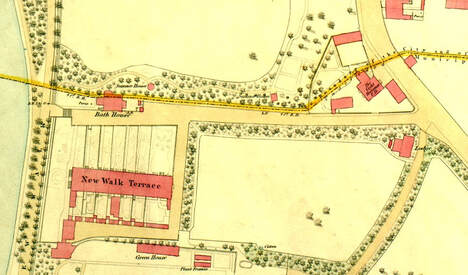
21 January
The Development of Lady Well Close - A Windmill, a wharf, a spring, a pub, speculative property development, and much more...!
We began the year with a beautifully illustrated talk by Dr Louise Wheatley about a subject very close to her heart - the history of the area where she has lived for over 40 years; New Walk Terrace, Fishergate.
Lady Well Close was a parcel of land between the river Ouse and Fulford Road, taking its name from the well (now lost) in the garden of the last house on the north side of New Walk Terrace, close to the steps down to the river bank. The ancient boundary of the city runs along the north side of the road and does a strange kink at the Lighthorseman, ensuring that this pub and its predecessors (perhaps a windmill and maybe a Pinfold too) were in Fulford.
Using fragments of information gleaned from a wide range of archives and other sources, Louise investigated why this 4 acre plot was so attractive to York's merchants, brewers (and their daughters!) haberdashers, linen drapers, booksellers (and their daughters too!) and some of York's prominent Aldermen.
The Development of Lady Well Close - A Windmill, a wharf, a spring, a pub, speculative property development, and much more...!
We began the year with a beautifully illustrated talk by Dr Louise Wheatley about a subject very close to her heart - the history of the area where she has lived for over 40 years; New Walk Terrace, Fishergate.
Lady Well Close was a parcel of land between the river Ouse and Fulford Road, taking its name from the well (now lost) in the garden of the last house on the north side of New Walk Terrace, close to the steps down to the river bank. The ancient boundary of the city runs along the north side of the road and does a strange kink at the Lighthorseman, ensuring that this pub and its predecessors (perhaps a windmill and maybe a Pinfold too) were in Fulford.
Using fragments of information gleaned from a wide range of archives and other sources, Louise investigated why this 4 acre plot was so attractive to York's merchants, brewers (and their daughters!) haberdashers, linen drapers, booksellers (and their daughters too!) and some of York's prominent Aldermen.
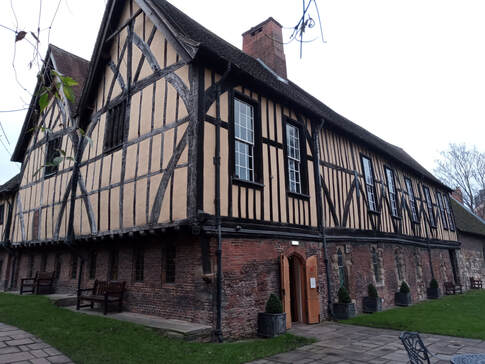
18 February
The Merchant Adventurers Hall, the story of who built it
An illustrated talk by Bob Hale
This magnificent guildhall was already over 220 years old when the Company of Merchant Adventurers inherited it in 1581. It had been built by the Fraternity of Our Lord Jesus Christ and the Most Blessed Virgin Mary, the oldest of perhaps half a dozen religious fraternities known in York before 1400, but the only one for which records survive. The astonishing scale of their ambition is shown by the huge size of the hall they set about constructing, 89 feet long, 40 feet wide, the lower storey of early brick, the upper storey timber-framed. It is half a century earlier in date than the Merchant Taylors’ hall in Aldwark, which was only two-thirds the size, as was the later St Anthony’s Hall in Peasholme Green. It is arguably the oldest, largest and finest of its kind in the country today.
Surviving title deeds tell us that the Fraternity of Jesus and Mary had been granted their site in Fossgate in December 1356. They were founded by royal licence the following March, admitting both men and women, principally but by no means exclusively from cloth and leather trades. It is thought they were prompted by the great pestilence of 1348-50, the Black Death, which had killed at least two-thirds and possibly as many as half of York’s population. Those spared God’s wrath, whilst resuming their occupations, were now intent on praying for the souls of the deceased in purgatory and performing charitable acts of mercy for those living but in need.
They started building their hall in June 1357 and appear to have finished in spring 1362. They established a ‘hospital’ (almshouse) in the undercroft, with their capacious meeting hall above. The chapel to the south was (as it still is) accessed from the undercroft, specifically so that the hospital inmates could see and hear mass sung from their beds.
Remarkably, as well as their deeds, early financial records survive too, five parchment rolls of receipts from named members and a paper account book running from 1357 to 1369. A third of this book’s pages list further receipts or pledges of money, and two-thirds record outgoings, of which 80% are building expenses. The years of the build list some 1600 separate items of expenditure, mainly materials and tools bought, such as timber, bricks and tiles, stone, sand, lime and plaster, picks and shovels, and the wages paid to the craftsmen, many of whom are also named. For example, John de Colwyk, master carpenter, got 3s a week, other carpenters or masons and bricklayers 2s 6d or 2s a week, labourers 1s or 1s 3d a week. Margaret the maid, the sole female employee named, also received 1s a week.
Trees, large and small, were sourced for as much as a mark, 13s 4d, or as little as 5½d. Nails cost from 3d to 5s 5d a thousand. They bought 20,000 bricks from near neighbours the Carmelite friars in Hungate for £6. Money was also spent each week on ale (small beer) for all the workmen employed. And on 15th August 1358, at the enormous cost of £7 9s 5½d, they celebrated their patronal day, the Assumption of the Blessed Virgin Mary, by a first lavish feast of porpoise and frumenty, herrings, 300 rolls of finest bread and 124 gallons of ale (1000 pints), to drink which they bought 300 wooden beakers.
These accounts, unparalleled in York, written in Latin, the customary language of record, throw light not only on post-Black Death wages and prices and food and drink (there are three further feasts, none of the four being previously published), but also on many aspects of ordinary life in York c.1360: the participation of women, who made up a quarter or a fifth of the membership; the scribes’ facility with words - Latin spelling, long standardised, had been learnt, but not that of the English or French words which appear occasionally for lack of a known Latin equivalent, and are written phonetically; and their probable use of the ‘long hundred’ of 120, made up of ten dozens, based on familiar multiples of 3 and 4, when, for instance, £21 was paid for centum (‘a hundred’) oaks at Thorpe Underwood, not at an unlikely 4s 2⅖d each (for 100) but surely at 3s 6d each (for 120).
There is ample material for the study of surname evolution: some 520 individuals are named. For example, Adam de Akome may or may not have come from Acomb himself, and Alice Glover may or may not have made or sold gloves – both may have inherited their names. Yet we can be sure that John Gregori, also called John filius Gregorii and then John Gregson (sic), all by the same scribe within a single month, really did have a father named Gregory, and ‘Gregson’ may be the first York instance of a ‘Robinson, Johnson’ type of surname.
On the other hand, many puzzles remain. Why did they unload timber at St Leonard’s Landing, a long way from Fossgate? What part of the hall were they building at any given time? – it is never clear. Who were the scribes? Why do the records stop in 1369? Above all, why build so large a hall? To the glory of God and the Virgin Mary?
Or is the clue in the 124 gallons of ale and 300 (or even 360?) bread rolls and beakers? (see the first feast records, below) Perhaps the members, who numbered five or six dozen each year, always intended to be joined in celebration by their families and friends.
The hospital was confirmed by a new licence in 1371 and continued in use until the fraternity was reconstituted as a new Guild of Mercers in 1430. The Mercers in turn were incorporated in 1581 as the Company of Merchant Adventurers of York, who thereby inherited Trinity Hall, Hospital and Chapel, as they had become known, and continued to administer all three (the hospital until about 1900, hall and chapel still today). Fortunately they also took possession of the archives, kept in an ancient wooden chest until recent times. Without these, none of the above story would be known.
Before the Merchant Adventurers: Building the Hall. Account book of the Fraternity of Jesus and Mary, York, 1357-69, The first ever full edition, was published by the Latin Project, York, in September 2021, price £10. ISBN 978-1-5272-9987-0.
To obtain a copy, please contact [email protected] or get in touch with FFH via our Contact Us page HERE
Here are some pages from the records. (click on the image to enlarge)
Left; 30 September 1357, accounts for one week's expenditure, mostly labour.
Centre and right; accounts for the first feast on 15 August 1358.
(Centre) Coals 18d; Porpoise 20s; Herrings (with carriage) 12s; Leavened bread 16s 2d; Flour 4s; Frumenty 12d;
(Right) Mayne bread (‘300’ rolls) 14s; Ale (124 gallons) 15s 6d; Wooden beakers (‘300’) 33s 9d (plus carriage 3d); Spices
& strainers 18s 8d; Wm de Whitby baker 9s; Strewings 4½d; Sauce 6d; Onions 4d; A cook’s wages 8d; 2 gallons of honey 16d;
Grand Total £7 9s 5½d (Compare the Master Carpenter John de Colwyk’s daily wage: 6d)
The Merchant Adventurers Hall, the story of who built it
An illustrated talk by Bob Hale
This magnificent guildhall was already over 220 years old when the Company of Merchant Adventurers inherited it in 1581. It had been built by the Fraternity of Our Lord Jesus Christ and the Most Blessed Virgin Mary, the oldest of perhaps half a dozen religious fraternities known in York before 1400, but the only one for which records survive. The astonishing scale of their ambition is shown by the huge size of the hall they set about constructing, 89 feet long, 40 feet wide, the lower storey of early brick, the upper storey timber-framed. It is half a century earlier in date than the Merchant Taylors’ hall in Aldwark, which was only two-thirds the size, as was the later St Anthony’s Hall in Peasholme Green. It is arguably the oldest, largest and finest of its kind in the country today.
Surviving title deeds tell us that the Fraternity of Jesus and Mary had been granted their site in Fossgate in December 1356. They were founded by royal licence the following March, admitting both men and women, principally but by no means exclusively from cloth and leather trades. It is thought they were prompted by the great pestilence of 1348-50, the Black Death, which had killed at least two-thirds and possibly as many as half of York’s population. Those spared God’s wrath, whilst resuming their occupations, were now intent on praying for the souls of the deceased in purgatory and performing charitable acts of mercy for those living but in need.
They started building their hall in June 1357 and appear to have finished in spring 1362. They established a ‘hospital’ (almshouse) in the undercroft, with their capacious meeting hall above. The chapel to the south was (as it still is) accessed from the undercroft, specifically so that the hospital inmates could see and hear mass sung from their beds.
Remarkably, as well as their deeds, early financial records survive too, five parchment rolls of receipts from named members and a paper account book running from 1357 to 1369. A third of this book’s pages list further receipts or pledges of money, and two-thirds record outgoings, of which 80% are building expenses. The years of the build list some 1600 separate items of expenditure, mainly materials and tools bought, such as timber, bricks and tiles, stone, sand, lime and plaster, picks and shovels, and the wages paid to the craftsmen, many of whom are also named. For example, John de Colwyk, master carpenter, got 3s a week, other carpenters or masons and bricklayers 2s 6d or 2s a week, labourers 1s or 1s 3d a week. Margaret the maid, the sole female employee named, also received 1s a week.
Trees, large and small, were sourced for as much as a mark, 13s 4d, or as little as 5½d. Nails cost from 3d to 5s 5d a thousand. They bought 20,000 bricks from near neighbours the Carmelite friars in Hungate for £6. Money was also spent each week on ale (small beer) for all the workmen employed. And on 15th August 1358, at the enormous cost of £7 9s 5½d, they celebrated their patronal day, the Assumption of the Blessed Virgin Mary, by a first lavish feast of porpoise and frumenty, herrings, 300 rolls of finest bread and 124 gallons of ale (1000 pints), to drink which they bought 300 wooden beakers.
These accounts, unparalleled in York, written in Latin, the customary language of record, throw light not only on post-Black Death wages and prices and food and drink (there are three further feasts, none of the four being previously published), but also on many aspects of ordinary life in York c.1360: the participation of women, who made up a quarter or a fifth of the membership; the scribes’ facility with words - Latin spelling, long standardised, had been learnt, but not that of the English or French words which appear occasionally for lack of a known Latin equivalent, and are written phonetically; and their probable use of the ‘long hundred’ of 120, made up of ten dozens, based on familiar multiples of 3 and 4, when, for instance, £21 was paid for centum (‘a hundred’) oaks at Thorpe Underwood, not at an unlikely 4s 2⅖d each (for 100) but surely at 3s 6d each (for 120).
There is ample material for the study of surname evolution: some 520 individuals are named. For example, Adam de Akome may or may not have come from Acomb himself, and Alice Glover may or may not have made or sold gloves – both may have inherited their names. Yet we can be sure that John Gregori, also called John filius Gregorii and then John Gregson (sic), all by the same scribe within a single month, really did have a father named Gregory, and ‘Gregson’ may be the first York instance of a ‘Robinson, Johnson’ type of surname.
On the other hand, many puzzles remain. Why did they unload timber at St Leonard’s Landing, a long way from Fossgate? What part of the hall were they building at any given time? – it is never clear. Who were the scribes? Why do the records stop in 1369? Above all, why build so large a hall? To the glory of God and the Virgin Mary?
Or is the clue in the 124 gallons of ale and 300 (or even 360?) bread rolls and beakers? (see the first feast records, below) Perhaps the members, who numbered five or six dozen each year, always intended to be joined in celebration by their families and friends.
The hospital was confirmed by a new licence in 1371 and continued in use until the fraternity was reconstituted as a new Guild of Mercers in 1430. The Mercers in turn were incorporated in 1581 as the Company of Merchant Adventurers of York, who thereby inherited Trinity Hall, Hospital and Chapel, as they had become known, and continued to administer all three (the hospital until about 1900, hall and chapel still today). Fortunately they also took possession of the archives, kept in an ancient wooden chest until recent times. Without these, none of the above story would be known.
Before the Merchant Adventurers: Building the Hall. Account book of the Fraternity of Jesus and Mary, York, 1357-69, The first ever full edition, was published by the Latin Project, York, in September 2021, price £10. ISBN 978-1-5272-9987-0.
To obtain a copy, please contact [email protected] or get in touch with FFH via our Contact Us page HERE
Here are some pages from the records. (click on the image to enlarge)
Left; 30 September 1357, accounts for one week's expenditure, mostly labour.
Centre and right; accounts for the first feast on 15 August 1358.
(Centre) Coals 18d; Porpoise 20s; Herrings (with carriage) 12s; Leavened bread 16s 2d; Flour 4s; Frumenty 12d;
(Right) Mayne bread (‘300’ rolls) 14s; Ale (124 gallons) 15s 6d; Wooden beakers (‘300’) 33s 9d (plus carriage 3d); Spices
& strainers 18s 8d; Wm de Whitby baker 9s; Strewings 4½d; Sauce 6d; Onions 4d; A cook’s wages 8d; 2 gallons of honey 16d;
Grand Total £7 9s 5½d (Compare the Master Carpenter John de Colwyk’s daily wage: 6d)
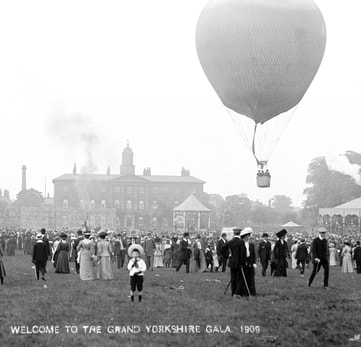
18 March - Our Annual General Meeting + Life in York 100 Years Ago -
An Illustrated talk on photographs from the Hanstock Collection by Ian Drake, of York Architectural and York Archaeological Society (YAYAS)
Ian Drake's talk was preceded by our AGM, where members heard reports on our activities over the past year.
Louise Wheatley was re-elected as Chair and Peter Mott as Treasurer.
You can read Louise's report on our activities HERE, and Chris Rainger's report on the website and Facebook pages HERE
Following the AGM, Ian Drake gave a fascinating talk about the life and photographic work of Thomas Joseph Wilmott Hanstock (Born 23rd February 1871; died 7th February 1942).
Unlike York's other famous Edwardian photographer, Dr. Evelyn, on whom Ian Drake gave a presentation to us some years ago, Hanstock was a York commercial photographer. His work comprised portraits, group shots, wedding photos, York events, and postcard images, including those of York Minster, churches, and villages just outside York.
His archive was bequeathed to YAYAS by Peter Hanstock and has been catalogued by the Society. Work is in progress to digitise the collection.
You can read more about the Hanstock Collection on the YAYAS website - HERE
An Illustrated talk on photographs from the Hanstock Collection by Ian Drake, of York Architectural and York Archaeological Society (YAYAS)
Ian Drake's talk was preceded by our AGM, where members heard reports on our activities over the past year.
Louise Wheatley was re-elected as Chair and Peter Mott as Treasurer.
You can read Louise's report on our activities HERE, and Chris Rainger's report on the website and Facebook pages HERE
Following the AGM, Ian Drake gave a fascinating talk about the life and photographic work of Thomas Joseph Wilmott Hanstock (Born 23rd February 1871; died 7th February 1942).
Unlike York's other famous Edwardian photographer, Dr. Evelyn, on whom Ian Drake gave a presentation to us some years ago, Hanstock was a York commercial photographer. His work comprised portraits, group shots, wedding photos, York events, and postcard images, including those of York Minster, churches, and villages just outside York.
His archive was bequeathed to YAYAS by Peter Hanstock and has been catalogued by the Society. Work is in progress to digitise the collection.
You can read more about the Hanstock Collection on the YAYAS website - HERE
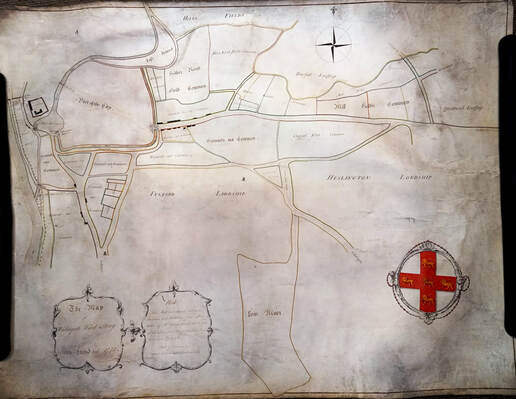
15 April - FFH members visit to the archives at York Explore
We went to see the 1759 Fulford Enclosure Map and the accompanying Schedule Book allocating the enclosed plots to their new owners.
York Explore staff kindly arranged for other historic maps of our area to be displayed and FFH member and map lover, Chris Rainger, brought copies of his local maps as well !
You can download a copy of the Fulford Enclosure map HERE and a transcription of the Schedule HERE
To the right you can see John Lund's 1772 map of Walmgate Stray, based on a map of 1736 by George Smith. Note the windmill at the junction of Cemetery Road and Fulford Road.
Here are some of the maps we saw. (click or hover your mouse over the map to read the caption)
We went to see the 1759 Fulford Enclosure Map and the accompanying Schedule Book allocating the enclosed plots to their new owners.
York Explore staff kindly arranged for other historic maps of our area to be displayed and FFH member and map lover, Chris Rainger, brought copies of his local maps as well !
You can download a copy of the Fulford Enclosure map HERE and a transcription of the Schedule HERE
To the right you can see John Lund's 1772 map of Walmgate Stray, based on a map of 1736 by George Smith. Note the windmill at the junction of Cemetery Road and Fulford Road.
Here are some of the maps we saw. (click or hover your mouse over the map to read the caption)
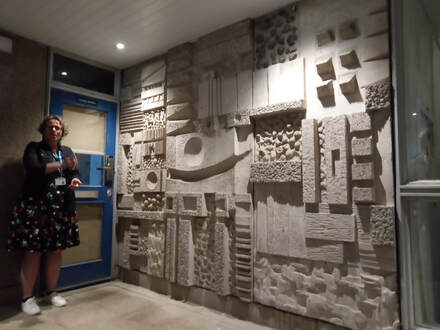
23 May - A walk around the University campus to see the Sculpture Collection
Led by Helena Cox, Curator of the University of York Art Collection.
Beginning in the Library with Barbara Hepworth's 1970 wood carving 'Antiphon', a group of members spent an enjoyable evening studying the sculptures around the woodland campus and the grounds of Heslington Hall. We also slipped into Derwent College to see Fred Millett's striking and very finely cast concrete panels, pictured here with Helena Cox discussing their design.
The art collection holds over 900 artworks across various media, including works by acknowledged masters, such as Barbara Hepworth, Sidney Nolan, Paul Nash, Joan Eardley, Keith Vaughan, Jacob Epstein, Mary Fedden, John Hoyland, Patrick Caulfield and Elizabeth Blackadder.
It also has pieces by prominent local artists, including Austin Wright, John Langton, Russell Platt, David Lloyd-Jones and Sally Arnup. Modern British art from the 1960s to the 1980s is a particular strength of the art collection, although the breadth of the collection also encompasses ancient and modern ceramics, textile-art, sculpture, painting, printmaking, book-art and photography.
The University's Norman Rea Gallery have published a leaflet about the 14 sculptures, with a map showing their location, which you can download HERE
And this link will open the University art collection catalogue
Hold your computer's mouse over the images below to read the caption
Led by Helena Cox, Curator of the University of York Art Collection.
Beginning in the Library with Barbara Hepworth's 1970 wood carving 'Antiphon', a group of members spent an enjoyable evening studying the sculptures around the woodland campus and the grounds of Heslington Hall. We also slipped into Derwent College to see Fred Millett's striking and very finely cast concrete panels, pictured here with Helena Cox discussing their design.
The art collection holds over 900 artworks across various media, including works by acknowledged masters, such as Barbara Hepworth, Sidney Nolan, Paul Nash, Joan Eardley, Keith Vaughan, Jacob Epstein, Mary Fedden, John Hoyland, Patrick Caulfield and Elizabeth Blackadder.
It also has pieces by prominent local artists, including Austin Wright, John Langton, Russell Platt, David Lloyd-Jones and Sally Arnup. Modern British art from the 1960s to the 1980s is a particular strength of the art collection, although the breadth of the collection also encompasses ancient and modern ceramics, textile-art, sculpture, painting, printmaking, book-art and photography.
The University's Norman Rea Gallery have published a leaflet about the 14 sculptures, with a map showing their location, which you can download HERE
And this link will open the University art collection catalogue
Hold your computer's mouse over the images below to read the caption
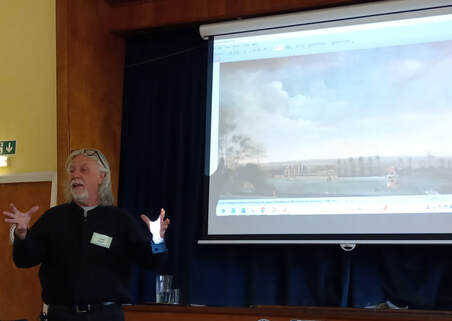
10 June - Our Festival of Ideas Event - Food and Farming in Early Heslington.
How the archaeology discovered at Heslington East Campus has informed our understanding of the early inhabitants of our area.
Chaired by John Oxley (pictured here) former City Archaeologist, and lead by Steve Roskam of the University of York, this wide-ranging event considered the changing ways in which humans engaged with landscapes in and around Heslington from the pre-Roman period onwards.
Our seven speakers from academic, community and commercial archaeological practices explored what we know of the people who visited, and later settled in this area, investigating what they ate; how they raised their livestock; what crops they grew and how did they process them, and most importantly - where did they get their water supply.
The Vale of York has been used and shaped by communities since the end of the last Ice Age. Its earliest prehistoric features chart the way in which people evolved over time from transient to more settled forms of occupation. From the end of the Bronze Age, land began to be divided, with recognisable field systems developing during the Iron Age.
Discover more about the archaeology of Heslington on our web-page HERE
You can download a copy of the event programme and poster HERE
You can read more about the archaeology at Heslington East HERE
How the archaeology discovered at Heslington East Campus has informed our understanding of the early inhabitants of our area.
Chaired by John Oxley (pictured here) former City Archaeologist, and lead by Steve Roskam of the University of York, this wide-ranging event considered the changing ways in which humans engaged with landscapes in and around Heslington from the pre-Roman period onwards.
Our seven speakers from academic, community and commercial archaeological practices explored what we know of the people who visited, and later settled in this area, investigating what they ate; how they raised their livestock; what crops they grew and how did they process them, and most importantly - where did they get their water supply.
The Vale of York has been used and shaped by communities since the end of the last Ice Age. Its earliest prehistoric features chart the way in which people evolved over time from transient to more settled forms of occupation. From the end of the Bronze Age, land began to be divided, with recognisable field systems developing during the Iron Age.
Discover more about the archaeology of Heslington on our web-page HERE
You can download a copy of the event programme and poster HERE
You can read more about the archaeology at Heslington East HERE
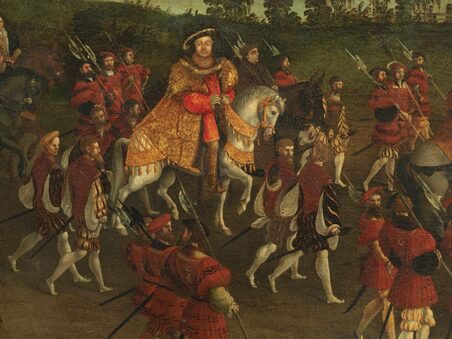 Henry VIII Progress at the Cloth of Gold
Henry VIII Progress at the Cloth of Gold
15 July - Henry VIII's Journey to Aldi - Why and how did Henry VIII come to York in 1541.
An Illustrated talk by Keely Hayes-Davies of the University of York. (We arranged this event to complement the Theatre Royal's production of 'Sovereign' - written by Mike Kenny from the book by CJ Samson.)
Henry VIII and his new wife Catherine came on a Royal Progress to York, with a huge retinue of courtiers and soldiers, accompanied by a massive baggage train.
After perambulating around east Yorkshire, staying at Wressle, Leconfield, Cawood and Hull, the massive convoy trundled up to Fulford Cross, where the city officials knelt in fear as the city Recorder read an abject apology for their role in the rebellion known as the Pilgrimage of Grace. After receiving gifts of gold, Henry rode up Cemetery Road (then known as the King's Ditch) and entered the city through Walmgate Bar and along Petergate to the recently disestablished St Mary's Abbey.
But Henry was not just in York to stamp his power on the rebellious north, he was also hoping to meet the Scottish King James IV.
Read more about Henry's visit on our History Topics web-page HERE
An Illustrated talk by Keely Hayes-Davies of the University of York. (We arranged this event to complement the Theatre Royal's production of 'Sovereign' - written by Mike Kenny from the book by CJ Samson.)
Henry VIII and his new wife Catherine came on a Royal Progress to York, with a huge retinue of courtiers and soldiers, accompanied by a massive baggage train.
After perambulating around east Yorkshire, staying at Wressle, Leconfield, Cawood and Hull, the massive convoy trundled up to Fulford Cross, where the city officials knelt in fear as the city Recorder read an abject apology for their role in the rebellion known as the Pilgrimage of Grace. After receiving gifts of gold, Henry rode up Cemetery Road (then known as the King's Ditch) and entered the city through Walmgate Bar and along Petergate to the recently disestablished St Mary's Abbey.
But Henry was not just in York to stamp his power on the rebellious north, he was also hoping to meet the Scottish King James IV.
Read more about Henry's visit on our History Topics web-page HERE

23 September - The Enclosure of our Medieval Open Fields - Understanding Parliamentary enclosures, land tax and tithes from 1700.
Lauren Grindley, gave us a personal and professional view of enclosures around York, derived in part from her work in the city Rights of Way department, where she encounters many interesting maps and documents which give clues on the history of footpaths.
She showed us the 1759 enclosure map of Fulford, which shows the previously open fields of Gate Fulford Manor divided into fields with the area and new owner written on each plot. This map also shows the narrow medieval (or earlier) plots strung out on either side of Main Street down to the back lanes we still see today. You can see the Fulford map and read more about the Fulford Enclosure on our Medieval Fulford page HERE
The Fulford map is a poor relation to the 1771 map of the Wiggington enclosures, shown below (thanks to York Explore). Unlike Fulford, this map marks the allocation of responsibility for maintenance of boundary hedges and also has a delightful drawing of the village windmill.
Before the enclosures, villagers farmed long narrow strips of land within the open fields. Many also grazed animals on the common land and some had the right to put their animals on the Ings after the annual hay crop had been taken - this was known as Half Year Land. Villagers were required to pay a tithe to the Lord of the Manor, usually 10% of their crop or part of their earnings from sheep and cattle.
Lauren explained that some lands were exempt from paying tithes:
Although most enclosures of open fields and commons were made during the 18th and early 19th centuries, enclosure of commons and open fields had been happening since the 13th century, and accelerated in the 17th century. Many earlier enclosures were undertaken by mutual agreement, or imposed by the Lord of the Manor, but by the 18th century most were made under an act of parliament, with commissioners appointed to represent the various interested parties.
As well as a map, a schedule with a carefully detailed written description was made of each allotment of land, describing it in terms of its position relative to the plots on each side. This produces a convoluted text, but we are lucky that the Fulford enclosure has been painstakingly transcribed and can be downloaded HERE
Laura showed us this small part of the Wiggington Schedule:
Also we do assign award and allot unto the said Hewley Baines and his heirs four acres two roods and four perches of land other parcel of the said Common and waste grounds and adjoining upon the said Hewley Baines old Inclosure on the East and the said Turnpike Road on the west on part of an allotment hereinafter made to w. Richard Gowland on the north and on an allotment hereinafter made to Mr John Lund on the south. And we do order award and direct that the said Hewley Baines his heirs and assigns shall make and forever hereafter repair and maintain a sufficient fence and ditch in this allotment to divide the same from the said Turnpike Road……..etc.
Although some parts of Heslington had been enclosed before, most of the village was not enclosed until 1857, when the Lord of the Manor created a number of farms on his large estate and used the increase in his rents to fund the demolition of most of his Tudor manor house and build the Hall which now serves as the administration building for the University. You can see the Heslington Enclosure map HERE
Lauren Grindley, gave us a personal and professional view of enclosures around York, derived in part from her work in the city Rights of Way department, where she encounters many interesting maps and documents which give clues on the history of footpaths.
She showed us the 1759 enclosure map of Fulford, which shows the previously open fields of Gate Fulford Manor divided into fields with the area and new owner written on each plot. This map also shows the narrow medieval (or earlier) plots strung out on either side of Main Street down to the back lanes we still see today. You can see the Fulford map and read more about the Fulford Enclosure on our Medieval Fulford page HERE
The Fulford map is a poor relation to the 1771 map of the Wiggington enclosures, shown below (thanks to York Explore). Unlike Fulford, this map marks the allocation of responsibility for maintenance of boundary hedges and also has a delightful drawing of the village windmill.
Before the enclosures, villagers farmed long narrow strips of land within the open fields. Many also grazed animals on the common land and some had the right to put their animals on the Ings after the annual hay crop had been taken - this was known as Half Year Land. Villagers were required to pay a tithe to the Lord of the Manor, usually 10% of their crop or part of their earnings from sheep and cattle.
Lauren explained that some lands were exempt from paying tithes:
- Lands naturally barren.
- Barren heath or waste improved or converted into arable or meadow was exempt for a period of seven years after improvement
- Forest lands while in the occupation of the Crown or its lessee or tenant, but not if granted by the Crown in fee
- Glebe lands in the occupation of the parson
- Lands owned before 1215 by the Cistercians, Templars, or Hospitallers;
- Lands which formerly belonged to one of the greater monasteries, and which had not paid tithes at the time of the dissolution
- Lands which had paid no tithes from time immemorial
- Lands in respect of which tithes were barred under the Tithe Act of 1832 , which specified some lands which had not paid tithes for a very long time, the original cause of exemption being unknown
- Lands in respect of which a modus or composition was payable.
Although most enclosures of open fields and commons were made during the 18th and early 19th centuries, enclosure of commons and open fields had been happening since the 13th century, and accelerated in the 17th century. Many earlier enclosures were undertaken by mutual agreement, or imposed by the Lord of the Manor, but by the 18th century most were made under an act of parliament, with commissioners appointed to represent the various interested parties.
As well as a map, a schedule with a carefully detailed written description was made of each allotment of land, describing it in terms of its position relative to the plots on each side. This produces a convoluted text, but we are lucky that the Fulford enclosure has been painstakingly transcribed and can be downloaded HERE
Laura showed us this small part of the Wiggington Schedule:
Also we do assign award and allot unto the said Hewley Baines and his heirs four acres two roods and four perches of land other parcel of the said Common and waste grounds and adjoining upon the said Hewley Baines old Inclosure on the East and the said Turnpike Road on the west on part of an allotment hereinafter made to w. Richard Gowland on the north and on an allotment hereinafter made to Mr John Lund on the south. And we do order award and direct that the said Hewley Baines his heirs and assigns shall make and forever hereafter repair and maintain a sufficient fence and ditch in this allotment to divide the same from the said Turnpike Road……..etc.
Although some parts of Heslington had been enclosed before, most of the village was not enclosed until 1857, when the Lord of the Manor created a number of farms on his large estate and used the increase in his rents to fund the demolition of most of his Tudor manor house and build the Hall which now serves as the administration building for the University. You can see the Heslington Enclosure map HERE
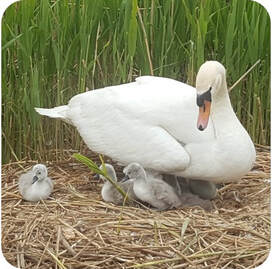
28 October - Wildlife on Campus
An Illustrated Talk by Gordon Eastham
Grounds & Ecology Manger at the University of York
Gordon Eastham gave us an entertaining and fascinating insight into the joys and challenges of his role. He began work at the University of York on 1st August 1994, so he has worked for the University for nearly 30 years - almost half the length of time the university has been in existence. He said that although he knows very little about what proceeded him in terms of campus wildlife, he could tell us about what has happened over the last 30 years or so. Neither a botanist or a zoologist, Gordon's background is in horticulture and landscaping, and his talk mainly focused on the fauna of the campus, rather than the flora. You can download a pdf of his slides and notes HERE
Here is an edited extract of Gordon's talk....
When the university came into existence in the early 1960s, one of the primary features of the campus was the serpentine lake running through its centre. This lake is functional, aesthetic, and increases biodiversity, including wildfowl and fish, and Gordon explained something of the management of both in the context of west campus. There are several information boards around the lake on campus west and depict a range of the bird species that might be seen on the lake. Occasionally some exciting new species arrive, including a Great Egret and Black Winged Stilts. A Kingfisher has also recently been spotted.
Several species have been purposely introduced to campus west over the decades. Notable examples are Barnacle & Snow Goose and also Black Swans. There are populations of Barnacle & Snow Goose breeding successfully, and the university campus may be one of only two locations in the British Isles where Snow Geese breed. Sadly, there are no Black Swans left on campus. They are actually a species native to Australia and as such as used to breeding in November time, which equates to springtime in the southern hemisphere, but the beginning of winter in this country. As a result, very few cygnets ever survived.
Long Boi was a campus duck who rose to fame in 2019 after a student created an Instagram account in his name. He was a Mallard and Indian Runner Duck cross, and was recognisable by his bold personality and unusual stature. He was noticeably taller than his fellow ducks, standing at around 70cm high (see picture below). It is unclear how Long Boi came to live on campus, but reports suggest he was first noticed in early 2019. His verified Instagram account, which grew to have more than 54,000 followers, was launched in May 2019. In the years that followed, Long Boi reached unexpected heights of fame. He made appearances in global media, including on the Radio 1 Breakfast Show with Greg James and James Corden’s Late Late show in the US - Long Boi was dubbed “Britain’s most famous duck” but In May 2023, Long Boi was declared presumed dead, after fans noticed he had not been seen in more than two months.
Carp and Bream came to dominate the fish population, primarily because these were the types of fish that anglers wanted to fish, but these species have on the ecology of the lake. The removal of the apex predator in the form of the Pike in part precipitated this imbalance, as did the introduction of species that were heavy grazers of zooplankton. The simple solution would have been to reintroduce Pike, but the angling club disagreed so we had to look to other means. To this end we brought in the EA to help us bio-manipulate the fish population. This involved periodically removing a quantity of fish from the lake, which the EA took to re-stock other fisheries. Since then, we have received more traditional assistance in controlling the fish population in the form of piscivorus birds and regular visits from Otters. Birds such as Grebes, Herons, Little Egrets and Goosanders take a lot of small fish, which might otherwise have been taken by Pike. Otters have also thinned out the big fish population, which has led to a reduction in breeding and less big fish stirring up the bottom sediments as they feed.
An Illustrated Talk by Gordon Eastham
Grounds & Ecology Manger at the University of York
Gordon Eastham gave us an entertaining and fascinating insight into the joys and challenges of his role. He began work at the University of York on 1st August 1994, so he has worked for the University for nearly 30 years - almost half the length of time the university has been in existence. He said that although he knows very little about what proceeded him in terms of campus wildlife, he could tell us about what has happened over the last 30 years or so. Neither a botanist or a zoologist, Gordon's background is in horticulture and landscaping, and his talk mainly focused on the fauna of the campus, rather than the flora. You can download a pdf of his slides and notes HERE
Here is an edited extract of Gordon's talk....
When the university came into existence in the early 1960s, one of the primary features of the campus was the serpentine lake running through its centre. This lake is functional, aesthetic, and increases biodiversity, including wildfowl and fish, and Gordon explained something of the management of both in the context of west campus. There are several information boards around the lake on campus west and depict a range of the bird species that might be seen on the lake. Occasionally some exciting new species arrive, including a Great Egret and Black Winged Stilts. A Kingfisher has also recently been spotted.
Several species have been purposely introduced to campus west over the decades. Notable examples are Barnacle & Snow Goose and also Black Swans. There are populations of Barnacle & Snow Goose breeding successfully, and the university campus may be one of only two locations in the British Isles where Snow Geese breed. Sadly, there are no Black Swans left on campus. They are actually a species native to Australia and as such as used to breeding in November time, which equates to springtime in the southern hemisphere, but the beginning of winter in this country. As a result, very few cygnets ever survived.
Long Boi was a campus duck who rose to fame in 2019 after a student created an Instagram account in his name. He was a Mallard and Indian Runner Duck cross, and was recognisable by his bold personality and unusual stature. He was noticeably taller than his fellow ducks, standing at around 70cm high (see picture below). It is unclear how Long Boi came to live on campus, but reports suggest he was first noticed in early 2019. His verified Instagram account, which grew to have more than 54,000 followers, was launched in May 2019. In the years that followed, Long Boi reached unexpected heights of fame. He made appearances in global media, including on the Radio 1 Breakfast Show with Greg James and James Corden’s Late Late show in the US - Long Boi was dubbed “Britain’s most famous duck” but In May 2023, Long Boi was declared presumed dead, after fans noticed he had not been seen in more than two months.
Carp and Bream came to dominate the fish population, primarily because these were the types of fish that anglers wanted to fish, but these species have on the ecology of the lake. The removal of the apex predator in the form of the Pike in part precipitated this imbalance, as did the introduction of species that were heavy grazers of zooplankton. The simple solution would have been to reintroduce Pike, but the angling club disagreed so we had to look to other means. To this end we brought in the EA to help us bio-manipulate the fish population. This involved periodically removing a quantity of fish from the lake, which the EA took to re-stock other fisheries. Since then, we have received more traditional assistance in controlling the fish population in the form of piscivorus birds and regular visits from Otters. Birds such as Grebes, Herons, Little Egrets and Goosanders take a lot of small fish, which might otherwise have been taken by Pike. Otters have also thinned out the big fish population, which has led to a reduction in breeding and less big fish stirring up the bottom sediments as they feed.
It was in 2008 that work began on the development of the new Heslington east campus. One of the planning conditions placed on the university was to increase the biodiversity of the site by creating a mosaic of different wildlife habitats on the intensively farmed arable land. Some hedgerows and ditches were retained. Particularly of note was the hedge along the southern boundary of Low Lane, as it contains a number of different species. Ditches were a good natural source of wetland plant material but there was only one small area of semi mature woodland and few mature trees because of the intensive agricultural use.
If campus west lake is a good example of an unbalanced/stressed eco-system, we have tried to avoid this happening on Campus East. Creating species-rich meadowlands was a challenge in so much as you need low fertility conditions to grow wildflowers successfully, but the land had been highly fertilised to grow crops and unless something was done, coarse grasses would out-compete wildflowers. We overcame this through soil inversion, initially through the muck shifting operation in phase 1 of development when the lake was being excavated and the topography of the site being reshaped. We followed this in localised areas by deep ploughing to bury top soil and bring subsoil to the surface.
Invertebrates will in turn attract birds that feed on them, and meadowlands will also provide nesting opportunities for ground nesting birds – Skylarks for example. Hopefully over time, the woodland blocks will develop a diverse herb layer and provide habitat for priority bird and mammal species. Nesting and roosting boxes can be introduced when the trees become big enough and log and brash piles can be created from the wood generated by thinning operations.
In 2014 we installed a Peregrine falcon nesting box high up on the CBH chimney. We knew that Peregrines nested on The Minster, so we hoped to attract them to campus as well, but we had no interest whatsoever until July last year when a lone bird showed up to scope out the box. He came back in spring this year but without a mate. However, there are two birds now, so we are keeping fingers crossed for a breeding attempt next spring – 10 years after the box was first installed - and having a pair of Peregrines around might have the additional bonus of scaring the pigeons off.
Since the development of Heslington East, one of the primary strands of ecological management has been to help bees and other pollinators. One of the major habitats created has been species-rich meadowland and one of the primary benefits of this habitat is to provide foraging for bees.
Since 2013 the university campus has held a green flag award. This is the benchmark national standard for publicly accessible parks and green spaces in the United Kingdom, and we were also successful in gaining a Bees Needs award. In addition to the wild bee population, we have also had several bee keepers on campus over the past decade. They keep their bees on campus to take advantage of the considerable foraging opportunities available.
Over the last few years, there has been a great deal of focus on making the university campus Hedgehog friendly. It was always anticipated that campus east could be a potential release site for rescue Hedgehogs, but interest and awareness amongst both staff and students in the plight of Hedgehogs has led to the founding of a Hedgehog group and a drive to achieve Hedgehog Friendly Campus status. Over the past five years we have systematically worked our way through bronze to platinum, which we achieved early in 2023.
We have two tree trails around West Campus, which I lead from time to time, although all are welcome to follow the guide leaflets. You can download the Native Tree Trail HERE. And the Non-native Tree Trail HERE. The native tree trail has a focus on the benefit of native trees to wildlife.
The University launched it’s new Sustainability Strategy in October 2021, highlighting how much the work of the grounds section contributes to the university’s sustainability credentials and what it values. We have had an Environmental Management Plan since 2013 and this document describes how we try to manage the campus for the benefit of wildlife and to increase biodiversity. It is available to read on the grounds section web pages on the university website HERE.
You can read about the history of the gardens at Heslington Hall HERE
And you can read about the buildings on Campus West HERE
If campus west lake is a good example of an unbalanced/stressed eco-system, we have tried to avoid this happening on Campus East. Creating species-rich meadowlands was a challenge in so much as you need low fertility conditions to grow wildflowers successfully, but the land had been highly fertilised to grow crops and unless something was done, coarse grasses would out-compete wildflowers. We overcame this through soil inversion, initially through the muck shifting operation in phase 1 of development when the lake was being excavated and the topography of the site being reshaped. We followed this in localised areas by deep ploughing to bury top soil and bring subsoil to the surface.
Invertebrates will in turn attract birds that feed on them, and meadowlands will also provide nesting opportunities for ground nesting birds – Skylarks for example. Hopefully over time, the woodland blocks will develop a diverse herb layer and provide habitat for priority bird and mammal species. Nesting and roosting boxes can be introduced when the trees become big enough and log and brash piles can be created from the wood generated by thinning operations.
In 2014 we installed a Peregrine falcon nesting box high up on the CBH chimney. We knew that Peregrines nested on The Minster, so we hoped to attract them to campus as well, but we had no interest whatsoever until July last year when a lone bird showed up to scope out the box. He came back in spring this year but without a mate. However, there are two birds now, so we are keeping fingers crossed for a breeding attempt next spring – 10 years after the box was first installed - and having a pair of Peregrines around might have the additional bonus of scaring the pigeons off.
Since the development of Heslington East, one of the primary strands of ecological management has been to help bees and other pollinators. One of the major habitats created has been species-rich meadowland and one of the primary benefits of this habitat is to provide foraging for bees.
Since 2013 the university campus has held a green flag award. This is the benchmark national standard for publicly accessible parks and green spaces in the United Kingdom, and we were also successful in gaining a Bees Needs award. In addition to the wild bee population, we have also had several bee keepers on campus over the past decade. They keep their bees on campus to take advantage of the considerable foraging opportunities available.
Over the last few years, there has been a great deal of focus on making the university campus Hedgehog friendly. It was always anticipated that campus east could be a potential release site for rescue Hedgehogs, but interest and awareness amongst both staff and students in the plight of Hedgehogs has led to the founding of a Hedgehog group and a drive to achieve Hedgehog Friendly Campus status. Over the past five years we have systematically worked our way through bronze to platinum, which we achieved early in 2023.
We have two tree trails around West Campus, which I lead from time to time, although all are welcome to follow the guide leaflets. You can download the Native Tree Trail HERE. And the Non-native Tree Trail HERE. The native tree trail has a focus on the benefit of native trees to wildlife.
The University launched it’s new Sustainability Strategy in October 2021, highlighting how much the work of the grounds section contributes to the university’s sustainability credentials and what it values. We have had an Environmental Management Plan since 2013 and this document describes how we try to manage the campus for the benefit of wildlife and to increase biodiversity. It is available to read on the grounds section web pages on the university website HERE.
You can read about the history of the gardens at Heslington Hall HERE
And you can read about the buildings on Campus West HERE
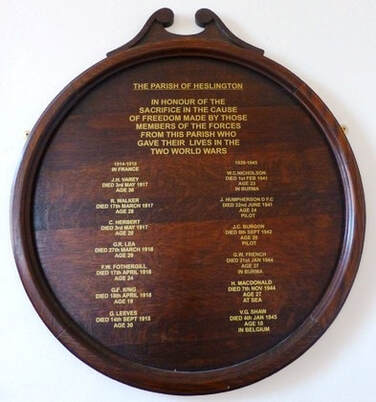
11 November - Remembering the men named on the WW2 memorial in Heslington Church
Our treasurer and Heslington resident, retired priest Rev. Peter Mott, gave a moving talk about the six men who are named on the Second Wold War memorial in Heslington Church.
After the talk, a wreath was laid at the memorial by Michael French, the son of Lieutenant George French. Two minutes silence was observed at 11.00 am.
With much help from Barbara King, Peter's research discovered remarkable details about the men's military service. Their stories of stoic heroism in the face of terrifying situations reached every one of us. Peter said that before he began his research, he had assumed that most of the men would be airmen from the nearby Elvington bomber base. Two were indeed RAF crew, but both had no connections with the base and died far from Yorkshire:
Flight Sergeant James Burgon flew Spitfires and was killed on a low level training flight near Abergavenny in South Wales
Flight Lt. John Humpherson was awarded a DFC for his courage flying Hurricanes from Biggin Hill during the Battle of Britain, but died when a test flight of a Boeing Fortress bomber crashed near Catterick.
Sergeant Harry MacDonald died in November 1944, some months after D-Day, when the Tank Landing Ship he was on carrying telecommunications equipment, struck a mine outside Ostend and quickly sank in heavy seas.
Lance Corporal Victor Shaw was killed in January 1945 during the German counter-offensive in the Ardenne, known as the Battle of the Bulge.
Two Heslington men named on the memorial were killed in the 'forgotten war' against the Japanese in Burma (now Myamar): Trooper Wilfred Nicholson and Lieutenant George French. Unfortunately it has not been possible to piece together details of Wilfred Nicholson's military activities with the Royal Armoured Corps.
George French had fought in North Africa and the Middle East, before being sent to join the effort to prevent Japan from invading India. He died in January 1944 attacking a machine gun post during the campaign to push back down the peninsular to Singapore.
You can read much more about these men and the Burma campaign in Peter Mott's Illustrated talk - HERE
Our treasurer and Heslington resident, retired priest Rev. Peter Mott, gave a moving talk about the six men who are named on the Second Wold War memorial in Heslington Church.
After the talk, a wreath was laid at the memorial by Michael French, the son of Lieutenant George French. Two minutes silence was observed at 11.00 am.
With much help from Barbara King, Peter's research discovered remarkable details about the men's military service. Their stories of stoic heroism in the face of terrifying situations reached every one of us. Peter said that before he began his research, he had assumed that most of the men would be airmen from the nearby Elvington bomber base. Two were indeed RAF crew, but both had no connections with the base and died far from Yorkshire:
Flight Sergeant James Burgon flew Spitfires and was killed on a low level training flight near Abergavenny in South Wales
Flight Lt. John Humpherson was awarded a DFC for his courage flying Hurricanes from Biggin Hill during the Battle of Britain, but died when a test flight of a Boeing Fortress bomber crashed near Catterick.
Sergeant Harry MacDonald died in November 1944, some months after D-Day, when the Tank Landing Ship he was on carrying telecommunications equipment, struck a mine outside Ostend and quickly sank in heavy seas.
Lance Corporal Victor Shaw was killed in January 1945 during the German counter-offensive in the Ardenne, known as the Battle of the Bulge.
Two Heslington men named on the memorial were killed in the 'forgotten war' against the Japanese in Burma (now Myamar): Trooper Wilfred Nicholson and Lieutenant George French. Unfortunately it has not been possible to piece together details of Wilfred Nicholson's military activities with the Royal Armoured Corps.
George French had fought in North Africa and the Middle East, before being sent to join the effort to prevent Japan from invading India. He died in January 1944 attacking a machine gun post during the campaign to push back down the peninsular to Singapore.
You can read much more about these men and the Burma campaign in Peter Mott's Illustrated talk - HERE
2022 Events
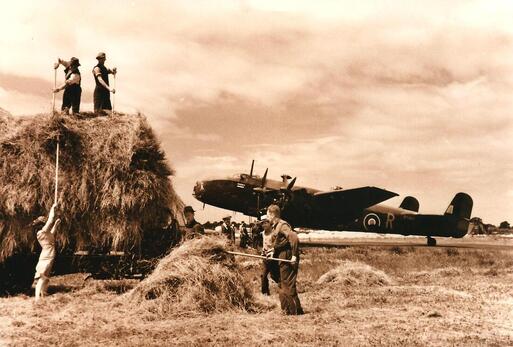 Airmen helping with haymaking at Elvington. Image from the Jim Murphy Collection
Airmen helping with haymaking at Elvington. Image from the Jim Murphy Collection
19 February - The Life and Death of 77 RAF Squadron
About 35 members and friends came to Heslington Church for our first meeting of 2022, to hear Dr John Wright, the honorary archivist/curator at the Yorkshire Air Museum in Elvington, close to Heslington village.
The squadron was formed in Edinburgh in 1916, and had various incarnations over the years, being based at Elvington from 1943 to 1944, followed by Full Sutton, where it ended the war. 77 Squadron was the only British squadron to be based at Elvington.
Many squadron members went on to serve in India, transporting troops, equipment and supplies especially to those in remote outposts. John’s very interesting visual talk concentrated on the Second World War period, when the severe losses of the squadron comprised of 891 airmen and three naval pilots.
230 men have no known grave so are commemorated on the memorial at Runnymede, 104 are buried in the UK and Ireland, 322 are buried in Germany. The graves of others are in Belgium, France, the Netherlands, Poland and Denmark. 216 became prisoners of war and 20 evaded; ie. were shot down and escaped back to England. 77 Squadron was the only British squadron to be based at Elvington.
We heard about one particular crew and how, after being shot down, they landed the plane in the sea where they inflated the escape dinghy, and suffered severe cold until they were rescued. Some of the crew did not survive. This was not an unusual occurrence. The raids on which the squadron took part would take about eight hours, where the seven man crew (pilot, navigator, flight engineer, wireless operator, bomb aimer, mid-upper gunner and rear gunner) flew over enemy territory to drop their bombs on targets which were primarily industrial sites. The men would return exhausted in the early hours of the morning, ready to be debriefed about the mission. There were also women in the squadron, some of whom were drivers taking crews from their billets, some way away, out to the airfield. Unfortunately there would be times when the crews they had got to know did not return.
John brought along two volunteers from the Air Museum who demonstrated examples of the kit worn by the crews. There was a leather sheepskin Irvin jacket, matching trousers which were very heavy, a leather flying helmet lined with buff coloured chamois, with earphones, microphone and oxygen mask. They would also wear a life jacket and goggles. We saw flying boots and heard how, if a crew member had to bale out, the top part could be cut off with a penknife to leave ordinary shoes.
John also spoke of how the Yorkshire Air Museum has an extensive collection of photographs, uniforms, medals, logbooks, correspondence and equipment. They are happy to accept any memorabilia from men and women who served in the RAF. The archives can be opened to the public for those who wish to research their relatives.
John’s talk was both informative and enjoyable, his presenting style very personable. He was happy to chat afterwards with those who attended. At the end we heard a short extract from a Second World War pilot, recorded by the BBC after a raid on Berlin in 1943. This was very poignant as the man was killed a year later.
There were various questions and some members shared memories of their own family members who served in the war. No-one present was old enough to have fought in the Second World War so it was very interesting to hear how one squadron in our area coped with such a terrible time in our history.
The Rector of Elvington and later honorary chaplain of the Museum, Rev Leonard Rivett, recorded memories of villagers and other civilians involved with the air base. You can read a transcript HERE
77 Squadron has an excellent website and a thriving Association which exists to remember those who served with the squadron: https://77squadron.org.uk
Elvington is now home to The Yorkshire Air Museum, which has many exhibits telling the story of flight from Sir George Caley's glider, in which his coachman made the first ever glider flight in 1853 and the first powered aeroplane, the Wright Flyer, through to supersonic jets. More details at: yorkshireairmuseum.org/
*************************************************************************************************************************************************
About 35 members and friends came to Heslington Church for our first meeting of 2022, to hear Dr John Wright, the honorary archivist/curator at the Yorkshire Air Museum in Elvington, close to Heslington village.
The squadron was formed in Edinburgh in 1916, and had various incarnations over the years, being based at Elvington from 1943 to 1944, followed by Full Sutton, where it ended the war. 77 Squadron was the only British squadron to be based at Elvington.
Many squadron members went on to serve in India, transporting troops, equipment and supplies especially to those in remote outposts. John’s very interesting visual talk concentrated on the Second World War period, when the severe losses of the squadron comprised of 891 airmen and three naval pilots.
230 men have no known grave so are commemorated on the memorial at Runnymede, 104 are buried in the UK and Ireland, 322 are buried in Germany. The graves of others are in Belgium, France, the Netherlands, Poland and Denmark. 216 became prisoners of war and 20 evaded; ie. were shot down and escaped back to England. 77 Squadron was the only British squadron to be based at Elvington.
We heard about one particular crew and how, after being shot down, they landed the plane in the sea where they inflated the escape dinghy, and suffered severe cold until they were rescued. Some of the crew did not survive. This was not an unusual occurrence. The raids on which the squadron took part would take about eight hours, where the seven man crew (pilot, navigator, flight engineer, wireless operator, bomb aimer, mid-upper gunner and rear gunner) flew over enemy territory to drop their bombs on targets which were primarily industrial sites. The men would return exhausted in the early hours of the morning, ready to be debriefed about the mission. There were also women in the squadron, some of whom were drivers taking crews from their billets, some way away, out to the airfield. Unfortunately there would be times when the crews they had got to know did not return.
John brought along two volunteers from the Air Museum who demonstrated examples of the kit worn by the crews. There was a leather sheepskin Irvin jacket, matching trousers which were very heavy, a leather flying helmet lined with buff coloured chamois, with earphones, microphone and oxygen mask. They would also wear a life jacket and goggles. We saw flying boots and heard how, if a crew member had to bale out, the top part could be cut off with a penknife to leave ordinary shoes.
John also spoke of how the Yorkshire Air Museum has an extensive collection of photographs, uniforms, medals, logbooks, correspondence and equipment. They are happy to accept any memorabilia from men and women who served in the RAF. The archives can be opened to the public for those who wish to research their relatives.
John’s talk was both informative and enjoyable, his presenting style very personable. He was happy to chat afterwards with those who attended. At the end we heard a short extract from a Second World War pilot, recorded by the BBC after a raid on Berlin in 1943. This was very poignant as the man was killed a year later.
There were various questions and some members shared memories of their own family members who served in the war. No-one present was old enough to have fought in the Second World War so it was very interesting to hear how one squadron in our area coped with such a terrible time in our history.
The Rector of Elvington and later honorary chaplain of the Museum, Rev Leonard Rivett, recorded memories of villagers and other civilians involved with the air base. You can read a transcript HERE
77 Squadron has an excellent website and a thriving Association which exists to remember those who served with the squadron: https://77squadron.org.uk
Elvington is now home to The Yorkshire Air Museum, which has many exhibits telling the story of flight from Sir George Caley's glider, in which his coachman made the first ever glider flight in 1853 and the first powered aeroplane, the Wright Flyer, through to supersonic jets. More details at: yorkshireairmuseum.org/
*************************************************************************************************************************************************
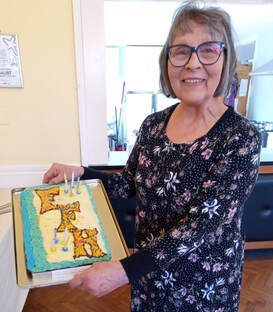
26 March - Our AGM and 10th Birthday Celebration
Some 30 members came to our Annual General Meeting which was followed by a presentation by our past chairman Christopher Rainger.
Chris had looked back through our programme and other records and picked out highlights from the huge range of activities we have enjoyed over our first decade. Everyone was amazed at how much we have done and how the programme has catered for a great many different interests.
We also enjoyed a slice of FFH birthday cake - cooked, as always by our current Chair Louise Wheatley.
You can read a copy of her chairman's report HERE
You can also download Chris's presentation showing the range of our activities HERE
*********************************************************************************************************************************
Some 30 members came to our Annual General Meeting which was followed by a presentation by our past chairman Christopher Rainger.
Chris had looked back through our programme and other records and picked out highlights from the huge range of activities we have enjoyed over our first decade. Everyone was amazed at how much we have done and how the programme has catered for a great many different interests.
We also enjoyed a slice of FFH birthday cake - cooked, as always by our current Chair Louise Wheatley.
You can read a copy of her chairman's report HERE
You can also download Chris's presentation showing the range of our activities HERE
*********************************************************************************************************************************
30 April – 250 years of Education in Fulford
John Key’s school in Main Street was founded in 1771. This photograph shows the building today, with white arches where windows used to flood the classroom with sunlight.
A commemorative bench with a buried time capsule has been erected in front of the school and was unveiled by the Archbishop of York, Stephen Cottrell, pictured above with the current Headteacher, Sue Bland.
The school has published a splendid booklet telling the history of education in the village, from the 18th century to the present day, with pictures and stories about the school - and its staff and pupils, including pages from the first Headteacher's Log Book.
You can buy a copy from the school, or download a copy HERE
On 30 April, we celebrated 250 years of education in Fulford, when Helen Hayton gave us a fascinating talk with interesting slides and a display of photographs and documents, including the first headteacher’s Log Book.
Helen was part of a team who researched the history of what is now Fulford Primary School and discovered that the first formal school in the village was a Dame School in 1743, where a teacher gave local children lessons in her home.
However, education could be said to have truly begun in 1771, when John Key the owner of Water Fulford Hall, paid for a purpose built school to be built in Main Street. That building still stands and is now No. 27, although the two large arched windows which once flooded the school room with light, have since been infilled. As well as a classroom, the building also provided living accommodation for the school master and his family. John Key’s endowment paid for ‘educating and instructing twenty poor children’ and further children could attend for a fee.
The first school master that we know of was Thomas Pearson, who was also the parish clerk. He lived and taught at the school from at least 1783 until his death in 1823. Lessons are likely to have included reading, writing, basic arithmetic, and religious education. There may also have been some sewing (for the girls) and singing.
There was no government funding available for the school until many years later and materials for lessons had to be covered by the endowment or by other gifts. Mrs Mary Key, the wife of the school’s founder, left £100 (£11,000 today) to the school in her will in 1831, which paid for books and the cost of repairs to the schoolhouse.
A local wealthy spinster, Amelia Cholmley, who lived at Fulford Lodge (where the Kilburn estate now stands) showed a great deal of interest in the school and particularly in the education of girls. In 1844, she purchased the land behind the old schoolhouse and funded the building of a new school room for infants, which was completed in 1846. The original large arched windows of this school can still be seen, and it is now used as the Scout Hut.
Increased funding became necessary and a number of local people - not just wealthy individuals, but shopkeepers and other business people - paid a regular subscription to fund the school. These subscriptions were increased in order to attract a more qualified school master and, on the 16th January 1865, Mr Oldfield Marshall was appointed. He had a keen interest in music and was also the choirmaster in Fulford church. His appointment marked a change in the running of the school with processes becoming more formalised.
In addition to the money from subscriptions and a small fee paid by each pupil, national funding was made available to the school following the Education Act of 1862, subject to pupil attendance and exam results. The law required the schoolmaster to keep a Log Book, so that accurate numbers of pupils could be submitted to the authorities and other details of school life recorded. Mr Marshall made the first entry: ‘Entered upon the duties this day. School opened by Reverend H. M. Clifford. Attendance 28’. Attendance gradually improved over the years with brief declines over harvest times (when many children helped on farms) and local feast days or religious festivals. Occasionally, severe weather or illness, particularly in the winter months, also led to low attendance.
On the 28th May 1865 Mr Marshall noted that there were 44 children present – the highest attendance since he had started at the school.
In June 1866 work began on a new school room, which opened on the 27th November, despite the desks having not yet arrived. The logbook records that ‘a pleasure manifested throughout the school that the comforts of the room were appreciated’.
Although the Log Book does not give full details of what was taught, there are frequent mentions of English grammar, spelling, reading, dictation, times tables, arithmetic and scripture. The children were grouped into ‘standards’ and to move between standards, each child was required to pass exams in reading, writing and arithmetic.
In the 1870s, Education Acts established ‘Local School Boards’ to build and manage local board schools where they were needed, and from 1880, all children between the ages of 5 to 10 years required to attend school. Numbers at the school increased during this time and in 1882 another classroom was added. In 1891 the government finally passed an Act which introduced free education for primary aged children.
Fishergate School was opened in 1895 and although St Lawrence’s School initially lost over 100 pupils, the impact on St Oswald’s School was limited. The 1891 Education Act also affected what was taught in schools. As literacy rates improved, the government began to recognise that the focus on reading, writing and arithmetic was too narrow and grants were given for additional subjects, including drawing, singing, geography and needlework. In February 1898, physical exercise was also added to the timetable at St Oswald’s, with a quarter of an hour allocated on Monday, Wednesday and Friday mornings.
The late 1800s and early 1900s were a time of significant growth in Fulford, and the number of pupils increased so that there were about 130 children on the register by 1914.
Housing development and pupil numbers continued to grow after the war, and a new school was opened in March 1930, offering modern flexible classroom spaces that allowed for fresh air and ventilation. Outside there was a playground and a grass playing field, and hot meals were provided.
However, although the new facilities were a great improvement on the cramped conditions at the old school, there were problems accommodating all the lessons from the very beginning. In part this was due to the rapidly changing provision for the older children. The Second World war saw huge pressure on the school, with pupils from Hull moving to the village to escape the blitz.
After the war, suburban York continued to expand and further housing was built in Fulford. The area around the school was no longer truly rural, although many pupils still travelled in from small farming communities. By early 1947, there were 300 children on the register and the school leaving age was raised to 15. This led to further development of the curriculum to meet the needs of the older pupils. By the 1960s, there were about 400 children on the register and as part of wider plans for education in York, a new ‘Secondary Modern’ school for 400 children was opened in 1963 on Fulfordgate (now Fulford Comprehensive School) reducing the number of places needed at the primary school.
By the 21st century, the 1930s school buildings were very tired and in January 2005, work on the new school began. Before the foundations were laid, an archaeological dig took place and finds included pottery, clay tobacco pipes, glass, iron, lead alloy and coal. It seems that there was a rural Roman settlement on the site, after which the land was used as open fields for farming throughout the medieval period. A small collection of objects associated with the Civil War was also discovered, including a glass lens, a lead pistol, musket balls and an iron axe head. The archaeological dig gave children at the school the opportunity to handle some of the finds and learn about history first-hand.
The new school building was set back from Heslington Lane, which allowed the school to stay in the old building during the construction project. In January 2006, the £4 million building was ready and, in a ceremony reminiscent of the one in 1930, two eight-year-old pupils, Melissa Hill and Asim Gurung handed the old school key to Mr Marks.
A further joint opening ceremony and summer fair were held in May. The new building included a community library, a pre-school unit, a dyslexia centre, as well as specialist IT provision and more spacious modern classrooms with interactive whiteboards.
The 250th anniversary was commemorated by installation of a special bench, built with bricks and tiles and incorporating the date panels from earlier schools, and a time capsule with objects selected by the children.
**********************************************************************************************************************************************************************************************
A commemorative bench with a buried time capsule has been erected in front of the school and was unveiled by the Archbishop of York, Stephen Cottrell, pictured above with the current Headteacher, Sue Bland.
The school has published a splendid booklet telling the history of education in the village, from the 18th century to the present day, with pictures and stories about the school - and its staff and pupils, including pages from the first Headteacher's Log Book.
You can buy a copy from the school, or download a copy HERE
On 30 April, we celebrated 250 years of education in Fulford, when Helen Hayton gave us a fascinating talk with interesting slides and a display of photographs and documents, including the first headteacher’s Log Book.
Helen was part of a team who researched the history of what is now Fulford Primary School and discovered that the first formal school in the village was a Dame School in 1743, where a teacher gave local children lessons in her home.
However, education could be said to have truly begun in 1771, when John Key the owner of Water Fulford Hall, paid for a purpose built school to be built in Main Street. That building still stands and is now No. 27, although the two large arched windows which once flooded the school room with light, have since been infilled. As well as a classroom, the building also provided living accommodation for the school master and his family. John Key’s endowment paid for ‘educating and instructing twenty poor children’ and further children could attend for a fee.
The first school master that we know of was Thomas Pearson, who was also the parish clerk. He lived and taught at the school from at least 1783 until his death in 1823. Lessons are likely to have included reading, writing, basic arithmetic, and religious education. There may also have been some sewing (for the girls) and singing.
There was no government funding available for the school until many years later and materials for lessons had to be covered by the endowment or by other gifts. Mrs Mary Key, the wife of the school’s founder, left £100 (£11,000 today) to the school in her will in 1831, which paid for books and the cost of repairs to the schoolhouse.
A local wealthy spinster, Amelia Cholmley, who lived at Fulford Lodge (where the Kilburn estate now stands) showed a great deal of interest in the school and particularly in the education of girls. In 1844, she purchased the land behind the old schoolhouse and funded the building of a new school room for infants, which was completed in 1846. The original large arched windows of this school can still be seen, and it is now used as the Scout Hut.
Increased funding became necessary and a number of local people - not just wealthy individuals, but shopkeepers and other business people - paid a regular subscription to fund the school. These subscriptions were increased in order to attract a more qualified school master and, on the 16th January 1865, Mr Oldfield Marshall was appointed. He had a keen interest in music and was also the choirmaster in Fulford church. His appointment marked a change in the running of the school with processes becoming more formalised.
In addition to the money from subscriptions and a small fee paid by each pupil, national funding was made available to the school following the Education Act of 1862, subject to pupil attendance and exam results. The law required the schoolmaster to keep a Log Book, so that accurate numbers of pupils could be submitted to the authorities and other details of school life recorded. Mr Marshall made the first entry: ‘Entered upon the duties this day. School opened by Reverend H. M. Clifford. Attendance 28’. Attendance gradually improved over the years with brief declines over harvest times (when many children helped on farms) and local feast days or religious festivals. Occasionally, severe weather or illness, particularly in the winter months, also led to low attendance.
On the 28th May 1865 Mr Marshall noted that there were 44 children present – the highest attendance since he had started at the school.
In June 1866 work began on a new school room, which opened on the 27th November, despite the desks having not yet arrived. The logbook records that ‘a pleasure manifested throughout the school that the comforts of the room were appreciated’.
Although the Log Book does not give full details of what was taught, there are frequent mentions of English grammar, spelling, reading, dictation, times tables, arithmetic and scripture. The children were grouped into ‘standards’ and to move between standards, each child was required to pass exams in reading, writing and arithmetic.
In the 1870s, Education Acts established ‘Local School Boards’ to build and manage local board schools where they were needed, and from 1880, all children between the ages of 5 to 10 years required to attend school. Numbers at the school increased during this time and in 1882 another classroom was added. In 1891 the government finally passed an Act which introduced free education for primary aged children.
Fishergate School was opened in 1895 and although St Lawrence’s School initially lost over 100 pupils, the impact on St Oswald’s School was limited. The 1891 Education Act also affected what was taught in schools. As literacy rates improved, the government began to recognise that the focus on reading, writing and arithmetic was too narrow and grants were given for additional subjects, including drawing, singing, geography and needlework. In February 1898, physical exercise was also added to the timetable at St Oswald’s, with a quarter of an hour allocated on Monday, Wednesday and Friday mornings.
The late 1800s and early 1900s were a time of significant growth in Fulford, and the number of pupils increased so that there were about 130 children on the register by 1914.
Housing development and pupil numbers continued to grow after the war, and a new school was opened in March 1930, offering modern flexible classroom spaces that allowed for fresh air and ventilation. Outside there was a playground and a grass playing field, and hot meals were provided.
However, although the new facilities were a great improvement on the cramped conditions at the old school, there were problems accommodating all the lessons from the very beginning. In part this was due to the rapidly changing provision for the older children. The Second World war saw huge pressure on the school, with pupils from Hull moving to the village to escape the blitz.
After the war, suburban York continued to expand and further housing was built in Fulford. The area around the school was no longer truly rural, although many pupils still travelled in from small farming communities. By early 1947, there were 300 children on the register and the school leaving age was raised to 15. This led to further development of the curriculum to meet the needs of the older pupils. By the 1960s, there were about 400 children on the register and as part of wider plans for education in York, a new ‘Secondary Modern’ school for 400 children was opened in 1963 on Fulfordgate (now Fulford Comprehensive School) reducing the number of places needed at the primary school.
By the 21st century, the 1930s school buildings were very tired and in January 2005, work on the new school began. Before the foundations were laid, an archaeological dig took place and finds included pottery, clay tobacco pipes, glass, iron, lead alloy and coal. It seems that there was a rural Roman settlement on the site, after which the land was used as open fields for farming throughout the medieval period. A small collection of objects associated with the Civil War was also discovered, including a glass lens, a lead pistol, musket balls and an iron axe head. The archaeological dig gave children at the school the opportunity to handle some of the finds and learn about history first-hand.
The new school building was set back from Heslington Lane, which allowed the school to stay in the old building during the construction project. In January 2006, the £4 million building was ready and, in a ceremony reminiscent of the one in 1930, two eight-year-old pupils, Melissa Hill and Asim Gurung handed the old school key to Mr Marks.
A further joint opening ceremony and summer fair were held in May. The new building included a community library, a pre-school unit, a dyslexia centre, as well as specialist IT provision and more spacious modern classrooms with interactive whiteboards.
The 250th anniversary was commemorated by installation of a special bench, built with bricks and tiles and incorporating the date panels from earlier schools, and a time capsule with objects selected by the children.
**********************************************************************************************************************************************************************************************
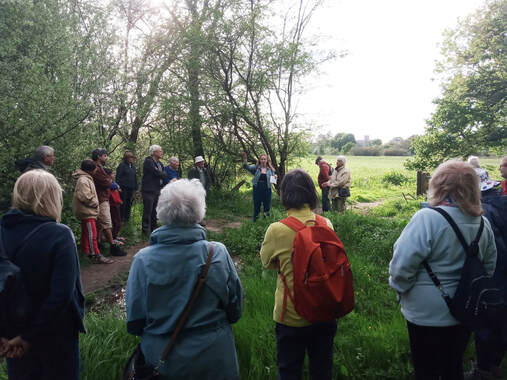
Rights of Way Walk and Talk:
Tuesday 10th May 6pm-8pm
We had lovely weather for an evening walk led by Lauren Grindley, exploring some of the rights of way between Fulford Main Street and the Ings.
Lauren was the perfect guide as she works as a Definitive Map Officer in the Rights of Way Department of York Council, so she was able to combine the historical aspects of her walk with helpful insights into the legalities associate with public footpaths.
Lauren has always been interested in maps and walking, and did an internship project after second year, investigating unrecorded rights of way in the city centre from Mark Jones’ Snickleways book. She loved the history and old maps of the city and learning about this niche part of the city history eg. Lady Peckett’s Yard, Penny Lane, Three Cranes Lane, long one called Coffee Yard from Grape Lane to Stonegate. “In my job I deal specifically with applications to record public rights of way (footpaths/bridleways etc) which means lots of research in old maps, RoW legislation and land registry deeds, etc.”
As we walked, Laura explained some of the history we walked through and the significance of the footpaths:
So what is a public right of way?
I always thought it was a commonly known word but turns out it’s an old word of Norse origin referring to water meadows and marshes, including those that were part of the Humber flood plain (hence it usually getting flooded!)
Follow the path along the edge of the Ings to Halfpenny Row
You can download Lauren's notes, maps and photographs HERE
**********************************************************************************************************************************
Tuesday 10th May 6pm-8pm
We had lovely weather for an evening walk led by Lauren Grindley, exploring some of the rights of way between Fulford Main Street and the Ings.
Lauren was the perfect guide as she works as a Definitive Map Officer in the Rights of Way Department of York Council, so she was able to combine the historical aspects of her walk with helpful insights into the legalities associate with public footpaths.
Lauren has always been interested in maps and walking, and did an internship project after second year, investigating unrecorded rights of way in the city centre from Mark Jones’ Snickleways book. She loved the history and old maps of the city and learning about this niche part of the city history eg. Lady Peckett’s Yard, Penny Lane, Three Cranes Lane, long one called Coffee Yard from Grape Lane to Stonegate. “In my job I deal specifically with applications to record public rights of way (footpaths/bridleways etc) which means lots of research in old maps, RoW legislation and land registry deeds, etc.”
As we walked, Laura explained some of the history we walked through and the significance of the footpaths:
So what is a public right of way?
- A highway that the public has the right to use at all times and can be a footpath, bridleway, restricted byway or a waterway.
- We would assume that Fenwick’s Lane is named after somebody called Fenwick so what do we know about them from history of Fulford?
- The Village Reading Rooms had been built by Robert Fenwick in 1873 and was open from 8am to 10pm.
- Gate Fulford Hall; then known as Fulford Grove, was acquired by Robert Fenwick in 1862 and it was he who called it Gate Fulford Hall and gave his name to the back lane.
- Fulford retains a classic medieval village layout of a linear (Main Street) of Tofts containing the dwellings (houses) and Crofts where the elongated agricultural enclosures at the back. This type of layout is thought to have developed from the 9th to 12th centuries.
- The names Folford, Foleforde and Fuletorp appear in the early records and although Fulford’s boundaries changed over time, and at one time even extended as far as the city walls and included what is now known as Walmgate stray, the 11th century village shape remains clearly visible on the 19th century map.
- The historic rights of way developed to allow people to move around the village and access the fields and meadows. RoW were important in the social history of an area and were therefore set out in Inclosure awards giving them a legal status.
- Robert Medd on the 1861 Census is shown as a cow keeper and shop keeper in the area close to Medd’s Lane. Family lived at 32 Main Street. Medd Lane was used for boatmen to reach the old pub from the River Ouse, the Wheatsheaf Inn as it was is now called the Dick Turpin Cottage.
- An example of how Rights of Way become established is from a house where the gardener had the right to walk a path the width of a wheelbarrow, still translated into land registry title deeds in 21st century, definitive map means that width and length are set out and are conclusive evidence of the rights that the public have.
I always thought it was a commonly known word but turns out it’s an old word of Norse origin referring to water meadows and marshes, including those that were part of the Humber flood plain (hence it usually getting flooded!)
Follow the path along the edge of the Ings to Halfpenny Row
- What do we know about Halfpenny Row?
- It could be that there was a common charge for overnight grazing by cattle (in particular) and there are many halfpenny lanes, fields.
- Could it also be that it was near the Pinfold where farmers had to pay (a halfpenny?) to release the stray animals?
- Joseph Halfpenny (1748-1811) was born the son of one of the archbishop's gardeners at Bishopthorpe and was at first apprenticed as a house painter in York. A collection of topographical drawings of the city was published in 1807. Halfpenny lived in Gillygate and was buried at St. Olave's.
- The name Halfpenny comes from the ancient Anglo-Saxon culture of Britain. It was a name for a person who because of his physical characteristics was referred to as Halfpenn. This person had a slim or slight build and was given this surname as a means of identity (could it be this related to a Halfpenny family in the area?)
- Halfpenny Field (in Elm near Peterborough) is so called from the contribution levied for the repair of a neighbouring dyke. This halfpenny Row is next to a drain/dyke so this could theoretically be the case?
You can download Lauren's notes, maps and photographs HERE
**********************************************************************************************************************************
18 June – Our Festival of Ideas Event
History of the Fulford Grange Estate - an Illustrated Talk by Christopher Rainger
History of the Fulford Grange Estate - an Illustrated Talk by Christopher Rainger
We usually hope to have a good audience for our FoI events and this year around 70 members and friends came to hear Chris Rainger's talk on the history of the area where he has lived for 27 years (longer than anywhere else!) Chris also led a tour of the Fulford Grange Estate the following Tuesday evening, where he pointed out some of the buildings and features he had shown in his talk.
Using a large number of illustrations, Chris described how the estate was created in 1774 by a York tea merchant, John Maud, and extended from New Walk Terrace almost to Alma Terrace, and from Fulford Road to the river Ouse. The mansion house is still there, standing grandly in the middle of Grange Garth, but its extensive grounds have been built over.
Several Lord Mayors and Sheriffs of York lived there, including Richard Hobson, who was embroiled in a scandal after he commandeered stones and other materials from the old council chamber and St William’s Chapel on Ouse Bridge, when they were demolished in 1802.
Two prominent Quaker families from Bradford; the Horner’s and the Harris’s, owned the estate from 1811 to 1868. Benjamin Horner began major changes to the mansion, building the grand Italianate east frontage and adding stables, coach houses, a cow house and other buildings. Pleasure gardens, orchards, vegetable plots and flower beds were planted, and glass houses erected for vines and other delicate fruit and vegetables. Horner also built a new carriage drive from Fulford Road and the pretty gatekeeper’s cottage on the corner of Fulford Road, and his ‘Gothick’ style gardener’s cottage is still a much admired feature of New Walk.
In 1868, the Harris family sold the estate to a Shambles butchers, Ambrose and John Walker. The brothers had also bought Fishergate House, off Blue Bridge Lane, and immediately began building villas along Fulford Road and an elegant terrace in New Walk Terrace. Ambrose Walker was the leading partner in the development and he also had contacts with other partners to run the Cattle Market and supply provisions to the Cavalry Barracks. He never married, but he was very close to his family and friends, leaving them generous gifts in his will.
Chris said he has not been able to find a photograph of him and is appealing for anyone who may be related to the Walker family to come forward if they think they may have one.
Ambrose Walker also developed villas and terraces along Fulford Road and Grange Street, creating a new entrance to the mansion. He sold the estate to grain merchant Isaac Poad in 1876. Soon after moving in, Isaac Poad built the Priory Hotel for his daughter, and in the 1880s, football and rugby games were played in the grounds, and tennis courts were available to hire.
At the end of the century, Poad moved out of the mansion to Beechwood, now Tower Vets on Fulford Road, and he filled most of the remaining parkland with the ‘Ryedale’ terraces, named after his birthplace in Hartoft.
In the first years of the 20th century, the gardens surrounding the house were used by the new owner, Alderman Bentley, for lavish garden parties to raise money for the County Hospital and other charities. Alderman Bentley died in office in 1907 and the streets were lined with mourners for his funeral.
Alderman Bentley’s wife, Anne remained in the mansion until 1929, when it was bought by a builder Robert Pulleyn and electrician, Harold Mandefield. The mansion was extended and divided into three separate apartments, and Grange Garth was built over the gardens. Today, the area is known as a very pleasant and friendly place to live.
FFH have published Chris Rainger's generously illustrated booklet on the Fulford Grange Estate and copies are available at meetings or via the Contact Us page of this website. The 85 page booklet costs £10
You can also download a copy HERE
************************************************************************************************************************************************
Using a large number of illustrations, Chris described how the estate was created in 1774 by a York tea merchant, John Maud, and extended from New Walk Terrace almost to Alma Terrace, and from Fulford Road to the river Ouse. The mansion house is still there, standing grandly in the middle of Grange Garth, but its extensive grounds have been built over.
Several Lord Mayors and Sheriffs of York lived there, including Richard Hobson, who was embroiled in a scandal after he commandeered stones and other materials from the old council chamber and St William’s Chapel on Ouse Bridge, when they were demolished in 1802.
Two prominent Quaker families from Bradford; the Horner’s and the Harris’s, owned the estate from 1811 to 1868. Benjamin Horner began major changes to the mansion, building the grand Italianate east frontage and adding stables, coach houses, a cow house and other buildings. Pleasure gardens, orchards, vegetable plots and flower beds were planted, and glass houses erected for vines and other delicate fruit and vegetables. Horner also built a new carriage drive from Fulford Road and the pretty gatekeeper’s cottage on the corner of Fulford Road, and his ‘Gothick’ style gardener’s cottage is still a much admired feature of New Walk.
In 1868, the Harris family sold the estate to a Shambles butchers, Ambrose and John Walker. The brothers had also bought Fishergate House, off Blue Bridge Lane, and immediately began building villas along Fulford Road and an elegant terrace in New Walk Terrace. Ambrose Walker was the leading partner in the development and he also had contacts with other partners to run the Cattle Market and supply provisions to the Cavalry Barracks. He never married, but he was very close to his family and friends, leaving them generous gifts in his will.
Chris said he has not been able to find a photograph of him and is appealing for anyone who may be related to the Walker family to come forward if they think they may have one.
Ambrose Walker also developed villas and terraces along Fulford Road and Grange Street, creating a new entrance to the mansion. He sold the estate to grain merchant Isaac Poad in 1876. Soon after moving in, Isaac Poad built the Priory Hotel for his daughter, and in the 1880s, football and rugby games were played in the grounds, and tennis courts were available to hire.
At the end of the century, Poad moved out of the mansion to Beechwood, now Tower Vets on Fulford Road, and he filled most of the remaining parkland with the ‘Ryedale’ terraces, named after his birthplace in Hartoft.
In the first years of the 20th century, the gardens surrounding the house were used by the new owner, Alderman Bentley, for lavish garden parties to raise money for the County Hospital and other charities. Alderman Bentley died in office in 1907 and the streets were lined with mourners for his funeral.
Alderman Bentley’s wife, Anne remained in the mansion until 1929, when it was bought by a builder Robert Pulleyn and electrician, Harold Mandefield. The mansion was extended and divided into three separate apartments, and Grange Garth was built over the gardens. Today, the area is known as a very pleasant and friendly place to live.
FFH have published Chris Rainger's generously illustrated booklet on the Fulford Grange Estate and copies are available at meetings or via the Contact Us page of this website. The 85 page booklet costs £10
You can also download a copy HERE
************************************************************************************************************************************************

16 July – An Afternoon Walk Among the Trees at the University of York West Campus
Some 15 of us met on the edge of the Campus Central Car Park under the shelter of a large Lime or Linden tree, which our guide, Dr Peter Mott, suggested had been part of the old Heslington Hall Estate. Peter was well qualified to lead us around this small part of the grounds near the Spring Lane Building, as he had specialised in Botany when studying Natural Sciences Tripos at Cambridge in the late 1960s.
As well as the dramatically shaped Yews in the formal part of the Hall gardens* there are also some old trees in the university grounds which date back to Lord Deramore's time.
However, most of the trees date from the mid 1960s, when the university grounds were landscaped to a high standard. As well as native British trees, a large number of exotic specimens were planted. Most are now well developed and provide a very tranquil environment for students and visitors.
In 2018, the Campus West landscape was listed Grade II, demonstrating the beginning of contemporary university planning in Britain, integrating status buildings and complementing the 17th-18th-Century designed landscape of Heslington Hall. Over the next 40 years ideas changed: it was part of the planning permission for Campus East built from 2002 to have entirely native species of plants, managed to maximise bio-diversity.
You can read Peter's notes on the trees HERE
* FFH member, Charles Patmore has just written an article abut the gardens of Heslington Hall -
Download it HERE
24 September - Local Flax Production:
Where was it grown an how was it manufactured into cloth
Dr Louise Wheatley used a wonderful display of illustrations to demonstrate the many labour-intensive processes needed to turn flax plants into the soft linen we enjoy wearing. You can read more about the 8 stages of turning flax into linen cloth HERE (hold your mouse over the pictures to read the caption)
Where was it grown an how was it manufactured into cloth
Dr Louise Wheatley used a wonderful display of illustrations to demonstrate the many labour-intensive processes needed to turn flax plants into the soft linen we enjoy wearing. You can read more about the 8 stages of turning flax into linen cloth HERE (hold your mouse over the pictures to read the caption)
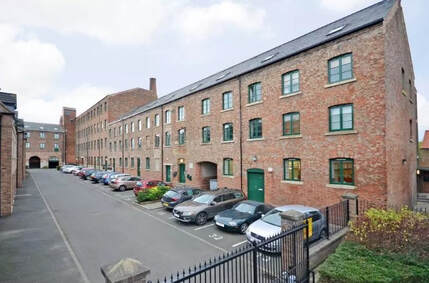 Lawrence Street Flax Mill after conversion into flats. Image: onthemarket.com
Lawrence Street Flax Mill after conversion into flats. Image: onthemarket.com
The memory of flax growing still echoes in place names around York; Lingcroft (near Naburn), Flaxton (near Strensall), Hemplands (Heworth), and in field names such as Linelands shown on the 1759 Enclosure map where the Sir John Hunt Cottage Homes are now on the corner of Fulford Road and St Oswald's Road.
There must have been a lot of flax grown around York. The huge mill off Lawrence Street (left) began life as a Linen Mill, and rope made from its fibres was stretched out along what is now Wellington Street.
Heslington Lane was once the home of Bleachfields Mill and the adjoining south sloping fields were use to dry the cloth. A drawing of 1710 by Francis Place looking south from Clifford's Tower (one of the pictures at the top of this page) shows St George's Field covered with strips of cloth, presumably locally made and laid out to dry.
There must have been a lot of flax grown around York. The huge mill off Lawrence Street (left) began life as a Linen Mill, and rope made from its fibres was stretched out along what is now Wellington Street.
Heslington Lane was once the home of Bleachfields Mill and the adjoining south sloping fields were use to dry the cloth. A drawing of 1710 by Francis Place looking south from Clifford's Tower (one of the pictures at the top of this page) shows St George's Field covered with strips of cloth, presumably locally made and laid out to dry.
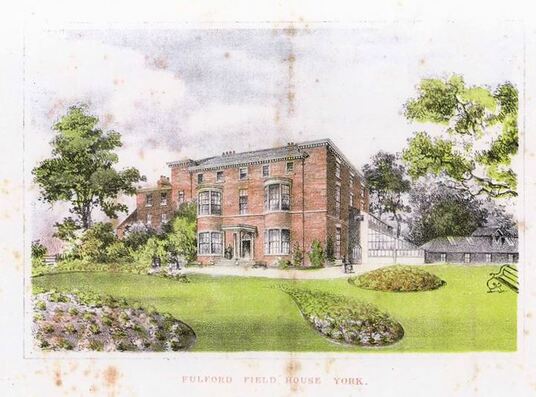
15 October
Fulford Field House -
Its owners and schools
Judy Nicholson and Barbara King gave us another of their wide ranging talks, this time on the lives of the people associated with the now demolished, Fulford Field House.
Walking south along Fulford Road, just after Aldi, you reach Fulford Cross, a small lane leading to a group of well-designed former council houses, the Steiner School and Danesgate School. On the corner is an unassuming brick cottage, but this was once the gatehouse for a grand 18th century Mansion, Fulford Field House. Pictured here later by one of the pupils of the ladies school
The estate occupied a plot which stretched down to the Ings and the lane was the carriage drive to the mansion.
The house was built around 1790 for William Ellis. The plot had been created from Fulford Field only some 30 years before, when the open fields of Fulford were enclosed and allocated to individual owners. William Ellis was from a wealthy family of merchants and his father (also William) is recorded as a Livery Lace Maker and Girth Weaver, making materials used in coaches and uniforms for coachmen. At one time, William senior was tenant of the Blue Boar Inn on Castle Street.
Our William Ellis married Ann Elizabeth Butler in Bloomsbury in 1779. They came back to York and he was Lord Mayor in 1799 and 1807, and appointed Alderman in 1823. Both William and Ann Elizabeth died in 1826, when the Leeds Intelligencer referred to William as a Chief Magistrate of York. One of their sons, a London lawyer, William Joseph (1781-1866) inherited Fulford Field House, along with the family businesses. He moved into the house with his wife Eliza Waddington and their seven children after his father’s death.
In September 1835, the Yorkshire Gazette carried an advertisement to let Fulford Field House fully furnished for one year. But just one week later, the York Herald advertised the house and contents for sale by auction. The advert says that as well as the household effects and furniture, horses, carriages, and a cellar of choice wins are to be sold. It was advertised again in the Liverpool Mail in August 1840. However, rather than being sold, it seems the house was let.
The house is advertised for sale again in the Leeds Intelligencer in 1848, and the tenant was named as Rev. Dr. Briggs, who was very instrumental in establishing the Catholic Church in Yorkshire.
Perhaps the problem finding buyers was that the house was too big and expensive to run, but its size made it ideal for use as a school. The first school was established in 1848 by new tenants, William and Sarah Howarth. They brought girls from their previous school in Holdgate, North Yorkshire, and advertised widely in newspapers, offering ‘instruction in English, French and German, piano, singing and dancing, calisthenics [described in the Oxford English Dictionary as "gymnastic exercises to achieve fitness and grace of movement"]. The house is delightfully and healthily situated (on gravel) one mile and a half from York, and has several acres of gardens and pleasure grounds.’
But the Howarth’s did not operate the school for long; they are recorded as sailing for Sydney on 20 May 1852. The school was taken over by William and Elizabeth Anne Armstrong, and Fulford Field House continued as a girls school, known as a ladys school under the leadership of Elizabeth Armstrong.
An advertisement in the Stamford Mercury on 12 June 1852, described how ‘Mrs Armstrong will be assisted by English and foreign resident governesses and masters of acknowledged ability. The pupils, in addition to sound mental culture, are instructed in every necessary accomplishment. The terms of the board are; pupils under 12 years of age, 18 guineas, above 12 years, 20 guineas.’
Fulford Field House -
Its owners and schools
Judy Nicholson and Barbara King gave us another of their wide ranging talks, this time on the lives of the people associated with the now demolished, Fulford Field House.
Walking south along Fulford Road, just after Aldi, you reach Fulford Cross, a small lane leading to a group of well-designed former council houses, the Steiner School and Danesgate School. On the corner is an unassuming brick cottage, but this was once the gatehouse for a grand 18th century Mansion, Fulford Field House. Pictured here later by one of the pupils of the ladies school
The estate occupied a plot which stretched down to the Ings and the lane was the carriage drive to the mansion.
The house was built around 1790 for William Ellis. The plot had been created from Fulford Field only some 30 years before, when the open fields of Fulford were enclosed and allocated to individual owners. William Ellis was from a wealthy family of merchants and his father (also William) is recorded as a Livery Lace Maker and Girth Weaver, making materials used in coaches and uniforms for coachmen. At one time, William senior was tenant of the Blue Boar Inn on Castle Street.
Our William Ellis married Ann Elizabeth Butler in Bloomsbury in 1779. They came back to York and he was Lord Mayor in 1799 and 1807, and appointed Alderman in 1823. Both William and Ann Elizabeth died in 1826, when the Leeds Intelligencer referred to William as a Chief Magistrate of York. One of their sons, a London lawyer, William Joseph (1781-1866) inherited Fulford Field House, along with the family businesses. He moved into the house with his wife Eliza Waddington and their seven children after his father’s death.
In September 1835, the Yorkshire Gazette carried an advertisement to let Fulford Field House fully furnished for one year. But just one week later, the York Herald advertised the house and contents for sale by auction. The advert says that as well as the household effects and furniture, horses, carriages, and a cellar of choice wins are to be sold. It was advertised again in the Liverpool Mail in August 1840. However, rather than being sold, it seems the house was let.
The house is advertised for sale again in the Leeds Intelligencer in 1848, and the tenant was named as Rev. Dr. Briggs, who was very instrumental in establishing the Catholic Church in Yorkshire.
Perhaps the problem finding buyers was that the house was too big and expensive to run, but its size made it ideal for use as a school. The first school was established in 1848 by new tenants, William and Sarah Howarth. They brought girls from their previous school in Holdgate, North Yorkshire, and advertised widely in newspapers, offering ‘instruction in English, French and German, piano, singing and dancing, calisthenics [described in the Oxford English Dictionary as "gymnastic exercises to achieve fitness and grace of movement"]. The house is delightfully and healthily situated (on gravel) one mile and a half from York, and has several acres of gardens and pleasure grounds.’
But the Howarth’s did not operate the school for long; they are recorded as sailing for Sydney on 20 May 1852. The school was taken over by William and Elizabeth Anne Armstrong, and Fulford Field House continued as a girls school, known as a ladys school under the leadership of Elizabeth Armstrong.
An advertisement in the Stamford Mercury on 12 June 1852, described how ‘Mrs Armstrong will be assisted by English and foreign resident governesses and masters of acknowledged ability. The pupils, in addition to sound mental culture, are instructed in every necessary accomplishment. The terms of the board are; pupils under 12 years of age, 18 guineas, above 12 years, 20 guineas.’
One of Mrs Armstrong’s sons, Francis Melbourne Armstrong, established a boys school at 12 A&B New Walk Terrace in c.1877. These houses were built in 1824 and had been combined to make one large property. An advert for the girls school in the Berwick Advertiser in July 1909 described this as a ‘branch for boys’.
Elizabeth Armstrong advertised Fulford Field House for sale or to let in December 1911, having run the school since 1852. She died in June 1912.
In September 1913, York Council applied to the Local Government Board to borrow £2,450 to purchase part of the estate for the purposes of an open-air school and extension of the tramway sheds. It was at this time that the houses were built for tramway employees.
After the Great War, the council’s education committee agreed to ‘adapt Fulford Field House as a school for mentally defective children and the erection of an open-air school for physical defectives.’ This language is abhorrent today but the sentiment continues, with the new school serving children needing special help outside the conventional school system.
Secondary education was reorganised after the Second World War, and for a brief period until construction of Fulford School in 1956, Danesmead replaced the Senior Department of Fishergate School. Read more HERE
You can read more about York's Special Schools on the British History website HERE
And an article by Stephen Lewis in the York Press about the Outdoor School - HERE
Elizabeth Armstrong advertised Fulford Field House for sale or to let in December 1911, having run the school since 1852. She died in June 1912.
In September 1913, York Council applied to the Local Government Board to borrow £2,450 to purchase part of the estate for the purposes of an open-air school and extension of the tramway sheds. It was at this time that the houses were built for tramway employees.
After the Great War, the council’s education committee agreed to ‘adapt Fulford Field House as a school for mentally defective children and the erection of an open-air school for physical defectives.’ This language is abhorrent today but the sentiment continues, with the new school serving children needing special help outside the conventional school system.
Secondary education was reorganised after the Second World War, and for a brief period until construction of Fulford School in 1956, Danesmead replaced the Senior Department of Fishergate School. Read more HERE
You can read more about York's Special Schools on the British History website HERE
And an article by Stephen Lewis in the York Press about the Outdoor School - HERE
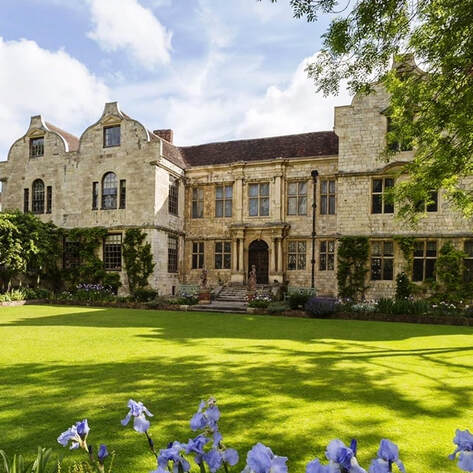
19 November - The Determined Women of Minster Yard
One of our popular speakers, Glennis Whyte, spoke to a full meeting of 55-60 members and friends about three single women forging their independent path in science, literature and the arts. Glennis has kindly provide the following summary of her talk:
When visiting National Trust property Treasurer’s House in the heart of York, one hears the story of the last private owner, Frank Green, who resided in and restored the house between 1897 and 1930. It is, after all, his design, his furniture and antiques that we will see. But through the centuries there have been numerous other people living on that site either temporarily or for the longer term.
As a National Trust volunteer, I learned of three such residents whose lives overlapped in the 18th century – Jane Squire, Sarah Scott (nee Robinson) and Anne Morritt.
All three women faced barriers to their participation in traditionally male dominated fields – the arts, literature and science. It was an era which still sought to deny women a voice, let alone a formal education or legal independence once married.
Jane Squire (1686-1743) from a prominent Yorkshire family, came to own the house after her parents’ death and subsequently rented it out and then sold it to the Robinson family. Jane sought her fortune in London where aristocratic businessmen such as Lord Harley encouraged her to invest in marine salvage schemes. But that ill advice meant Jane became bankrupt. Her attempt to sue Harley and associates was denied because she was Catholic and she was sentenced to three harsh years in debtors’ prison. After release (although still in debt) she saw that one potential source of money was the Government prize (or “Reward”) for discovering a way of measuring Longitude. Extensive study culminated in her becoming the only woman to submit scientific proposals for solving the Longitude problem. Another woman, Elizabeth Johnson, also made a submission but her ideas lacked any scientific methodology. In fact, Jane’s ideas were totally impractical, but they were based on astronomical and mathematical calculations and she is still internationally known as The Lady of the Longitude. Sadly her theories were ignored by commissioners judging the entries, and she died penniless and seemingly without family support. She is however remembered today as a woman who sought to challenge the male domination of scientific discovery.
The Robinsons, an equally prestigious family used Treasurer’s as their foothold in York during the winter high society season. Of the family, the two daughters, Elizabeth and Sarah, gained the most fame. The elder became Elizabeth Montagu, the foremost society hostess of the late 18th century and co-founder of the Bluestocking movement. Younger sister Sarah (1720-1795), stricken by smallpox, sought to make her way by earning a living – a shocking act to her high society peers. She also scandalised them by living with her beloved friend Barbara, ‘Lady Bab’, training the poor to market their skills, setting up Sunday schools and self-help groups especially for women out of employment. Further, Sarah wrote and published nine books - some fictional, some historical, to support themselves. A very brief and disastrous marriage saw Sarah take the name of Scott but afterwards Lady Bab and Sarah settled again to their work near Bath. When Lady Bab died, Sarah and friends experimented becoming a household of women, self-sufficient and financially independent, but the project failed. Sarah Scott’s work is now considered to be of merit, coming from an era where the novel was an emerging literary form.
Bacon Morritt, a well-known historical figure in 18th century York and the Selby area, bought Treasurer’s House from the Robinsons. His daughters lived there for several years and were known for their skilled needlework. Embroidery and other hand-craft became an alternative for many women who could not find sponsorship and acceptance as painters. Women were not encouraged to be artists. One sister, Anne Morritt (1726-1797), became especially renowned for her ‘needle painting’, that is, recreating in thread the old masters in the galleries. Moving to Rokeby Park to join her brother, her works were viewed by visitors such as Wordsworth, who spoke of her genius. However years of working at a frame (with only natural or candle light) affected Anne’s health and as poet Robert Southey wrote, “the needle literally dropt from her hand”. She is remembered by a memorial in Selby Abbey.
There are others who once lived in Minster Yard whose stories are being revealed so in future we can share their experiences of York centuries ago.
One of our popular speakers, Glennis Whyte, spoke to a full meeting of 55-60 members and friends about three single women forging their independent path in science, literature and the arts. Glennis has kindly provide the following summary of her talk:
When visiting National Trust property Treasurer’s House in the heart of York, one hears the story of the last private owner, Frank Green, who resided in and restored the house between 1897 and 1930. It is, after all, his design, his furniture and antiques that we will see. But through the centuries there have been numerous other people living on that site either temporarily or for the longer term.
As a National Trust volunteer, I learned of three such residents whose lives overlapped in the 18th century – Jane Squire, Sarah Scott (nee Robinson) and Anne Morritt.
All three women faced barriers to their participation in traditionally male dominated fields – the arts, literature and science. It was an era which still sought to deny women a voice, let alone a formal education or legal independence once married.
Jane Squire (1686-1743) from a prominent Yorkshire family, came to own the house after her parents’ death and subsequently rented it out and then sold it to the Robinson family. Jane sought her fortune in London where aristocratic businessmen such as Lord Harley encouraged her to invest in marine salvage schemes. But that ill advice meant Jane became bankrupt. Her attempt to sue Harley and associates was denied because she was Catholic and she was sentenced to three harsh years in debtors’ prison. After release (although still in debt) she saw that one potential source of money was the Government prize (or “Reward”) for discovering a way of measuring Longitude. Extensive study culminated in her becoming the only woman to submit scientific proposals for solving the Longitude problem. Another woman, Elizabeth Johnson, also made a submission but her ideas lacked any scientific methodology. In fact, Jane’s ideas were totally impractical, but they were based on astronomical and mathematical calculations and she is still internationally known as The Lady of the Longitude. Sadly her theories were ignored by commissioners judging the entries, and she died penniless and seemingly without family support. She is however remembered today as a woman who sought to challenge the male domination of scientific discovery.
The Robinsons, an equally prestigious family used Treasurer’s as their foothold in York during the winter high society season. Of the family, the two daughters, Elizabeth and Sarah, gained the most fame. The elder became Elizabeth Montagu, the foremost society hostess of the late 18th century and co-founder of the Bluestocking movement. Younger sister Sarah (1720-1795), stricken by smallpox, sought to make her way by earning a living – a shocking act to her high society peers. She also scandalised them by living with her beloved friend Barbara, ‘Lady Bab’, training the poor to market their skills, setting up Sunday schools and self-help groups especially for women out of employment. Further, Sarah wrote and published nine books - some fictional, some historical, to support themselves. A very brief and disastrous marriage saw Sarah take the name of Scott but afterwards Lady Bab and Sarah settled again to their work near Bath. When Lady Bab died, Sarah and friends experimented becoming a household of women, self-sufficient and financially independent, but the project failed. Sarah Scott’s work is now considered to be of merit, coming from an era where the novel was an emerging literary form.
Bacon Morritt, a well-known historical figure in 18th century York and the Selby area, bought Treasurer’s House from the Robinsons. His daughters lived there for several years and were known for their skilled needlework. Embroidery and other hand-craft became an alternative for many women who could not find sponsorship and acceptance as painters. Women were not encouraged to be artists. One sister, Anne Morritt (1726-1797), became especially renowned for her ‘needle painting’, that is, recreating in thread the old masters in the galleries. Moving to Rokeby Park to join her brother, her works were viewed by visitors such as Wordsworth, who spoke of her genius. However years of working at a frame (with only natural or candle light) affected Anne’s health and as poet Robert Southey wrote, “the needle literally dropt from her hand”. She is remembered by a memorial in Selby Abbey.
There are others who once lived in Minster Yard whose stories are being revealed so in future we can share their experiences of York centuries ago.
A Report on this meeting will be added shortly
15 October – An illustrated talk on on the Armstrong family schools at Fulford Field House (now Danesgate School) and Melbourne House (now 13 New Walk Terrace) - by Judy Nicholson and Barbara King
15 October – An illustrated talk on on the Armstrong family schools at Fulford Field House (now Danesgate School) and Melbourne House (now 13 New Walk Terrace) - by Judy Nicholson and Barbara King
2021 Events
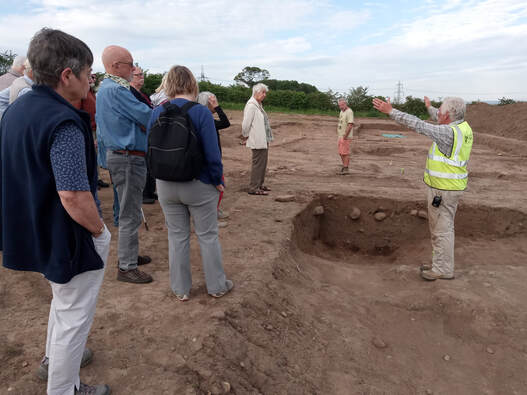
15 June - an evening visit to the archaeological investigations at Heslington East Campus,
led by Steve Roskums and Al Oswald.
This was our first event since Covid-19 restrictions curtailed our activities in March 2020 and some 30 members gathered on the hill overlooking the University Sports Centre to see the latest phase of archaeological investigations which have preceded building work on the new campus. Members were shown around the excavations, where the outline of a number of rectangular and circular buildings were visible.
Earlier excavations have found evidence of people taking advantage of the springs emitting from the higher ground around Kimberlow Hill. Hunter-gatherers have dropped flint arrow heads and evidence has been found of Neolithic, Bronze Age and Iron Age settlements and Roman and medieval farming.
Roman coin hoards have also been found (see our web-page about the pot containing 2,800 coins, discovered when the university library was built HERE)
You can download a booklet on the Heslington East investigations HERE and a detailed archaeological report HERE
The most stunning discovery is a 2600 year old human brain, the oldest ever found! You can read more about it HERE.
Click HERE to watch a video of archaeologists at work on the site.
*************************************************************************************************************************************************
led by Steve Roskums and Al Oswald.
This was our first event since Covid-19 restrictions curtailed our activities in March 2020 and some 30 members gathered on the hill overlooking the University Sports Centre to see the latest phase of archaeological investigations which have preceded building work on the new campus. Members were shown around the excavations, where the outline of a number of rectangular and circular buildings were visible.
Earlier excavations have found evidence of people taking advantage of the springs emitting from the higher ground around Kimberlow Hill. Hunter-gatherers have dropped flint arrow heads and evidence has been found of Neolithic, Bronze Age and Iron Age settlements and Roman and medieval farming.
Roman coin hoards have also been found (see our web-page about the pot containing 2,800 coins, discovered when the university library was built HERE)
You can download a booklet on the Heslington East investigations HERE and a detailed archaeological report HERE
The most stunning discovery is a 2600 year old human brain, the oldest ever found! You can read more about it HERE.
Click HERE to watch a video of archaeologists at work on the site.
*************************************************************************************************************************************************
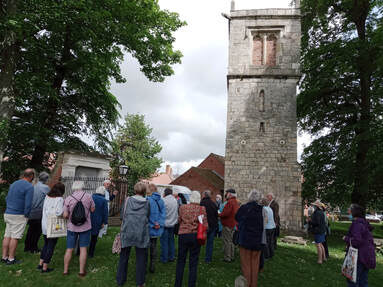
19 June - A visit to the historic churchyard of St Lawrence led by Martin Marsh.
Just a few days after the Heslington archaeology visit, we had another happy gathering in the churchyard of St Lawrence Church in Lawrence Street where we saw the 12th century tower, with its beautifully carved Norman door and the recently restored Rigg Memorial, which was built in 1830 by public subscription to commemorate six children who died in a boating accident.
The parish used to include parts of Heslington and some of the oldest gravestones in the churchyard lie on the site of the demolished nave and chancel, and include tombs of the Heskeths and Yarburghs of Heslington Hall. We also looked at the Almshouses, Ellen Wilson's Hospital, built and endowed by John Sykes in 1894. The hospital consisted of six single storey dwellings on Lawrence Street in York, intended for use by aged or infirm women born or resident in St Lawrence's parish. No religious test was necessary for admission and residents received a stipend of eight shillings per week.
The old church was demolished in 1881–83 and is the second-largest religious building in York after York Minster. The spire was added in 1891–3. The church contains the elaborate c.1400 font, moved from the old church. Much of the stained glass was produced by the Knowles family of Stonegate, including the recently restored east window.
There is a very unusual and large art deco First World War memorial window depicting the Somme battlefield, the city of York, and a knight and grail cup, designed in 1929 by Joan Fulleylove. The chancel area was remodelled by Robert 'Mousey' Thompson of Kilburn as a Second World War memorial. The feel of the church has recently been greatly improved by redecoration and other improvements, including installation of a new organ, installed in 2020 after being removed from St Michael le Belfry. It was built in 1885 and restored by Nicholson's of Malvern.
**************************************************************************************************************************************************
Just a few days after the Heslington archaeology visit, we had another happy gathering in the churchyard of St Lawrence Church in Lawrence Street where we saw the 12th century tower, with its beautifully carved Norman door and the recently restored Rigg Memorial, which was built in 1830 by public subscription to commemorate six children who died in a boating accident.
The parish used to include parts of Heslington and some of the oldest gravestones in the churchyard lie on the site of the demolished nave and chancel, and include tombs of the Heskeths and Yarburghs of Heslington Hall. We also looked at the Almshouses, Ellen Wilson's Hospital, built and endowed by John Sykes in 1894. The hospital consisted of six single storey dwellings on Lawrence Street in York, intended for use by aged or infirm women born or resident in St Lawrence's parish. No religious test was necessary for admission and residents received a stipend of eight shillings per week.
The old church was demolished in 1881–83 and is the second-largest religious building in York after York Minster. The spire was added in 1891–3. The church contains the elaborate c.1400 font, moved from the old church. Much of the stained glass was produced by the Knowles family of Stonegate, including the recently restored east window.
There is a very unusual and large art deco First World War memorial window depicting the Somme battlefield, the city of York, and a knight and grail cup, designed in 1929 by Joan Fulleylove. The chancel area was remodelled by Robert 'Mousey' Thompson of Kilburn as a Second World War memorial. The feel of the church has recently been greatly improved by redecoration and other improvements, including installation of a new organ, installed in 2020 after being removed from St Michael le Belfry. It was built in 1885 and restored by Nicholson's of Malvern.
**************************************************************************************************************************************************
17 July - Unveiling of an information plaque at the Ordnance Railway on New Walk by Andrew Scott, CBE, former director of the Railway Museum.
Thanks to a grant from Fishergate Ward and joint funding between FFH and the Friends of New Walk, a small information plaque has been fixed to the wall of the former Ordnance Depot on New Walk, near to Hospital Fields Road and Millennium Bridge.
Passers-by will now be able to understand why there are narrow gauge railway tracks crossing New Walk and branching and curving near the river, where a crane used to unload ships bringing munitions to the depot from Woolwich Arsenal in London.
A small crowd gathered to see the display of photographs, maps and other information and hear Andrew Scott explain the reason for the tracks before releasing the embroidered the FFH banner (made by Louise Wheatley) to uncover the plaque.
Read about the Ordnance Depot HERE
Thanks to a grant from Fishergate Ward and joint funding between FFH and the Friends of New Walk, a small information plaque has been fixed to the wall of the former Ordnance Depot on New Walk, near to Hospital Fields Road and Millennium Bridge.
Passers-by will now be able to understand why there are narrow gauge railway tracks crossing New Walk and branching and curving near the river, where a crane used to unload ships bringing munitions to the depot from Woolwich Arsenal in London.
A small crowd gathered to see the display of photographs, maps and other information and hear Andrew Scott explain the reason for the tracks before releasing the embroidered the FFH banner (made by Louise Wheatley) to uncover the plaque.
Read about the Ordnance Depot HERE
20th July -An evening walk over Walmgate Stray led by Al Oswald.
Click HERE and HERE to watch Al's two videos on Walmgate Stray's historic landscape
**************************************************************************************************************************************************
Click HERE and HERE to watch Al's two videos on Walmgate Stray's historic landscape
**************************************************************************************************************************************************
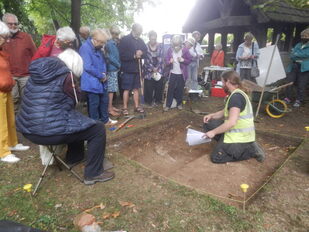
5 August - St Oswald's Feast Day!
York Archaeological Trust held their annual training dig at the old church of St Oswald in Fulford and FFH members paid a visit to see what had been discovered. The excavations were near the lych gate and were intended to try and locate some buildings relating to Well House, which stood in the area before the churchyard was expanded in 1879. The work was rather hampered by very hard ground and tree roots, but they did find foundations and some medieval and Roman pottery. It is hoped that YAT will return next summer to continue their investigations.
You can read all about the history of St Oswald's HERE
**************************************************************************************************************************************************
York Archaeological Trust held their annual training dig at the old church of St Oswald in Fulford and FFH members paid a visit to see what had been discovered. The excavations were near the lych gate and were intended to try and locate some buildings relating to Well House, which stood in the area before the churchyard was expanded in 1879. The work was rather hampered by very hard ground and tree roots, but they did find foundations and some medieval and Roman pottery. It is hoped that YAT will return next summer to continue their investigations.
You can read all about the history of St Oswald's HERE
**************************************************************************************************************************************************
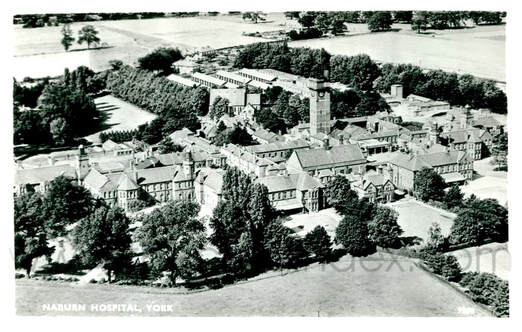 Aerial view of Naburn Hospital.
Image from a private collection
Aerial view of Naburn Hospital.
Image from a private collection
18 September - Who's Who, What's What and What's Next - Fulford South; Hospitals, Manors, PoW's, Farms, Golf, Orchards, Shopping! Presented by Barbara King and Judy Nicholson
A very appropriate title for our first indoor meeting together since February 2020, and a topic Judy and Barbara have been researching for some years.
Judy and Barbara talked about their research of the roughly a triangular piece of land between Naburn Lane, the Selby Road (A19) and the back lane leading to Lincroft Hall, now the site of the Designer Outlet.
It was originally arable land belonging to local landowners; the Key's of Water Fulford Hall, and the Dickinsons from Naburn.
The surrounding area was also home to many prominent families who may (or may not) have been concerned about the building of the Asylum being built by “Big Brother” York City Council, just down the road. These local families have interesting stories and were used here as an introduction to the area and the background to our talk.
Planning for the asylum began in 1897 and it was opened in 1906 in the area of two Lords of the Manor – Water Fulford and Naburn – close neighbours. Between 1899 and 1906 arrangements were made with Bootham and Clifton Asylum Authorities for them to continue the care of those who would eventually move to the new York City Asylum. The hospital opened on Wednesday 4th April 1906 as the York City Asylum
Thanks to numerous donations of photographs from past employees and locals, an informative presentation was put together, charting its history from 1906 to the closure in February 1988.
As well as an Asylum, the site was developed as a POW camp, a maternity hospital, wards for gynaecology, dermatology and two geriatric wards for men and women. After the closure of the hospital, the site was developed as a retail outlet. The old hospital orchard taken over by a group of enthusiasts who continue to develop and replant the plot.
Who knows what the next phase of development will be?
*************************************************************************************************************************************************
A very appropriate title for our first indoor meeting together since February 2020, and a topic Judy and Barbara have been researching for some years.
Judy and Barbara talked about their research of the roughly a triangular piece of land between Naburn Lane, the Selby Road (A19) and the back lane leading to Lincroft Hall, now the site of the Designer Outlet.
It was originally arable land belonging to local landowners; the Key's of Water Fulford Hall, and the Dickinsons from Naburn.
The surrounding area was also home to many prominent families who may (or may not) have been concerned about the building of the Asylum being built by “Big Brother” York City Council, just down the road. These local families have interesting stories and were used here as an introduction to the area and the background to our talk.
Planning for the asylum began in 1897 and it was opened in 1906 in the area of two Lords of the Manor – Water Fulford and Naburn – close neighbours. Between 1899 and 1906 arrangements were made with Bootham and Clifton Asylum Authorities for them to continue the care of those who would eventually move to the new York City Asylum. The hospital opened on Wednesday 4th April 1906 as the York City Asylum
Thanks to numerous donations of photographs from past employees and locals, an informative presentation was put together, charting its history from 1906 to the closure in February 1988.
As well as an Asylum, the site was developed as a POW camp, a maternity hospital, wards for gynaecology, dermatology and two geriatric wards for men and women. After the closure of the hospital, the site was developed as a retail outlet. The old hospital orchard taken over by a group of enthusiasts who continue to develop and replant the plot.
Who knows what the next phase of development will be?
*************************************************************************************************************************************************
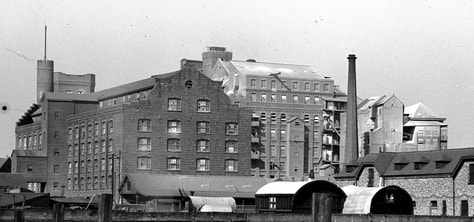
16 October - Our delayed Annual General Meeting, including agreement of our new constitution, read it HERE
You can read our Chairman's Report HERE
Our Chairman since 2014, Chris Rainger, handed over the role to Louise Wheatley, and she passed the treasurer's role to Peter Mott. All the Steering Committee members agreed to continue serving and after the meeting, Laura Grindley volunteered to join too.
After the AGM, Rob Shorland-Ball gave an illustrated talk: Henry Leetham’s Anglo-Hungarian Roller Flour Mills in Hungate from c1859 to 1930.
Rob described how Henry Leetham travelled to Hungary to study their huge mills housing the new roller-milling technology and returned to built a massive complex of roller mills, huge silos and the storage warehouse we now know as Rowntree Wharf, the last remaining building on the site. This 1914 photograph from the Evelyn Collection shows Rowntree Wharf with Leetham's mill complex to the right, as seen from near Red Tower on Foss Islands Road.
The mill and warehouse were adjacent to the Foss Navigation and Leetham persuaded the city corporation to enlarge Castle Mills Lock to allow much bigger barges to reach his wharves. Housing for the workers was notoriously bad and was among the first to be demolished when York began its slum clearance. The site has recently been redeveloped again with flats.
**************************************************************************************************************************************************
You can read our Chairman's Report HERE
Our Chairman since 2014, Chris Rainger, handed over the role to Louise Wheatley, and she passed the treasurer's role to Peter Mott. All the Steering Committee members agreed to continue serving and after the meeting, Laura Grindley volunteered to join too.
After the AGM, Rob Shorland-Ball gave an illustrated talk: Henry Leetham’s Anglo-Hungarian Roller Flour Mills in Hungate from c1859 to 1930.
Rob described how Henry Leetham travelled to Hungary to study their huge mills housing the new roller-milling technology and returned to built a massive complex of roller mills, huge silos and the storage warehouse we now know as Rowntree Wharf, the last remaining building on the site. This 1914 photograph from the Evelyn Collection shows Rowntree Wharf with Leetham's mill complex to the right, as seen from near Red Tower on Foss Islands Road.
The mill and warehouse were adjacent to the Foss Navigation and Leetham persuaded the city corporation to enlarge Castle Mills Lock to allow much bigger barges to reach his wharves. Housing for the workers was notoriously bad and was among the first to be demolished when York began its slum clearance. The site has recently been redeveloped again with flats.
**************************************************************************************************************************************************
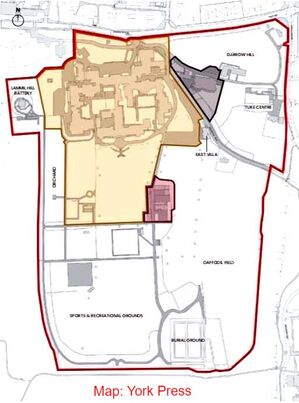
20 November - Dr. Mark McFetridge: Everyone must remember they are not dealing with cases but with people; The Retreat York 1947-2018
The talk was given by Dr Mark McFetridge who was Senior Consulting Clinical Psychologist at the Retreat and worked there from its Bicentenary in 1996 until the closure of inpatient services in 2018.
He began by recounting the inception of the Retreat in 1796. York Quakers had been dismayed by the death of a York Quaker woman who had become a patient at the secretive York Asylum. They sought to create better form of mental hospital for the Quaker community, hence raised funds, purchased the 11-acre site and designed their own buildings. They envisaged the Retreat as 'a quiet haven where a shattered barque may find shelter or rescue'.
Soon it became known for the success of its carefully nurtured environment which systematically supported patients’ morale and encouraged them to control troubled behaviour themselves without doctors or medicine playing much part. In 1813 Samuel Tuke, grandson of the Retreat’s founder William Tuke, produced a detailed book of guidance, A Description of The Retreat, which influenced development of mental health services in many countries.
Mark pointed out that Samuel Tuke’s book, which is very readable, is now available on-line. He mentioned another famous book, Anne Digby’s Madness, Morality and Medicine: a study of the York Retreat 1796 – 1914, which covers the later transition of the Retreat into a larger, more conventional hospital where many well-off non-Quakers were admitted to subsidise fees for poorer Quaker patients. At the end of this report are links to on-line resources re the Retreat’s history.
Next Mark fast-forwarded to a snapshot of the Retreat just after World War II, around its 150th anniversary, drawing on information in Annual Reports. He expressed surprise at how much the Retreat had adopted the formidable new physical treatments of that era. There were two hundred plus patients, mostly on compulsory orders, and many were being treated with electro-convulsive therapy and some through insulin comas. In 1946 there were even 11 patients who received leucotomy, a recently invented, drastic brain operation which nowadays is strongly criticised. Alongside such medical treatments Quaker values were still in operation. “We still believe”, the 1946 Annual Report declared, “the distinctive contribution of the Retreat is based on faith in the healing power and love of God over-riding all forms of physio and psycho-therapy.” Mark showed an extract from a 1954 recruitment film for the Retreat’s nurse training school. It conveyed how the Retreat’s everyday environment contributed to recovery - tennis and dancing and the Retreat’s very own swimming pool.
A shock event during those years was the 1952 crash of a Gloster Meteor, Britain’s first jet fighter aircraft, into the Retreat’s recreation hall building. Mark showed photos of the damage. By chance no-one beside the pilot was killed. Such were these planes’ little publicised technical problems, he said, that an astonishing 890 Meteors crashed with the loss of 450 pilots, 145 in 1953 alone. (Those of us who felt safe during Meteor fly-pasts at 1950s air shows can think again!)
Another impactful event of the immediate post-war era was the 1947 decision not to join the new National Health Service. This meant the Retreat could still shape its own path as long as it could attract enough private patients or individuals funded by NHS Health Authorities for types of help not available elsewhere.
For the final part of the event, Mark again fast-forwarded - to the Retreat’s bi-centenary in 1996 and the period since then. He was joined by two former service users of the Acorn Programme in the last years of the Retreat who described their experiences. The Acorn Programme ran from 1999 till 2018 and was one of the Retreat’s initiatives to provide specialised services, rarely available elsewhere, which would attract NHS funding for individual placements. It was set up as a ‘therapeutic community’ for women who physically self-harmed following spells of intensely painful emotions. The Acorn Programme aimed to teach alternative ways to manage painful emotions through addressing them as they arose during everyday life at the Retreat. It could, Mark said, sound like a return to the early ideas of the Retreat during the Tukes’ era. Retreat staff had not intended this but they certainly noticed the parallels and indeed had written a journal paper on connections with the ‘Moral Treatment’ approach at the early Retreat. Around 260 people had passed through the Acorn Programme in total, typically for stays of 8 – 12 months.
According to the two former service users, the Retreat’s Acorn Programme was very different to other mental health units which they had experienced. Everyone got to know everyone else’s problems, got to know what made them worse and what fellow service users needed to do to help them – instead of such information staying private and solely the business of staff. Whereas at other mental health units treatments were administered to you, at Acorn you needed to put your own effort into treatment. Medication was regarded as a last resort, to be avoided if possible, they said.
A key feature at Acorn was a system called ‘Dialectical Behaviour Therapy’ which made you study the chain of events leading up to your problem behaviour – what started it? how did it affect other people? how could you have acted differently? People could apply this – or get encouraged to apply this – when everyday incidents in living together at the Retreat touched on a raw nerve for someone. Dialectical Behaviour Therapy supplied ideas for coping strategies which service users could try for themselves.
There was fun too as part of the Acorn Programme and interesting tasks and hobbies, depending on the individual. Gardening in the Retreat’s grounds and growing massive sunflowers was one example mentioned. Another was keeping your own pets while at the Retreat in the pets’ corner there. Other examples were writing for the Retreat magazine and exercise in the Retreat’s beautiful grounds. Such opportunities may be unlikely in mental health units elsewhere nowadays but, as Mark pointed out, pastimes which engage people’s minds, tame animals and birds to make friends with, and space for exercise or for interesting work were all detailed loud and clear in the book by Samuel Tuke way back in 1813.
For further information
Watch the video of Mark McFetridge’s talk: HERE
Download a PDF of Samuel Tuke’s 1813 Description of the Retreat HERE
View online the Retreat’s Annual Reports 1796-1996 HERE These are part of the Retreat Archive, available at York’s Borthwick Institute.
Some other Retreat Archive documents are also: HERE
On this American Quaker website, read how the Retreat’s example inspired early asylums in the new USA: HERE
The talk was given by Dr Mark McFetridge who was Senior Consulting Clinical Psychologist at the Retreat and worked there from its Bicentenary in 1996 until the closure of inpatient services in 2018.
He began by recounting the inception of the Retreat in 1796. York Quakers had been dismayed by the death of a York Quaker woman who had become a patient at the secretive York Asylum. They sought to create better form of mental hospital for the Quaker community, hence raised funds, purchased the 11-acre site and designed their own buildings. They envisaged the Retreat as 'a quiet haven where a shattered barque may find shelter or rescue'.
Soon it became known for the success of its carefully nurtured environment which systematically supported patients’ morale and encouraged them to control troubled behaviour themselves without doctors or medicine playing much part. In 1813 Samuel Tuke, grandson of the Retreat’s founder William Tuke, produced a detailed book of guidance, A Description of The Retreat, which influenced development of mental health services in many countries.
Mark pointed out that Samuel Tuke’s book, which is very readable, is now available on-line. He mentioned another famous book, Anne Digby’s Madness, Morality and Medicine: a study of the York Retreat 1796 – 1914, which covers the later transition of the Retreat into a larger, more conventional hospital where many well-off non-Quakers were admitted to subsidise fees for poorer Quaker patients. At the end of this report are links to on-line resources re the Retreat’s history.
Next Mark fast-forwarded to a snapshot of the Retreat just after World War II, around its 150th anniversary, drawing on information in Annual Reports. He expressed surprise at how much the Retreat had adopted the formidable new physical treatments of that era. There were two hundred plus patients, mostly on compulsory orders, and many were being treated with electro-convulsive therapy and some through insulin comas. In 1946 there were even 11 patients who received leucotomy, a recently invented, drastic brain operation which nowadays is strongly criticised. Alongside such medical treatments Quaker values were still in operation. “We still believe”, the 1946 Annual Report declared, “the distinctive contribution of the Retreat is based on faith in the healing power and love of God over-riding all forms of physio and psycho-therapy.” Mark showed an extract from a 1954 recruitment film for the Retreat’s nurse training school. It conveyed how the Retreat’s everyday environment contributed to recovery - tennis and dancing and the Retreat’s very own swimming pool.
A shock event during those years was the 1952 crash of a Gloster Meteor, Britain’s first jet fighter aircraft, into the Retreat’s recreation hall building. Mark showed photos of the damage. By chance no-one beside the pilot was killed. Such were these planes’ little publicised technical problems, he said, that an astonishing 890 Meteors crashed with the loss of 450 pilots, 145 in 1953 alone. (Those of us who felt safe during Meteor fly-pasts at 1950s air shows can think again!)
Another impactful event of the immediate post-war era was the 1947 decision not to join the new National Health Service. This meant the Retreat could still shape its own path as long as it could attract enough private patients or individuals funded by NHS Health Authorities for types of help not available elsewhere.
For the final part of the event, Mark again fast-forwarded - to the Retreat’s bi-centenary in 1996 and the period since then. He was joined by two former service users of the Acorn Programme in the last years of the Retreat who described their experiences. The Acorn Programme ran from 1999 till 2018 and was one of the Retreat’s initiatives to provide specialised services, rarely available elsewhere, which would attract NHS funding for individual placements. It was set up as a ‘therapeutic community’ for women who physically self-harmed following spells of intensely painful emotions. The Acorn Programme aimed to teach alternative ways to manage painful emotions through addressing them as they arose during everyday life at the Retreat. It could, Mark said, sound like a return to the early ideas of the Retreat during the Tukes’ era. Retreat staff had not intended this but they certainly noticed the parallels and indeed had written a journal paper on connections with the ‘Moral Treatment’ approach at the early Retreat. Around 260 people had passed through the Acorn Programme in total, typically for stays of 8 – 12 months.
According to the two former service users, the Retreat’s Acorn Programme was very different to other mental health units which they had experienced. Everyone got to know everyone else’s problems, got to know what made them worse and what fellow service users needed to do to help them – instead of such information staying private and solely the business of staff. Whereas at other mental health units treatments were administered to you, at Acorn you needed to put your own effort into treatment. Medication was regarded as a last resort, to be avoided if possible, they said.
A key feature at Acorn was a system called ‘Dialectical Behaviour Therapy’ which made you study the chain of events leading up to your problem behaviour – what started it? how did it affect other people? how could you have acted differently? People could apply this – or get encouraged to apply this – when everyday incidents in living together at the Retreat touched on a raw nerve for someone. Dialectical Behaviour Therapy supplied ideas for coping strategies which service users could try for themselves.
There was fun too as part of the Acorn Programme and interesting tasks and hobbies, depending on the individual. Gardening in the Retreat’s grounds and growing massive sunflowers was one example mentioned. Another was keeping your own pets while at the Retreat in the pets’ corner there. Other examples were writing for the Retreat magazine and exercise in the Retreat’s beautiful grounds. Such opportunities may be unlikely in mental health units elsewhere nowadays but, as Mark pointed out, pastimes which engage people’s minds, tame animals and birds to make friends with, and space for exercise or for interesting work were all detailed loud and clear in the book by Samuel Tuke way back in 1813.
For further information
Watch the video of Mark McFetridge’s talk: HERE
Download a PDF of Samuel Tuke’s 1813 Description of the Retreat HERE
View online the Retreat’s Annual Reports 1796-1996 HERE These are part of the Retreat Archive, available at York’s Borthwick Institute.
Some other Retreat Archive documents are also: HERE
On this American Quaker website, read how the Retreat’s example inspired early asylums in the new USA: HERE
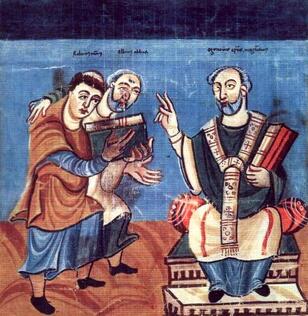 Raban Maur (left), supported by Alcuin (middle), dedicates his work to Archbishop Otgar of Mainz (Right) Carolingian Manuscript c. 831
Raban Maur (left), supported by Alcuin (middle), dedicates his work to Archbishop Otgar of Mainz (Right) Carolingian Manuscript c. 831
2020Events
18 January - The Search for Alcuin's York - Dr Mary Garrison
Mary Garrison is a good friend of FFH and has spoken to us before on Alcuin, but we asked her to return because she is currently writing a book on him and her research has extended her knowledge and understanding.
Alcuin was one of the most learned and influential men of the early Middle Ages and was remembered by contemporaries as 'the most learned man anywhere to be found'.
Mary painted a vivid portrait of this scholar whose legacy survives today in the liturgy and the style of manuscript lettering. His love of books created one of most important libraries of the middle age and he was one of the finest teachers of the eighth century. 'The light of understanding is natural to human minds', he said, 'just as flint has a spark within it by nature, but the understanding remains dormant like the spark in the flint without the frequent attention of the teacher.'
Alcuin (c 730/40-804) was a great teacher from York's Minster school and became one of the most influential men of his century, renowned throughout Europe for his learning. He was a principal advisor to the Frankish Emperor Charlemagne, and was later Abbot of Tours. If Northumbria in supposed decline could produce so great a figure, what else might be lost from view? That Alcuin's achievements were unique may be true, but that he was alone in the quality of his education, a single solitary flame in the darkness of a dying kingdom, seems on the face of it unlikely.
Alcuin himself provides us with a lyrical description of his own city of York. It was a city with 'high walls and towers' - (download Mary's translation HERE) an indication, backed up by recent excavations, that the walls of the Roman fortress still stood. York was adorned with the ancient Minster of St Peter with its fine new altar decked with 'gold, silver and jewels' placed on the site of the baptism in 627 of the first Christian king of Northumbria, Edwin (see BA April). There was also a great new church of the Alma Sophia, or Holy Wisdom, perhaps a centrally-planned building like Charlemagne's own palace building at Aachen, although all trace of it has vanished. It too was lavishly furnished, and the works had been supervised by Alcuin himself and his colleague Eanbald.York in Alcuin's time was clearly flourishing.
The library of York's Minster school, compiled mainly by Alcuin's mentor Archbishop Ælberht (767-78), was one of the most extensive in Europe, containing books by authors ranging from Jerome and Athanasius to Gregory the Great, and from John Chrysostom to Aristotle, Virgil, Cicero and Boethius. The curriculum at York was wide. Alongside Latin grammar, rhetoric and time-reckoning, students also learned logic, astronomy, geometry, arithmetic, maybe even history and natural history.
This curriculum was transferred by Alcuin to Charlemagne's court at Aachen and later to Tours, reintroducing books and subjects which had been neglected for centuries. As late as the 830s there were still requests to York from continental Europe for the loan of books. Read a short article about Alcuin's York by Dominic Tweddle HERE
You can hear Mary Garrison in discussion with Melvin Bragg on 30th March edition of 'In Our Time' on Radio 4 HERE You can also hear Mary talking about Alcuin on this BBC programme HERE
Read more about Mary and her research HERE
18 January - The Search for Alcuin's York - Dr Mary Garrison
Mary Garrison is a good friend of FFH and has spoken to us before on Alcuin, but we asked her to return because she is currently writing a book on him and her research has extended her knowledge and understanding.
Alcuin was one of the most learned and influential men of the early Middle Ages and was remembered by contemporaries as 'the most learned man anywhere to be found'.
Mary painted a vivid portrait of this scholar whose legacy survives today in the liturgy and the style of manuscript lettering. His love of books created one of most important libraries of the middle age and he was one of the finest teachers of the eighth century. 'The light of understanding is natural to human minds', he said, 'just as flint has a spark within it by nature, but the understanding remains dormant like the spark in the flint without the frequent attention of the teacher.'
Alcuin (c 730/40-804) was a great teacher from York's Minster school and became one of the most influential men of his century, renowned throughout Europe for his learning. He was a principal advisor to the Frankish Emperor Charlemagne, and was later Abbot of Tours. If Northumbria in supposed decline could produce so great a figure, what else might be lost from view? That Alcuin's achievements were unique may be true, but that he was alone in the quality of his education, a single solitary flame in the darkness of a dying kingdom, seems on the face of it unlikely.
Alcuin himself provides us with a lyrical description of his own city of York. It was a city with 'high walls and towers' - (download Mary's translation HERE) an indication, backed up by recent excavations, that the walls of the Roman fortress still stood. York was adorned with the ancient Minster of St Peter with its fine new altar decked with 'gold, silver and jewels' placed on the site of the baptism in 627 of the first Christian king of Northumbria, Edwin (see BA April). There was also a great new church of the Alma Sophia, or Holy Wisdom, perhaps a centrally-planned building like Charlemagne's own palace building at Aachen, although all trace of it has vanished. It too was lavishly furnished, and the works had been supervised by Alcuin himself and his colleague Eanbald.York in Alcuin's time was clearly flourishing.
The library of York's Minster school, compiled mainly by Alcuin's mentor Archbishop Ælberht (767-78), was one of the most extensive in Europe, containing books by authors ranging from Jerome and Athanasius to Gregory the Great, and from John Chrysostom to Aristotle, Virgil, Cicero and Boethius. The curriculum at York was wide. Alongside Latin grammar, rhetoric and time-reckoning, students also learned logic, astronomy, geometry, arithmetic, maybe even history and natural history.
This curriculum was transferred by Alcuin to Charlemagne's court at Aachen and later to Tours, reintroducing books and subjects which had been neglected for centuries. As late as the 830s there were still requests to York from continental Europe for the loan of books. Read a short article about Alcuin's York by Dominic Tweddle HERE
You can hear Mary Garrison in discussion with Melvin Bragg on 30th March edition of 'In Our Time' on Radio 4 HERE You can also hear Mary talking about Alcuin on this BBC programme HERE
Read more about Mary and her research HERE
9 November - Guy Fawkes, the Gunpowder Plot and York – an illustrated talk by Tony Morgan
On November 5th each year we celebrate the failure of the Gunpowder Plot with bonfires and fireworks but how much do we really know about the history behind this fascinating event? Local author Tony Morgan gave us a fascinating talk on Guy Fawkes's childhood, the events of the Gunpowder Plot and many local connections.
(read Linda Haywood's fascinating article about Fawkes connections to Bishopthorpe - HERE)
On November 5th each year we celebrate the failure of the Gunpowder Plot with bonfires and fireworks but how much do we really know about the history behind this fascinating event? Local author Tony Morgan gave us a fascinating talk on Guy Fawkes's childhood, the events of the Gunpowder Plot and many local connections.
(read Linda Haywood's fascinating article about Fawkes connections to Bishopthorpe - HERE)
Churches and Chapels in Heslington
The small community Heslington provides an interesting study of English religious belief and practice. Until 1869, the village was divided between the parishes of St Lawrence, near Walmgate Bar, and St Paul’s in the village. But in the mid-19th century there were also three non-conformist churches; a Wesleyan Methodist Association, a Wesleyan Methodist Chapel and an Independent Chapel. In the 20th century, a chapel was established for Catholics and St Paul’s was imaginatively re-modelled to provide a modern ecumenical environment, suitable for most denominations.
In October 2019, we were treated to a well researched study of this fascinating subject by one of our members; the former scientist and retired Anglican priest, Dr Peter Mott, who still takes occasional services at Heslington parish church.
Heslington is an Anglo-Saxon name, interpreted as “Settlement by the hazel trees”, which means it dates from long before “Great Heathen Army” of Vikings occupied York in 867. The village is mentioned in the Domesday Book, which lists two Norse Lords of the Manor; Folcar, and Orm son of Gamal. Both were major Northumbrian landowners who lived elsewhere.
After the “harrying of the North” by William the Conqueror, most Norse lords were dispossessed and their lands given to Norman supporters of the King. Count Alan of Brittany (William’s nephew, and lieutenant at the Battle of Hastings) became the 4th largest landowner in England, including 5 carucates in Heslington (a carucate was the area that could be cultivated in a year by one team of 8 oxen - about 120 acres).
King William appointed Thomas of Bayeux as Archbishop of York in 1070, after the death of Archbishop Aeldred. He rebuilt and re-organised York Minster, but objected when Count Alan established a Benedictine monastery (St. Mary’s) in the grounds of St. Olave’s Church, of which both men claimed to be patron. The King decided in favour of Count Alan, but to compensate, he gave Archbishop Thomas properties in Fishergate, Clifton and 4 carucates in Heslington.
In addition to building a new Minster, Archbishop Thomas also re-organised the canons (cathedral clergy), giving each their own land (prebendary) to support them. His successors continued this practice, and in about 1150, the Archbishop awarded his Heslington manor to the new Prebendary of Ampleforth and it is likely that the Prebend (Canon) built the first Heslington Church. Two surviving pictures of the original church show it was built in the Norman style with rounded arches, rather than pointed arches of the Gothic, which began to be used at the turn of the 13th Century. In 1388, 2 bells were installed, cast by John Porter of York. These are all that remain of the Medieval Church - except possibly the snowdrops in the former churchyard.
Methodism is said to have been introduced into Heslington in 1812. A chapel was opened by the Wesleyan Association in the 1830s and was still in use in 1851, but no more is known of it. In the 1840s two more chapels were built; by the Wesleyan Methodists in 1844 on the west side of Main Street, and by the Independents in 1847 on the east side. The Independent chapel was acquired by the Primitive Methodists and registered by them in 1887. The Wesleyan chapel closed in 1949 and became the Village Meeting Room in 1954.
In 1858 a new larger Parish Church was built in Heslington in memory of the Lord of the Manor, Yarburgh Yarburgh and paid for by his sister, Mrs. Alicia Lloyd, and her son George who had inherited the Heslington estate, and now changed his name to a single Yarburgh. (He inherited the title of Lord Deramore from his older brother in 1890.) The new Church was built in Victorian Gothic (specifically 14th Century Decorated) style.
A beautiful mosaic was installed behind the altar in 1880, made by the Italian Antonio Salviati (who also made the mosaic reredos in Fulford Church). It shows the four Gospel-writers: Matthew, Mark, Luke and John, with symbolic floral mosaics inbetween. The central design is a Maltese Cross, in recognition that Heslington’s patron, Saint Paul, shipwrecked on the Island of Malta. The encaustic tiled floor was also installed at this time, and the stained glass windows showing the Nativity and Resurrection of Christ are in memory of Mary Elizabeth Bateson de Yarburgh, who died in 1884.
In the 1960s, the old vicarage was sold to the Roman Catholics for a Carmelite community and Catholic chaplaincy centre; there is now a chapel where services are held regularly for the friars and the university Catholic community.
With the arrival of the University, the parish church needed enlarging, and in 1973, St Paul’s church was radically and very successfully re-configured and enlarged to a design by Ronald Sims.
You can read an illustrated transcript of Peter Mott’s talk HERE
In October 2019, we were treated to a well researched study of this fascinating subject by one of our members; the former scientist and retired Anglican priest, Dr Peter Mott, who still takes occasional services at Heslington parish church.
Heslington is an Anglo-Saxon name, interpreted as “Settlement by the hazel trees”, which means it dates from long before “Great Heathen Army” of Vikings occupied York in 867. The village is mentioned in the Domesday Book, which lists two Norse Lords of the Manor; Folcar, and Orm son of Gamal. Both were major Northumbrian landowners who lived elsewhere.
After the “harrying of the North” by William the Conqueror, most Norse lords were dispossessed and their lands given to Norman supporters of the King. Count Alan of Brittany (William’s nephew, and lieutenant at the Battle of Hastings) became the 4th largest landowner in England, including 5 carucates in Heslington (a carucate was the area that could be cultivated in a year by one team of 8 oxen - about 120 acres).
King William appointed Thomas of Bayeux as Archbishop of York in 1070, after the death of Archbishop Aeldred. He rebuilt and re-organised York Minster, but objected when Count Alan established a Benedictine monastery (St. Mary’s) in the grounds of St. Olave’s Church, of which both men claimed to be patron. The King decided in favour of Count Alan, but to compensate, he gave Archbishop Thomas properties in Fishergate, Clifton and 4 carucates in Heslington.
In addition to building a new Minster, Archbishop Thomas also re-organised the canons (cathedral clergy), giving each their own land (prebendary) to support them. His successors continued this practice, and in about 1150, the Archbishop awarded his Heslington manor to the new Prebendary of Ampleforth and it is likely that the Prebend (Canon) built the first Heslington Church. Two surviving pictures of the original church show it was built in the Norman style with rounded arches, rather than pointed arches of the Gothic, which began to be used at the turn of the 13th Century. In 1388, 2 bells were installed, cast by John Porter of York. These are all that remain of the Medieval Church - except possibly the snowdrops in the former churchyard.
Methodism is said to have been introduced into Heslington in 1812. A chapel was opened by the Wesleyan Association in the 1830s and was still in use in 1851, but no more is known of it. In the 1840s two more chapels were built; by the Wesleyan Methodists in 1844 on the west side of Main Street, and by the Independents in 1847 on the east side. The Independent chapel was acquired by the Primitive Methodists and registered by them in 1887. The Wesleyan chapel closed in 1949 and became the Village Meeting Room in 1954.
In 1858 a new larger Parish Church was built in Heslington in memory of the Lord of the Manor, Yarburgh Yarburgh and paid for by his sister, Mrs. Alicia Lloyd, and her son George who had inherited the Heslington estate, and now changed his name to a single Yarburgh. (He inherited the title of Lord Deramore from his older brother in 1890.) The new Church was built in Victorian Gothic (specifically 14th Century Decorated) style.
A beautiful mosaic was installed behind the altar in 1880, made by the Italian Antonio Salviati (who also made the mosaic reredos in Fulford Church). It shows the four Gospel-writers: Matthew, Mark, Luke and John, with symbolic floral mosaics inbetween. The central design is a Maltese Cross, in recognition that Heslington’s patron, Saint Paul, shipwrecked on the Island of Malta. The encaustic tiled floor was also installed at this time, and the stained glass windows showing the Nativity and Resurrection of Christ are in memory of Mary Elizabeth Bateson de Yarburgh, who died in 1884.
In the 1960s, the old vicarage was sold to the Roman Catholics for a Carmelite community and Catholic chaplaincy centre; there is now a chapel where services are held regularly for the friars and the university Catholic community.
With the arrival of the University, the parish church needed enlarging, and in 1973, St Paul’s church was radically and very successfully re-configured and enlarged to a design by Ronald Sims.
You can read an illustrated transcript of Peter Mott’s talk HERE
Yorkshire Museum Visit to see the Heslington Hoard
A lucky group of FFH members visited the Yorkshire Museum on 2nd October to see some of the Heslington Hoard of 2,871 Roman coins, which were found during construction the University library.
An additional and unexpected treat was a detailed talk by Andrew Woods, Senior Curator and numismatics specialist, who explained the composition of coins in the hoard, what they tell us about life in Roman York and possible reasons for them being placed in an urn on Heslington Hill.
FFH has a special connection with these coins, as our members Peter Mott, Charles Patmore and Robert Visick were part of the group of volunteers who cleaned and recorded the coins.
We have a page on this website where you can read more about them - just click HERE
A lucky group of FFH members visited the Yorkshire Museum on 2nd October to see some of the Heslington Hoard of 2,871 Roman coins, which were found during construction the University library.
An additional and unexpected treat was a detailed talk by Andrew Woods, Senior Curator and numismatics specialist, who explained the composition of coins in the hoard, what they tell us about life in Roman York and possible reasons for them being placed in an urn on Heslington Hill.
FFH has a special connection with these coins, as our members Peter Mott, Charles Patmore and Robert Visick were part of the group of volunteers who cleaned and recorded the coins.
We have a page on this website where you can read more about them - just click HERE
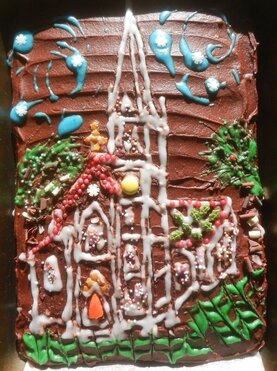
St Oswald's Church - A Victorian Gem!
We spent a splendid September morning examining the architectural and artistic detail of this grand Victorian church. Conservation Architect Ian Hayton, explained the French influence behind J C Prichett's design, and Louise Wheatley described the stained glass, font and funerary monuments.
On first entering the church, it gives the impression of being a typical urban barn-like church, but it came to life with with Ian and Louise's expertise. Behind the Altar is a stunning Venetian glass mosaic reredos by Salviati, with an adjacent stained glass window by Clayton and Bell depicting St Oswald.
We looked closely at the two fine carved oak memorials to local men killed in the Great War, and were designed by Walter Brierley, and large lozenge shaped hatchments recording major local land owners Robert Oats and William Richardson, were brought to the church from the old church (see HERE).
High above the parishioners, beautifully carved and painted musician-angels and priests look down from the top of the columns.
Outside, carved stone heads adorn just about every possible location, and are thought to be representations of local people, possible benefactors who paid for the new church. We looked at these as we made our way to the church hall for a slide show of high quality photographs of the stained glass windows and an exhibition of photographs of the musician-angels.
A really good event was topped by coffee and a splendid cake made by Louise Wheatley, pictured here.
You can read more about the church and see pictures of some of its treasures HERE
The church today is too large for its congregation and funds are being sought for essential structural and functional repairs, and to re-configure the interior to provide flexibility for a range of uses, including a large space for weekly worship, concerts, exhibitions, etc; small sanctuary for private prayer; meeting rooms; community café open most days; arts venue; training facilities. Read more about these plans HERE
We spent a splendid September morning examining the architectural and artistic detail of this grand Victorian church. Conservation Architect Ian Hayton, explained the French influence behind J C Prichett's design, and Louise Wheatley described the stained glass, font and funerary monuments.
On first entering the church, it gives the impression of being a typical urban barn-like church, but it came to life with with Ian and Louise's expertise. Behind the Altar is a stunning Venetian glass mosaic reredos by Salviati, with an adjacent stained glass window by Clayton and Bell depicting St Oswald.
We looked closely at the two fine carved oak memorials to local men killed in the Great War, and were designed by Walter Brierley, and large lozenge shaped hatchments recording major local land owners Robert Oats and William Richardson, were brought to the church from the old church (see HERE).
High above the parishioners, beautifully carved and painted musician-angels and priests look down from the top of the columns.
Outside, carved stone heads adorn just about every possible location, and are thought to be representations of local people, possible benefactors who paid for the new church. We looked at these as we made our way to the church hall for a slide show of high quality photographs of the stained glass windows and an exhibition of photographs of the musician-angels.
A really good event was topped by coffee and a splendid cake made by Louise Wheatley, pictured here.
You can read more about the church and see pictures of some of its treasures HERE
The church today is too large for its congregation and funds are being sought for essential structural and functional repairs, and to re-configure the interior to provide flexibility for a range of uses, including a large space for weekly worship, concerts, exhibitions, etc; small sanctuary for private prayer; meeting rooms; community café open most days; arts venue; training facilities. Read more about these plans HERE
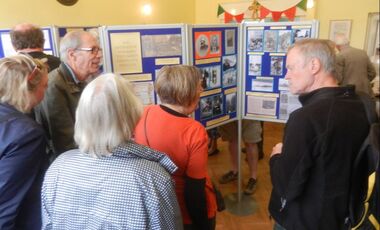
Nurserymen - The First Greens of Fishergate! Botanists, Nurserymen and Gardeners.
Our Festival of Ideas Event for 2019
On 15 June, Judy Nicholson presented her in-depth research to a packed audience of over 90 members and visitors, our biggest-ever! (Thank goodness we were able to use the church hall's PA system for the first time)
Using many illustrations of garden design, plant catalogues, maps, drawings and photographs, Judy wove a complex story of how nurseries began in the gardens of the Dominican Friary in Toft Green, where Aldermen George and John Telford established a nursery garden around 1665, and flourished until 1816, when the Backhouse family took over the site. Backhouses stayed until George Hudson bought them out so he could build his new station (now the council offices) and Backhouses moved to the Riggs nursery in Fishergate. Riggs sold some of their land for the York Cemetery.
Judy told the story very thoroughly and her display of related material was examined in detail by our audience. This may be the first time that this story has been told. Thanks also to Louise Wheatley for her flowery cake!
(in case you are wondering, we called Judy's talk 'The First Greens of Fishergate' because Fishergate Ward is represented by Andy D'Agorne and Dave Taylor, the first Green Party councillors to be elected to the City of York Council)
Our Festival of Ideas Event for 2019
On 15 June, Judy Nicholson presented her in-depth research to a packed audience of over 90 members and visitors, our biggest-ever! (Thank goodness we were able to use the church hall's PA system for the first time)
Using many illustrations of garden design, plant catalogues, maps, drawings and photographs, Judy wove a complex story of how nurseries began in the gardens of the Dominican Friary in Toft Green, where Aldermen George and John Telford established a nursery garden around 1665, and flourished until 1816, when the Backhouse family took over the site. Backhouses stayed until George Hudson bought them out so he could build his new station (now the council offices) and Backhouses moved to the Riggs nursery in Fishergate. Riggs sold some of their land for the York Cemetery.
Judy told the story very thoroughly and her display of related material was examined in detail by our audience. This may be the first time that this story has been told. Thanks also to Louise Wheatley for her flowery cake!
(in case you are wondering, we called Judy's talk 'The First Greens of Fishergate' because Fishergate Ward is represented by Andy D'Agorne and Dave Taylor, the first Green Party councillors to be elected to the City of York Council)
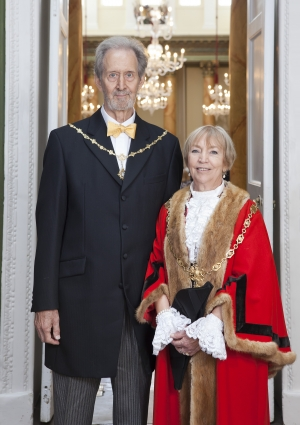
My year as York’s Sheriff -
Verna Campbell on the Role and Regalia'
13 April 2019
One of our first members, Verna Campbell, had the honour of being York’s Sheriff for 2018-19, so we couldn’t resist the opportunity to ask her to talk about having a year of her life taken over by civic duties.
Verna is well known to many as the former head of Naburn Primary School and is an active member of York Civic Trust, among many other roles. Her husband, Colin (Emeritus Professor of Sociology at the University of York), added an extra dimension to the morning, telling us candidly of his experience in the role of Sheriff’s consort.
Verna said she and Colin thought long and hard before accepting the invitation to take on the role, not just because of the huge amount of time it would take, but also their obligation to attend so many ceremonial, civic, church, military and guild functions as well as a wide range of community events – including this one!
She spoke movingly about the emotional effect of the combined Mayor and Sheriff ‘making’ ceremony, when the historic importance of the role to the history of York became abundantly clear. The previous sheriff and consort were dis-robed, and the regalia carefully placed on Verna and Colin, the robes feeling heavy in weight and history. (a summary of the history of the role and ceremonial accoutrements is at the end of this report)
Verna and Colin gave accounts of some of the events they undertook, including formal processions; eg. Legal Sunday, Remembrance Day, and the award of Freedom of the City to 2 Signal Regiment. Formal dinners, often required speeches too, and then there were Livery (Guild) Societies, Shrove Tuesday, Venison Feast, Church services…etc. Most of these are obligations where attendance of the sheriff is expected, even if she didn’t want really to be there.
We were delighted that Verna and Colin (and the Mayor) were among the readers at our event to commemorate the centenary of the Armistice at Fishergate School, bringing gravitas and poignancy as they read accounts of the unveiling of the school’s memorial in 1924.
Less formal and often very enjoyable events included unveiling the plaque marking the offices of York’s Suffragettes in Coney Street, the International Shared Meal, Diwali, the Under 11 Chess Challenge, a Tea Dance at Grimston Court, and a visit to Barley Studios to see the new stained glass for Westminster Abbey, designed by David Hockney to celebrate the Queen’s long reign.
Because of the need to ensure the security of the regalia and keep it neat and tidy, the official car chauffeurs Verna and Colin to and from events, and on this occasion, Janet Easton was their ‘Civic Support Officer’. Janet also spoke movingly about her role as custodian of both the role and regalia.
But the role is not always as glamorous as it may appear; particularly when the lift in the wonderfully refurbished Mansion House breaks down (as it did a number of times) leaving them stranded and phoning desperately for help! As well as having to listen to excruciating speeches, Verna said that they sometimes wondered why they had been invited to events at all, as the organisers and participants paid them scant attention.
But overall, the year had been an amazing experience, representing the city and placing her at the heart of York’s civic heritage and pride. Verna and Colin were also pleased to be able to choose Sheriff’s Charities; My Sight York, The Island and York Music Hub, raising money through the year for causes close to their heart. At the end of their term, they had raised over £40,000! Thanks Verna and Colin, we were delighted to hear about your very special year.
The role and he regalia…
The role of Sheriff dates back to the late Anglo-Saxon period of king Edgar (957 – 975) when the country was divided into Shires, with a Shire Reeve appointed to oversee justice and collect the king’s revenue across the county of Yorkshire, which was first referred to in official documents around this time.
The Norman’s continued the role and its importance is reflected in the Magna Carta, where 27 out of 63 clauses refer to the Sheriff’s powers.
The first Lord Mayor of York was Thomas Smith. He was granted this title in 1389 by Richard II (1367-1400) who also presented him with a sword when visiting the City, instructing that it could be carried point upright in procession, or pointing down when the king was present.
Richard II visited York on a number of occasions and granted the city greater freedoms and privileges. Most importantly, in 1396 he gave the city its most significant royal charter, which promoted it to the status of a county in its own right: ‘the county of the city of York’, ending the sheriff of Yorkshire’s powers over the city. Two annually elected sheriffs of York were controlled by the mayor.
York's Lord Mayor is second only to the Lord Mayor of London in precedence and the Sheriff holds the oldest office of Sheriff in England and Wales.
The roles of Mayor and Sheriff continued through the centuries, but the 1888 County Boroughs Act introduced a more democratic system of local government and the Mayor and Sheriff became largely ceremonial. Some towns abolished the role of Sheriff after the Local Government Act of 1972, but York continued the tradition as a symbol of the city’s historic status.
The Victoria County History lists the city's insignia as; two swords of state, a cap of maintenance, a great mace, four sergeants' maces, gold chains for the lord mayor and lady mayoress, a jewel worn with the lord mayor's chain, a lady mayoress's staff, a sheriff's chain and badge, sheriff's and under-sheriff's staffs, sheriff's lady's chain, three livery collars and badges, and a porter's staff.
The first sword was made in the early 15th century, and belonged to the Emperor Sigismund of Bohemia, the Holy Roman Emperor (1368-1437); at his death it passed to the Dean and Canons of Windsor; the Dean later gave it to one of his canons, Henry Hanslap, a native of York. Hanslap presented it to the city in 1439. The sword was redecorated in 1586, as recorded on the blade, and frequently repaired.
The second sword was given to the city in 1545 by Sir Martin Bowes, a native of York and Lord Mayor of London, in gratitude for the city's agreement to preserve St. Cuthbert's Church. It was extensively repaired in the early 17th century. Two other swords were in existence until at least 1796 but have been lost: one was given by Richard II in 1389 to be carried before the mayor, the other was used by him when he 'went abroad or stirred from home'.
The first Cap of Maintenance, worn by the sword-bearer on state occasions, is said to have been given by Richard II in 1393. New ones were bought in 1445 and 1580, and more recently, by George V in 1915, but the city still possesses the cap of 1580. The Cap worn today was given to the city by the queen in 2012.
A mace or maces were apparently borne before the mayor and sheriffs before that privilege was granted in the charter of 1396. There were at first six serjeants-at-mace, but later only four; a macebearer carries the great mace.
A great mace was certainly in existence during the 15th century, but a new one was made in 1580; another and larger one was made in 1647 and is the great mace still in use. The smaller mace disappeared during the 18th century. The four sergeants' maces, called 'city seals', are of comparatively modern date.
The lord mayor's gold chain of office was bequeathed to the city by a former lord mayor, Sir Robert Watter, in 1612. The lady mayoress's gold chain was given by Marmaduke Rawden in 1670. The jewel to be worn with the lord mayor's chain was given by Sir J. S. Rymer in 1914. The lady mayoress's 'staff of honour' was given by Alderman Richard Towne in 1726; it was reputed to have belonged to an Indian potentate and replaced an old staff.
The sheriff's gold chain and badge were given by Alderman Thomas Walker in 1893. The sheriff's and under-sheriff's staffs were given by Reginald Teasdale, under-sheriff, in 1921, and the sheriff's lady's chain by J. H. Turner in 1919. The three silver livery collars are worn by the sword-bearer, mace-bearer, and staff-bearer. They were formerly worn by the city waits and were in regular use by 1565; in 1566 a fourth collar was made when the number of waits was increased. They were repaired and partially remade in 1585, and two of the existing collars may be of that date. By the early 16th century the waits also wore the city arms on their sleeves, as did other civic officers later. The porter's staff was in use by at least 1679, a date with which it is inscribed.
Christopher Rainger
Chair of FFH
June 2019
Verna Campbell on the Role and Regalia'
13 April 2019
One of our first members, Verna Campbell, had the honour of being York’s Sheriff for 2018-19, so we couldn’t resist the opportunity to ask her to talk about having a year of her life taken over by civic duties.
Verna is well known to many as the former head of Naburn Primary School and is an active member of York Civic Trust, among many other roles. Her husband, Colin (Emeritus Professor of Sociology at the University of York), added an extra dimension to the morning, telling us candidly of his experience in the role of Sheriff’s consort.
Verna said she and Colin thought long and hard before accepting the invitation to take on the role, not just because of the huge amount of time it would take, but also their obligation to attend so many ceremonial, civic, church, military and guild functions as well as a wide range of community events – including this one!
She spoke movingly about the emotional effect of the combined Mayor and Sheriff ‘making’ ceremony, when the historic importance of the role to the history of York became abundantly clear. The previous sheriff and consort were dis-robed, and the regalia carefully placed on Verna and Colin, the robes feeling heavy in weight and history. (a summary of the history of the role and ceremonial accoutrements is at the end of this report)
Verna and Colin gave accounts of some of the events they undertook, including formal processions; eg. Legal Sunday, Remembrance Day, and the award of Freedom of the City to 2 Signal Regiment. Formal dinners, often required speeches too, and then there were Livery (Guild) Societies, Shrove Tuesday, Venison Feast, Church services…etc. Most of these are obligations where attendance of the sheriff is expected, even if she didn’t want really to be there.
We were delighted that Verna and Colin (and the Mayor) were among the readers at our event to commemorate the centenary of the Armistice at Fishergate School, bringing gravitas and poignancy as they read accounts of the unveiling of the school’s memorial in 1924.
Less formal and often very enjoyable events included unveiling the plaque marking the offices of York’s Suffragettes in Coney Street, the International Shared Meal, Diwali, the Under 11 Chess Challenge, a Tea Dance at Grimston Court, and a visit to Barley Studios to see the new stained glass for Westminster Abbey, designed by David Hockney to celebrate the Queen’s long reign.
Because of the need to ensure the security of the regalia and keep it neat and tidy, the official car chauffeurs Verna and Colin to and from events, and on this occasion, Janet Easton was their ‘Civic Support Officer’. Janet also spoke movingly about her role as custodian of both the role and regalia.
But the role is not always as glamorous as it may appear; particularly when the lift in the wonderfully refurbished Mansion House breaks down (as it did a number of times) leaving them stranded and phoning desperately for help! As well as having to listen to excruciating speeches, Verna said that they sometimes wondered why they had been invited to events at all, as the organisers and participants paid them scant attention.
But overall, the year had been an amazing experience, representing the city and placing her at the heart of York’s civic heritage and pride. Verna and Colin were also pleased to be able to choose Sheriff’s Charities; My Sight York, The Island and York Music Hub, raising money through the year for causes close to their heart. At the end of their term, they had raised over £40,000! Thanks Verna and Colin, we were delighted to hear about your very special year.
The role and he regalia…
The role of Sheriff dates back to the late Anglo-Saxon period of king Edgar (957 – 975) when the country was divided into Shires, with a Shire Reeve appointed to oversee justice and collect the king’s revenue across the county of Yorkshire, which was first referred to in official documents around this time.
The Norman’s continued the role and its importance is reflected in the Magna Carta, where 27 out of 63 clauses refer to the Sheriff’s powers.
The first Lord Mayor of York was Thomas Smith. He was granted this title in 1389 by Richard II (1367-1400) who also presented him with a sword when visiting the City, instructing that it could be carried point upright in procession, or pointing down when the king was present.
Richard II visited York on a number of occasions and granted the city greater freedoms and privileges. Most importantly, in 1396 he gave the city its most significant royal charter, which promoted it to the status of a county in its own right: ‘the county of the city of York’, ending the sheriff of Yorkshire’s powers over the city. Two annually elected sheriffs of York were controlled by the mayor.
York's Lord Mayor is second only to the Lord Mayor of London in precedence and the Sheriff holds the oldest office of Sheriff in England and Wales.
The roles of Mayor and Sheriff continued through the centuries, but the 1888 County Boroughs Act introduced a more democratic system of local government and the Mayor and Sheriff became largely ceremonial. Some towns abolished the role of Sheriff after the Local Government Act of 1972, but York continued the tradition as a symbol of the city’s historic status.
The Victoria County History lists the city's insignia as; two swords of state, a cap of maintenance, a great mace, four sergeants' maces, gold chains for the lord mayor and lady mayoress, a jewel worn with the lord mayor's chain, a lady mayoress's staff, a sheriff's chain and badge, sheriff's and under-sheriff's staffs, sheriff's lady's chain, three livery collars and badges, and a porter's staff.
The first sword was made in the early 15th century, and belonged to the Emperor Sigismund of Bohemia, the Holy Roman Emperor (1368-1437); at his death it passed to the Dean and Canons of Windsor; the Dean later gave it to one of his canons, Henry Hanslap, a native of York. Hanslap presented it to the city in 1439. The sword was redecorated in 1586, as recorded on the blade, and frequently repaired.
The second sword was given to the city in 1545 by Sir Martin Bowes, a native of York and Lord Mayor of London, in gratitude for the city's agreement to preserve St. Cuthbert's Church. It was extensively repaired in the early 17th century. Two other swords were in existence until at least 1796 but have been lost: one was given by Richard II in 1389 to be carried before the mayor, the other was used by him when he 'went abroad or stirred from home'.
The first Cap of Maintenance, worn by the sword-bearer on state occasions, is said to have been given by Richard II in 1393. New ones were bought in 1445 and 1580, and more recently, by George V in 1915, but the city still possesses the cap of 1580. The Cap worn today was given to the city by the queen in 2012.
A mace or maces were apparently borne before the mayor and sheriffs before that privilege was granted in the charter of 1396. There were at first six serjeants-at-mace, but later only four; a macebearer carries the great mace.
A great mace was certainly in existence during the 15th century, but a new one was made in 1580; another and larger one was made in 1647 and is the great mace still in use. The smaller mace disappeared during the 18th century. The four sergeants' maces, called 'city seals', are of comparatively modern date.
The lord mayor's gold chain of office was bequeathed to the city by a former lord mayor, Sir Robert Watter, in 1612. The lady mayoress's gold chain was given by Marmaduke Rawden in 1670. The jewel to be worn with the lord mayor's chain was given by Sir J. S. Rymer in 1914. The lady mayoress's 'staff of honour' was given by Alderman Richard Towne in 1726; it was reputed to have belonged to an Indian potentate and replaced an old staff.
The sheriff's gold chain and badge were given by Alderman Thomas Walker in 1893. The sheriff's and under-sheriff's staffs were given by Reginald Teasdale, under-sheriff, in 1921, and the sheriff's lady's chain by J. H. Turner in 1919. The three silver livery collars are worn by the sword-bearer, mace-bearer, and staff-bearer. They were formerly worn by the city waits and were in regular use by 1565; in 1566 a fourth collar was made when the number of waits was increased. They were repaired and partially remade in 1585, and two of the existing collars may be of that date. By the early 16th century the waits also wore the city arms on their sleeves, as did other civic officers later. The porter's staff was in use by at least 1679, a date with which it is inscribed.
Christopher Rainger
Chair of FFH
June 2019
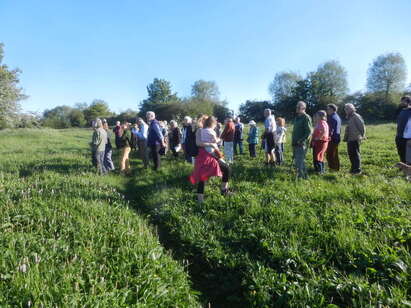
The Ecology and History of Fulford Ings – a guided walk led by Andrew Vevers
21 May 2019
At least 40 members and friends enjoyed a beautiful evening walking through Fulford Ings, from Old St Oswald's to Water Fulford Hall, with interesting ecological, environmental and historical information provided by local Environmental Consultant, Andrew Vevers. As so often happens, our intelligent members asked questions and added their knowledge along the way too.
Andrew explained some of the issues involved in managing the protected areas of SSSI and the importance of the Ings to wildlife and plant ecology. When we arrived at the modern course of Germany Beck, Lynn Harper gave an impromptu account of the battle of Fulford, which took place nearby on 20th September 1066. (thanks Lynn!)
Nearby, Chris Rainger pointed out the sumps of timber posts on the bed of the river - all that remains of the wharf which once operated there and then Andrew found a Tansy Beetle, much to the delight of us all. Picture below.
We walked as far as Water Fulford Hall and saw the line of stones along the bed of the river, the remains of a much larger wharf which brought coal and other bulky or heave items to the village and surrounding area and probably exported grain and produce from local farms. A concrete landing still stands in the middle of the wharf, with two bollards marked ONB (Ouse Navigation Board), pictured below.
We walked back along the path on the eastern side of the Ings, which runs next to the boundary of village properties, some very large. Many people commented on what a lovely time they had enjoyed and how nice it was to see families with children on one of our events.
To read Chris Rainger's paper on re-routing Germany Beck and the wharves served by Landing Lane, click HERE
Left photo shows the Water Fulford Hall Landing with the remains of the long wharf wall in the river bed behind. ONB stands for Ouse Navigation Board. Right photo shows a Tansy Beetle on a Tansy plant.
21 May 2019
At least 40 members and friends enjoyed a beautiful evening walking through Fulford Ings, from Old St Oswald's to Water Fulford Hall, with interesting ecological, environmental and historical information provided by local Environmental Consultant, Andrew Vevers. As so often happens, our intelligent members asked questions and added their knowledge along the way too.
Andrew explained some of the issues involved in managing the protected areas of SSSI and the importance of the Ings to wildlife and plant ecology. When we arrived at the modern course of Germany Beck, Lynn Harper gave an impromptu account of the battle of Fulford, which took place nearby on 20th September 1066. (thanks Lynn!)
Nearby, Chris Rainger pointed out the sumps of timber posts on the bed of the river - all that remains of the wharf which once operated there and then Andrew found a Tansy Beetle, much to the delight of us all. Picture below.
We walked as far as Water Fulford Hall and saw the line of stones along the bed of the river, the remains of a much larger wharf which brought coal and other bulky or heave items to the village and surrounding area and probably exported grain and produce from local farms. A concrete landing still stands in the middle of the wharf, with two bollards marked ONB (Ouse Navigation Board), pictured below.
We walked back along the path on the eastern side of the Ings, which runs next to the boundary of village properties, some very large. Many people commented on what a lovely time they had enjoyed and how nice it was to see families with children on one of our events.
To read Chris Rainger's paper on re-routing Germany Beck and the wharves served by Landing Lane, click HERE
Left photo shows the Water Fulford Hall Landing with the remains of the long wharf wall in the river bed behind. ONB stands for Ouse Navigation Board. Right photo shows a Tansy Beetle on a Tansy plant.
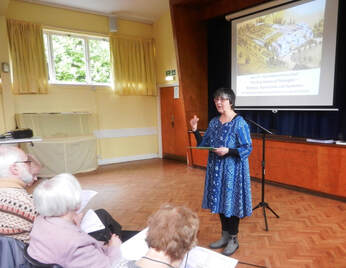
Annual General Meeting + 'The Minster in Close-up' - Catherine Sotheran's amazing photographs of angels, sinners, saints and beasts high up on the Minster. 16 March 2019
Over 40 people came to our AGM, which was followed by a slide show of Catherine Sotheran's incredible photographs of the strange and beautiful carved stone grotesques high up on the Minster and Chapter House, after which, we sat down for a very sociable lunch (thanks to everyone who brought a delicious contribution and our small army of members who effortlessly did the kitchen work)
Our Chairman, Chris Rainger, presented his report on the year, and what a year it has been! Since our inaugural meeting in October 2011, our Society has attracted attention for the high standard of its events and the quality of speakers. But 2018 will be remembered as a very special year, when our very moving Great War commemoration at Fishergate School included contributions from pupils, staff, FFH members, and the current Lord Mayor, the Sheriff and her Consort, two local councillors, and leading local journalist, Stephen Lewis. The event marked our fifth publication on the men remembered on local memorials, bringing this major research project to a close with a 200 page book on the 86 former pupils listed on the Fishergate School memorial. (copies are still available of all our books, use the Contact Us page to ask for a copy)
Other highlights included Paula Ware and Kelly Hunter of Malton Archaeological Practice, talking about the Neolithic and Roman finds at the Germany Beck housing development. Our very own local medieval scholar, Louise Wheatley, shared her latest research on ‘’Who’s Who in Fulford’, discovering the people living in the area or owned land here soon after the church was built.
City Archaeologist and a very good friend of FFH, John Oxley, looked back over his ‘Life in Ruins!’ Most of his working life has been in York, where his contribution to the conservation and public understanding the city’s history has been immeasurable.
Peter Mott’s May told the story of Heslington’s Victorian vicar and composer, Frederick Peel and members were given an extra treat when organist and physicist, Peter Main, played some of his Hymns.
1795 AND ALL THAT! was our Festival of Ideas event. Judy Nicholson gave a very well researched and illustrated talk on the impact of the arrival of the Cavalry Barracks. Her accompanying exhibition drew from a family archive to give us a view of the life of a cavalryman - and life in Fishergate. And a couple of weeks later, we climbed to the roof of the Keep in Fulford Barracks, when Major James Watt showed us around the austere late-Victorian barrack buildings. We also visited the Kohima Museum, where Brian Ward and our founding chairman, Bob Cook told us about that brutal battle, which halted the Japanese invasion of India during WW2.
We spent a lovely evening in July, walking with Louise beyond Fordlands Lane, where we all peered over hedges looking for clues to the development of this man-made landscape, and it was a beautiful day for Fulford Show, so fewer visitors than previous years come to the shelter of the Scout Hut to see Judy’s Cavalry Barracks exhibition and other displays on the Fishergate School Great War Memorial and local Suffragettes. As always, the folders of local houses, shops and streets drew a lot of interest.
Good weather worked in our favour at the Fishergate Summer Fair near the Millennium Bridge, where Judy’s River Ouse photographs drew many questions and recognition. Reminiscence was also at a premium in September, when Barbara King’s talk on Fulford’s lost shops aroused a keen interest from the large audience, with many people adding to the story.
2018 not only saw the centenary of the Armistice, but it also marked 100 years since the first women were able to vote in a General Election. Researcher, Michael Waters, told us about some of the activities of local women who took part in the long campaign, including Fishergate School teacher, Annie Coultate, whose Great-Great-Granddaughter, Catherine Djimramadji, joined us and brought Annie’s warming pan - the only memento she has of her!
We ended the year with our usual very sociable pre-Christmas meal, where we also enjoyed Judy’s river Ouse quiz and an ingenuous and funny magic show by Roger Martin.
Here are some of Catherine's amazing photos. You can see many more in her book, available from York Explore.
Over 40 people came to our AGM, which was followed by a slide show of Catherine Sotheran's incredible photographs of the strange and beautiful carved stone grotesques high up on the Minster and Chapter House, after which, we sat down for a very sociable lunch (thanks to everyone who brought a delicious contribution and our small army of members who effortlessly did the kitchen work)
Our Chairman, Chris Rainger, presented his report on the year, and what a year it has been! Since our inaugural meeting in October 2011, our Society has attracted attention for the high standard of its events and the quality of speakers. But 2018 will be remembered as a very special year, when our very moving Great War commemoration at Fishergate School included contributions from pupils, staff, FFH members, and the current Lord Mayor, the Sheriff and her Consort, two local councillors, and leading local journalist, Stephen Lewis. The event marked our fifth publication on the men remembered on local memorials, bringing this major research project to a close with a 200 page book on the 86 former pupils listed on the Fishergate School memorial. (copies are still available of all our books, use the Contact Us page to ask for a copy)
Other highlights included Paula Ware and Kelly Hunter of Malton Archaeological Practice, talking about the Neolithic and Roman finds at the Germany Beck housing development. Our very own local medieval scholar, Louise Wheatley, shared her latest research on ‘’Who’s Who in Fulford’, discovering the people living in the area or owned land here soon after the church was built.
City Archaeologist and a very good friend of FFH, John Oxley, looked back over his ‘Life in Ruins!’ Most of his working life has been in York, where his contribution to the conservation and public understanding the city’s history has been immeasurable.
Peter Mott’s May told the story of Heslington’s Victorian vicar and composer, Frederick Peel and members were given an extra treat when organist and physicist, Peter Main, played some of his Hymns.
1795 AND ALL THAT! was our Festival of Ideas event. Judy Nicholson gave a very well researched and illustrated talk on the impact of the arrival of the Cavalry Barracks. Her accompanying exhibition drew from a family archive to give us a view of the life of a cavalryman - and life in Fishergate. And a couple of weeks later, we climbed to the roof of the Keep in Fulford Barracks, when Major James Watt showed us around the austere late-Victorian barrack buildings. We also visited the Kohima Museum, where Brian Ward and our founding chairman, Bob Cook told us about that brutal battle, which halted the Japanese invasion of India during WW2.
We spent a lovely evening in July, walking with Louise beyond Fordlands Lane, where we all peered over hedges looking for clues to the development of this man-made landscape, and it was a beautiful day for Fulford Show, so fewer visitors than previous years come to the shelter of the Scout Hut to see Judy’s Cavalry Barracks exhibition and other displays on the Fishergate School Great War Memorial and local Suffragettes. As always, the folders of local houses, shops and streets drew a lot of interest.
Good weather worked in our favour at the Fishergate Summer Fair near the Millennium Bridge, where Judy’s River Ouse photographs drew many questions and recognition. Reminiscence was also at a premium in September, when Barbara King’s talk on Fulford’s lost shops aroused a keen interest from the large audience, with many people adding to the story.
2018 not only saw the centenary of the Armistice, but it also marked 100 years since the first women were able to vote in a General Election. Researcher, Michael Waters, told us about some of the activities of local women who took part in the long campaign, including Fishergate School teacher, Annie Coultate, whose Great-Great-Granddaughter, Catherine Djimramadji, joined us and brought Annie’s warming pan - the only memento she has of her!
We ended the year with our usual very sociable pre-Christmas meal, where we also enjoyed Judy’s river Ouse quiz and an ingenuous and funny magic show by Roger Martin.
Here are some of Catherine's amazing photos. You can see many more in her book, available from York Explore.
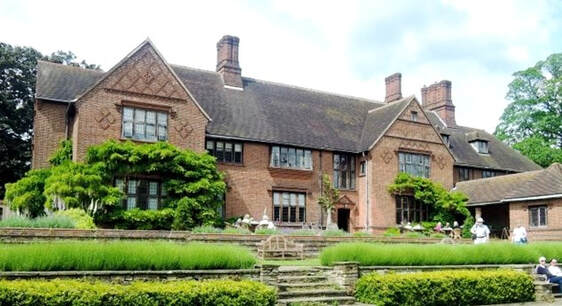
‘The House Built on Love and Chocolate’ - Goddards and the Terry family
An illustrated talk by Glennis Whyte (National Trust) on 16th February
Just 2 days after Valentine’s Day, our talk was on ‘Goddards – A House Built on Love and Chocolate’. How appropriate!
National Trust volunteer and researcher, Glennis Whyte, gave us a breezy insight into the lives of the chocolate manufacturing Terry Family and the house built in 1927 for Noel and Kathleen Terry on Tadcaster Road, with views across the racecourse to their huge new sweet factory on Bishopthorpe Road.
The name of the house was derived from Noel's grandmother, Frances Goddard, the first wife of Sir Joseph Terry. Grade 1 Listed, Goddards was the final work of architect Walter Brierley, who built a strong reputation for his Arts and Crafts designs. (Photo; National Trust)
The beautifully restored garden was designed by George Dillistone and both are popular with visitors for their relaxed domestic atmosphere.
The house still retains many of the original features, including its Arts and Crafts wallpapers, panelling and the staircase with oak carving. The drawing room has a splendid barrel ceiling, similar to Brierley’s own home, with the plasterwork in both houses attributed to George Bankart. Goddards was constructed by the York firm William Anelay using beautiful locally handmade bricks, sometimes arranged in geometric patterns, and the decorative chimney stacks are typical Brierley features.
The Terrys furnished their home with Noel's collection of mid-18th century Georgian furniture and clocks, which are now displayed at Fairfax House. It is thought that his enthusiasm for antiques was partly inspired by his father-in-law, the prominent York industrial miller, (Henry) Ernest Leetham, who had been a collector of porcelain and jade. [FFH chairman’s note: the Fishergate Ring, found at the Glassworks in 1930, was presented to the Yorkshire Museum by Kathleen Terry (nee Leetham) and her sisters in 1951, but it is not known how they came to have it. Perhaps the Glassworks owner gave it to the sisters knowing their late father’s antiquarian interests? Read more HERE ]
Noel Terry was the great-grandson of Joseph Terry, who founded the family confectionery business and was brought up at Trentholme, on the Mount, the home of his maternal grandfather, E.P. Brett of Brett brothers Brewery. Kathleen Leetham lived at Aldersyde (near the modern Tesco’s) a large house that her father commissioned in 1895.
Noel and Kathleen's courtship was difficult: they had fallen in love when very young and, at the time, Noel's financial future was not promising. However, Kathleen came of age in 1913 and they married in 1915. By that time Noel had enlisted into the army and was posted to France, where he was wounded at the Somme while serving with the 5th West Yorkshire Regiment. He returned home safely and by 1925 they had two sons, Peter and Kenneth, and a daughter, Betty.
In 1927 they moved into Goddards, where their youngest son Richard was born the following year. Noel's position within the company had improved markedly after WW1 and in 1923 he had become an active director of Terry's. During the 1930s Noel became managing director and it was at this time that the company introduced two of their most famous products – Terry's All Gold and the Chocolate Orange. When production was interrupted by the Second World War Noel became a Controller with the Royal Observer Corps and was awarded an MBE in 1943. After becoming Chairman in 1960, Noel continued to work at Terry's until 1970, and his son Peter, who had joined Terry's in 1945, became deputy managing director.
Their son Kenneth served in the RAF and was awarded the DFC in 1942. He died in 1944 and is commemorated on the local war memorial (also designed by Brierley). Both Noel and Kathleen died in 1980 and the house was sold to the National Trust in 1984 and used as their regional offices. The gardens were opened in 2006 and the house in 2012, with the layout designed to present it as it was in the family’s happy and prosperous 1930s.
Report by Chris Rainger, based on Glennis’s talk and Wikipedia entry on Goddards
Find more information about visiting Goddards at:www.nationaltrust.org.uk/goddards-house-and-garden
An illustrated talk by Glennis Whyte (National Trust) on 16th February
Just 2 days after Valentine’s Day, our talk was on ‘Goddards – A House Built on Love and Chocolate’. How appropriate!
National Trust volunteer and researcher, Glennis Whyte, gave us a breezy insight into the lives of the chocolate manufacturing Terry Family and the house built in 1927 for Noel and Kathleen Terry on Tadcaster Road, with views across the racecourse to their huge new sweet factory on Bishopthorpe Road.
The name of the house was derived from Noel's grandmother, Frances Goddard, the first wife of Sir Joseph Terry. Grade 1 Listed, Goddards was the final work of architect Walter Brierley, who built a strong reputation for his Arts and Crafts designs. (Photo; National Trust)
The beautifully restored garden was designed by George Dillistone and both are popular with visitors for their relaxed domestic atmosphere.
The house still retains many of the original features, including its Arts and Crafts wallpapers, panelling and the staircase with oak carving. The drawing room has a splendid barrel ceiling, similar to Brierley’s own home, with the plasterwork in both houses attributed to George Bankart. Goddards was constructed by the York firm William Anelay using beautiful locally handmade bricks, sometimes arranged in geometric patterns, and the decorative chimney stacks are typical Brierley features.
The Terrys furnished their home with Noel's collection of mid-18th century Georgian furniture and clocks, which are now displayed at Fairfax House. It is thought that his enthusiasm for antiques was partly inspired by his father-in-law, the prominent York industrial miller, (Henry) Ernest Leetham, who had been a collector of porcelain and jade. [FFH chairman’s note: the Fishergate Ring, found at the Glassworks in 1930, was presented to the Yorkshire Museum by Kathleen Terry (nee Leetham) and her sisters in 1951, but it is not known how they came to have it. Perhaps the Glassworks owner gave it to the sisters knowing their late father’s antiquarian interests? Read more HERE ]
Noel Terry was the great-grandson of Joseph Terry, who founded the family confectionery business and was brought up at Trentholme, on the Mount, the home of his maternal grandfather, E.P. Brett of Brett brothers Brewery. Kathleen Leetham lived at Aldersyde (near the modern Tesco’s) a large house that her father commissioned in 1895.
Noel and Kathleen's courtship was difficult: they had fallen in love when very young and, at the time, Noel's financial future was not promising. However, Kathleen came of age in 1913 and they married in 1915. By that time Noel had enlisted into the army and was posted to France, where he was wounded at the Somme while serving with the 5th West Yorkshire Regiment. He returned home safely and by 1925 they had two sons, Peter and Kenneth, and a daughter, Betty.
In 1927 they moved into Goddards, where their youngest son Richard was born the following year. Noel's position within the company had improved markedly after WW1 and in 1923 he had become an active director of Terry's. During the 1930s Noel became managing director and it was at this time that the company introduced two of their most famous products – Terry's All Gold and the Chocolate Orange. When production was interrupted by the Second World War Noel became a Controller with the Royal Observer Corps and was awarded an MBE in 1943. After becoming Chairman in 1960, Noel continued to work at Terry's until 1970, and his son Peter, who had joined Terry's in 1945, became deputy managing director.
Their son Kenneth served in the RAF and was awarded the DFC in 1942. He died in 1944 and is commemorated on the local war memorial (also designed by Brierley). Both Noel and Kathleen died in 1980 and the house was sold to the National Trust in 1984 and used as their regional offices. The gardens were opened in 2006 and the house in 2012, with the layout designed to present it as it was in the family’s happy and prosperous 1930s.
Report by Chris Rainger, based on Glennis’s talk and Wikipedia entry on Goddards
Find more information about visiting Goddards at:www.nationaltrust.org.uk/goddards-house-and-garden
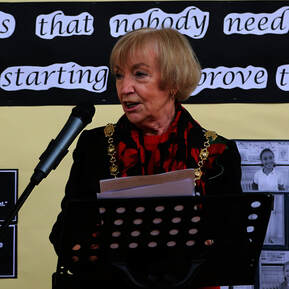
Fishergate School Armistice Commemoration
We held an amazingly successful event at Fishergate school on 10th November, where some 90 people came to hear readings from our new book about the school and the 86 former pupils named on the Great War memorial in the entrance porch.
The exhibition of photographs of Fishergate and the school, including pages from the headmaster's Log Book, also generated a lot of interest, with one elderly gentleman saying this was the first time he had stepped inside the school since the 1930s.
We were privileged that the Lord Mayor and Sheriff (Verna Campbell, pictured right) of York came to give readings, along with our two Green councillors and Stephen Lewis, of the York Press. But best of all were readings by Fishergate school pupils and Brownies from 1st St Margaret's.
Huge thanks to all - now we can enjoy the peace!
You can download a transcript of the readings and see pictures HERE
Copies of our new 240 page book about the lives, families and military service of the 86 men and their school are available for just £10 + £5 postage.
Email [email protected] to make arrangements for payment and delivery, or use the Contact Box HERE
Also, see our WW1 Page HERE
We held an amazingly successful event at Fishergate school on 10th November, where some 90 people came to hear readings from our new book about the school and the 86 former pupils named on the Great War memorial in the entrance porch.
The exhibition of photographs of Fishergate and the school, including pages from the headmaster's Log Book, also generated a lot of interest, with one elderly gentleman saying this was the first time he had stepped inside the school since the 1930s.
We were privileged that the Lord Mayor and Sheriff (Verna Campbell, pictured right) of York came to give readings, along with our two Green councillors and Stephen Lewis, of the York Press. But best of all were readings by Fishergate school pupils and Brownies from 1st St Margaret's.
Huge thanks to all - now we can enjoy the peace!
You can download a transcript of the readings and see pictures HERE
Copies of our new 240 page book about the lives, families and military service of the 86 men and their school are available for just £10 + £5 postage.
Email [email protected] to make arrangements for payment and delivery, or use the Contact Box HERE
Also, see our WW1 Page HERE
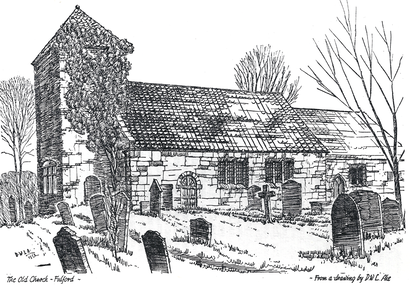
Our 2017 Festival of Ideas conference on the 'Historic Mystery of Old St Oswald's Church' was fantastically successful!
Read more on our Old St Oswald's page and listen (HERE) to
Prof Jane Hawkes talking about the Anglo-Saxon cross which was found built into the nave in 1980, when the building was being converted into a private house.
A full report on the 1980s archaeological investigations and the history of the church will be published by the Yorkshire Archaeological and Historical Society in 2020.
Read more on our Old St Oswald's page and listen (HERE) to
Prof Jane Hawkes talking about the Anglo-Saxon cross which was found built into the nave in 1980, when the building was being converted into a private house.
A full report on the 1980s archaeological investigations and the history of the church will be published by the Yorkshire Archaeological and Historical Society in 2020.
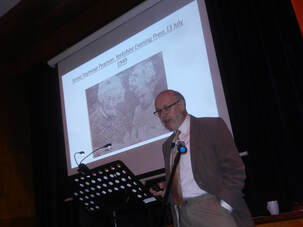
How Feisty Local Women Won the Vote
Our October 2018 meeting was a wonderfully informative and interesting talk by Mike Waters about the campaign for women to have equal voting rights. A fuller report will follow shortly, but you can read Mike's script HERE We also heard from Catherine Djimramadji, the great-great granddaughter of Annie Coultate, the Fishergate School senior teacher who set up the York branch of the Women's Social and Political Union. Open our webpage with more on York's suffragettes, HERE |
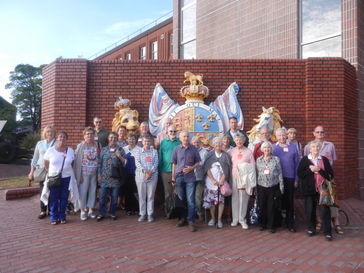
In July 2018, members visited Imphal Barracks and the Kohima Museum (open Thursday mornings).
We climbed the stairs to the top of the Keep, which was built to be the armoury and walked among the late-Victorian buildings, led by our 1st Chairman, Bob Cook, and Brian Ward, we ended with Bob's talk about the terrifying battle of Kohima, which prevented the Japanese invasion of north east India during WW2.
Many thanks to Major Jim Watt for his generous hospitality.
FFH members photographed standing in front of the 1796 Coadstone cast sculpture which originally stood on top of the Cavalry Barracks entrance.
Click HERE to open our webpage on the barracks
We climbed the stairs to the top of the Keep, which was built to be the armoury and walked among the late-Victorian buildings, led by our 1st Chairman, Bob Cook, and Brian Ward, we ended with Bob's talk about the terrifying battle of Kohima, which prevented the Japanese invasion of north east India during WW2.
Many thanks to Major Jim Watt for his generous hospitality.
FFH members photographed standing in front of the 1796 Coadstone cast sculpture which originally stood on top of the Cavalry Barracks entrance.
Click HERE to open our webpage on the barracks
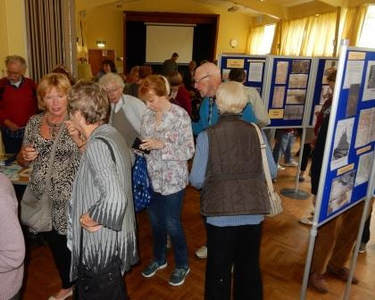
Our 2018 Festival of ideas event was...
1795 and all that! - The Coming of the Cavalry to Fulford.
Judy Nicholson gave a vivid talk to 65 members and friends about the cavalry and infantry barracks and the impact of their presence on local people.
Barbara King and Judy also mounted a very interesting display of images and maps, which will be on show again at Fulford Show.
Louise made another of her fabulous cakes, this time iced with the Union flag, very appropriate! (image courtesy Catherine Sotheran)
1795 and all that! - The Coming of the Cavalry to Fulford.
Judy Nicholson gave a vivid talk to 65 members and friends about the cavalry and infantry barracks and the impact of their presence on local people.
Barbara King and Judy also mounted a very interesting display of images and maps, which will be on show again at Fulford Show.
Louise made another of her fabulous cakes, this time iced with the Union flag, very appropriate! (image courtesy Catherine Sotheran)
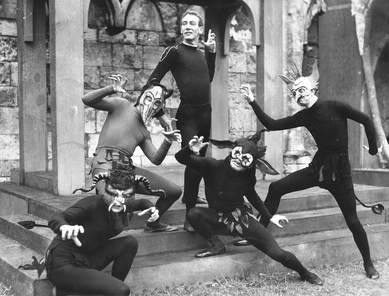
1951 - York's Part in the Festival of Britain and the Revival of the Mystery Plays
Margaret Scott gave us a very interesting talk in March about how York celebrated the 1951 Festival of Britain, the main event of which was the revival of the medieval Mystery Plays, the first time they had been performed in the city since the 16th century.
Many local people took part, including Judy Dench, who played an angel, and the production was a huge success.
You can look for relatives and friends in the cast list HERE.
Fore more information, see the York Mystery Play Archive HERE
This picture of Lucifer (Satan), played by John van Eyssen, and his demons is from the repeat production in 1954.
Image courtesy Nation Centre for Early Music.
Margaret Scott gave us a very interesting talk in March about how York celebrated the 1951 Festival of Britain, the main event of which was the revival of the medieval Mystery Plays, the first time they had been performed in the city since the 16th century.
Many local people took part, including Judy Dench, who played an angel, and the production was a huge success.
You can look for relatives and friends in the cast list HERE.
Fore more information, see the York Mystery Play Archive HERE
This picture of Lucifer (Satan), played by John van Eyssen, and his demons is from the repeat production in 1954.
Image courtesy Nation Centre for Early Music.
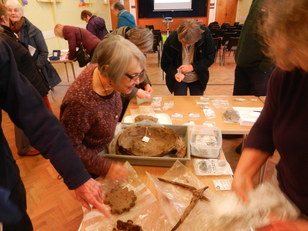
Germany Beck Archaeological Investigations
Over 70 people came to hear Paula Ware and Kelly Hunter talk about the archaeological investigations at the controversial Germany Beck housing site on 20th January 2018. Everyone had a great time looking at the finds they brought along, including the earliest Neolithic pot found in York, a Roman Trumpet Brooch, Civil War musket Balls, medieval coins and an early 20th Century Tram Wheel, masquerading as a shield boss!
Read more about the site HERE
Over 70 people came to hear Paula Ware and Kelly Hunter talk about the archaeological investigations at the controversial Germany Beck housing site on 20th January 2018. Everyone had a great time looking at the finds they brought along, including the earliest Neolithic pot found in York, a Roman Trumpet Brooch, Civil War musket Balls, medieval coins and an early 20th Century Tram Wheel, masquerading as a shield boss!
Read more about the site HERE
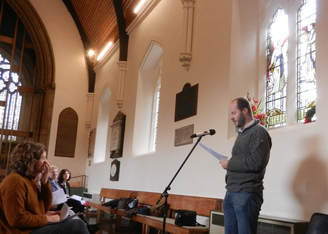
We presented our biographies of the seven men named on the Heslington Church Great war memorial window on 18th November 2017.
Seven people read a script edited from each man's biography, including Prof. Gavin Thomas, pictured here, interspersed by local people describing the village they would have known. It was a very moving occasion.
For a photograph of the window and extracts from the biographies, please see our WW1 page HERE
Seven people read a script edited from each man's biography, including Prof. Gavin Thomas, pictured here, interspersed by local people describing the village they would have known. It was a very moving occasion.
For a photograph of the window and extracts from the biographies, please see our WW1 page HERE
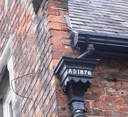
Our 2017 Christmas Social was a very sociable success!
As well as sharing lovely food with members new and old, we tried to spot photographs of date plaques on local buildings.
Click HERE to see how many you can identify.
As well as sharing lovely food with members new and old, we tried to spot photographs of date plaques on local buildings.
Click HERE to see how many you can identify.
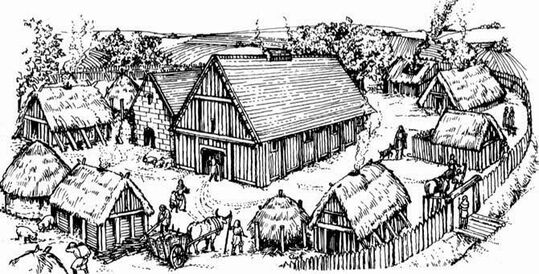
Cecily Spall’s Talk to FFH on ‘Our Area – After the Romans Left’
14th October 2017 - A report by Rosemary Newman
Cecily Spall’s talk focused on both earlier and current thinking about change within this area during the Anglian period (5th-9th Century) after the Romans left York around 410AD.
Although the departure of the Romans from the city of Eboracum was swift this outlying area was less affected, with evidence of a continued pattern of rural settlement and trade that had existed from Neolithic times.
This has been shown by past projects, more recent geophysics and new discoveries at Heslington East, Lamel Hill, Heslington Hill (misnamed Siward’s How) and in the Fishergate area. This is not so true of Fulford where fewer Anglian finds have been made, possibly reflecting the denser later development there. The notable exceptions are the cross shaft at old St Oswald’s and the Fulford gold Shilling.
While Anglian remains in York itself are limited, recent geophysics has revealed the signature of a settlement pattern of small sunken-featured dwellings or ‘Grubenhauser’ stretching from East Heslington across to Sherburn, similar to those found on the Wolds, with cremations present. East Heslington itself has yielded evidence of both burial and cremations, and Anglian settlement with metal working, together with weaving tools, Anglian wrist clasps (Copper Alum) and post-Roman iron penannular broches.
Anglian C8th and C9th burials (about 40 skeletons) were found in the 1980s at Lamel Hill, in the grounds of The Retreat, and at nearby Belle Vue House. Lamel Hill was itself the site of Roman cremation; more recently a badly damaged Roman wall was uncovered here. At the 2002 excavation of Heslington Hill behind the Morrell Library some mid-Anglian (C5-C7th) finds of pottery vessels/sherds, glass beads, a knife, and animal bones dating to the same period were found. However, there were no human bones evident, suggesting this was a likely domestic settlement area with meat and grain production, the site being abandoned in the mid C6th when Fishergate (Eoforwic) grew in importance. Read more about this HERE.
The origin and purpose of Heslington Hill (Siward’s How) is still uncertain. It has been suggested that it was early medieval burial ground but more investigation is planned. The ridge and furrow visible from the road to the west of the site dates from the C11th and passes under the mound.
In Fishergate itself there is evidence of small enclosed fields showing a rural setting before entering urban York, a number of which contain Roman cremation burials.
The Blue Bridge Lane excavation of 1999- 2001 uncovered many Saxon cess pits later used to deposit working remains of antler combs, buckles, and spinning and weaving tools, as well as similar lost personal items and beads. The nearby Fishergate House site excavation revealed not only 200 skeletons of the C12-C16 (from old St Helen’s) but also a female Anglian inhumation (dated c.680-930 AD, with the data indicating the earlier end of this range).
Read all about the Blue Bridge Lane investigations here: http://www.mgassocs.com/mono/001/index.html
One significant Anglian find in Fulford has been the Fulford Gold Shilling dated 620-650 AD, although how it came to be there is anyone’s guess. What the evidence from the research and recent finds at Heslington East and West, and Fishergate reveals is the continuity of settlement and the importance of trade after the Romans left. This was followed by with a gradual movement down from Heslington Moraine to the lower level of the present village, and to Fulford and Fishergate (Eoforwic).
We are particularly grateful to Cecily, as she gave this talk just after taking her dogs to the vet following an attack by another dog early that morning. She also had to contend with the very poor acoustics of the church, rather than our usual meeting place. We are pleased t report that the dogs are recovering well from their ordeal.
Cecily Spall BSc MA MIfA FSA Scot, is a Director of FAS Heritage, based in Hospital Fields Rd. York.
14th October 2017 - A report by Rosemary Newman
Cecily Spall’s talk focused on both earlier and current thinking about change within this area during the Anglian period (5th-9th Century) after the Romans left York around 410AD.
Although the departure of the Romans from the city of Eboracum was swift this outlying area was less affected, with evidence of a continued pattern of rural settlement and trade that had existed from Neolithic times.
This has been shown by past projects, more recent geophysics and new discoveries at Heslington East, Lamel Hill, Heslington Hill (misnamed Siward’s How) and in the Fishergate area. This is not so true of Fulford where fewer Anglian finds have been made, possibly reflecting the denser later development there. The notable exceptions are the cross shaft at old St Oswald’s and the Fulford gold Shilling.
While Anglian remains in York itself are limited, recent geophysics has revealed the signature of a settlement pattern of small sunken-featured dwellings or ‘Grubenhauser’ stretching from East Heslington across to Sherburn, similar to those found on the Wolds, with cremations present. East Heslington itself has yielded evidence of both burial and cremations, and Anglian settlement with metal working, together with weaving tools, Anglian wrist clasps (Copper Alum) and post-Roman iron penannular broches.
Anglian C8th and C9th burials (about 40 skeletons) were found in the 1980s at Lamel Hill, in the grounds of The Retreat, and at nearby Belle Vue House. Lamel Hill was itself the site of Roman cremation; more recently a badly damaged Roman wall was uncovered here. At the 2002 excavation of Heslington Hill behind the Morrell Library some mid-Anglian (C5-C7th) finds of pottery vessels/sherds, glass beads, a knife, and animal bones dating to the same period were found. However, there were no human bones evident, suggesting this was a likely domestic settlement area with meat and grain production, the site being abandoned in the mid C6th when Fishergate (Eoforwic) grew in importance. Read more about this HERE.
The origin and purpose of Heslington Hill (Siward’s How) is still uncertain. It has been suggested that it was early medieval burial ground but more investigation is planned. The ridge and furrow visible from the road to the west of the site dates from the C11th and passes under the mound.
In Fishergate itself there is evidence of small enclosed fields showing a rural setting before entering urban York, a number of which contain Roman cremation burials.
The Blue Bridge Lane excavation of 1999- 2001 uncovered many Saxon cess pits later used to deposit working remains of antler combs, buckles, and spinning and weaving tools, as well as similar lost personal items and beads. The nearby Fishergate House site excavation revealed not only 200 skeletons of the C12-C16 (from old St Helen’s) but also a female Anglian inhumation (dated c.680-930 AD, with the data indicating the earlier end of this range).
Read all about the Blue Bridge Lane investigations here: http://www.mgassocs.com/mono/001/index.html
One significant Anglian find in Fulford has been the Fulford Gold Shilling dated 620-650 AD, although how it came to be there is anyone’s guess. What the evidence from the research and recent finds at Heslington East and West, and Fishergate reveals is the continuity of settlement and the importance of trade after the Romans left. This was followed by with a gradual movement down from Heslington Moraine to the lower level of the present village, and to Fulford and Fishergate (Eoforwic).
We are particularly grateful to Cecily, as she gave this talk just after taking her dogs to the vet following an attack by another dog early that morning. She also had to contend with the very poor acoustics of the church, rather than our usual meeting place. We are pleased t report that the dogs are recovering well from their ordeal.
Cecily Spall BSc MA MIfA FSA Scot, is a Director of FAS Heritage, based in Hospital Fields Rd. York.
Our Exhibition at Fulford Show - August 2017
These photos speak for themselves - showing visitors pouring over our displays and information folders in the Scout Hut (thanks Scouts) and talking to our members.
Big thanks to Judy Nicholson, Louise Wheatley, Geoff Shearsmith, Rosemary Newman Barbara King, Martin Lomas and others for helping to make the day such a success.
Louise sold all her Fulford Biscuits too!
These photos speak for themselves - showing visitors pouring over our displays and information folders in the Scout Hut (thanks Scouts) and talking to our members.
Big thanks to Judy Nicholson, Louise Wheatley, Geoff Shearsmith, Rosemary Newman Barbara King, Martin Lomas and others for helping to make the day such a success.
Louise sold all her Fulford Biscuits too!
Germany Beck Community Archaeology
Archaeologists working on the housing site in Fulford have discovered Romano-British field systems and a range of finds from this period and other items which show that people have lived here since soon after the end of the Ice Age, including flints and a Neolithic 'Mortlake' type pot - thought to be the earliest dated pot for York or its environs.
We will be starting our programme of 2018 meetings with Paula Ware, Director of Malton Archaeology, telling us about the site and showing us some of the exciting finds. The meeting will be on Saturday 20th January at 10am at St Oswald's Church Hall.
Read more about the Germany Beck site on this website HERE
Archaeologists working on the housing site in Fulford have discovered Romano-British field systems and a range of finds from this period and other items which show that people have lived here since soon after the end of the Ice Age, including flints and a Neolithic 'Mortlake' type pot - thought to be the earliest dated pot for York or its environs.
We will be starting our programme of 2018 meetings with Paula Ware, Director of Malton Archaeology, telling us about the site and showing us some of the exciting finds. The meeting will be on Saturday 20th January at 10am at St Oswald's Church Hall.
Read more about the Germany Beck site on this website HERE
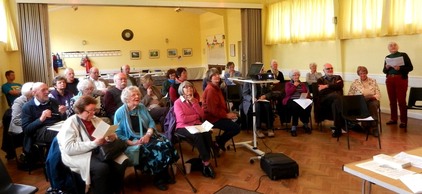
Our 5th Annual General Meeting
Our annual general meeting was held on 2nd April 2017. Read the Chairman's Report HERE.
The meeting was followed by the launch of our Fulford Main Street Walking Trail, with Judy Nicholson (pictured speaking below) and Barbara King giving a short talk on some highlights from the leaflet, illustrated by Martin Lomas' beautiful drawings.
Click HERE to read more about Fulford and our new leaflet
Our annual general meeting was held on 2nd April 2017. Read the Chairman's Report HERE.
The meeting was followed by the launch of our Fulford Main Street Walking Trail, with Judy Nicholson (pictured speaking below) and Barbara King giving a short talk on some highlights from the leaflet, illustrated by Martin Lomas' beautiful drawings.
Click HERE to read more about Fulford and our new leaflet
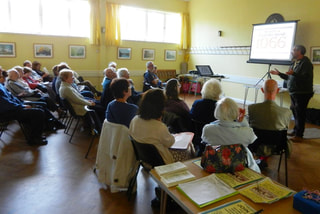
Battle Talk
On 17th September, just a few days before the 950th anniversary of the Battle of Fulford, Chris Rock gave us a very interesting talk on the Battle of Stamford Bridge.
Chris put the invasion by the king of Norway, Harald Hardrada and the deposed earl of Northumberland, Tostig Godwinson, nicely in context with the national power struggle after the death of Edward the Confessor.
This is one of the big 'what if' questions in history, as Harold Godwinson may have defeated William of Normandy's invasion at Hastings if only he hadn't travelled north to crush the invaders.
For more information on the Battle of Stamford Bridge and Heritage Society see their website here.
On 17th September, just a few days before the 950th anniversary of the Battle of Fulford, Chris Rock gave us a very interesting talk on the Battle of Stamford Bridge.
Chris put the invasion by the king of Norway, Harald Hardrada and the deposed earl of Northumberland, Tostig Godwinson, nicely in context with the national power struggle after the death of Edward the Confessor.
This is one of the big 'what if' questions in history, as Harold Godwinson may have defeated William of Normandy's invasion at Hastings if only he hadn't travelled north to crush the invaders.
For more information on the Battle of Stamford Bridge and Heritage Society see their website here.
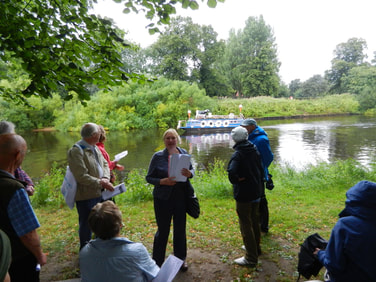
Our Walk along the New Walk, 9 August
Led by Margaret Scott
The walk began at the junction of the Foss and Ouse, the promontory where in 1858 cannons captured at Sebastopol were placed as a war memorial for York men of the Crimean War. (They were removed in 1941.)
The first part of the New Walk was formed by a path from here to the King’s Staith in 1730, by tree planting and river-bank levelling.
It was so popular with the gentry that in 1738 a blue-painted bridge was installed to allow the Walk to continue after crossing the Foss. No-one knows why it was blue! Various bridges have replaced it, the current one dates from 1929.
The City Council has maintained the levelling and the tree-planting along the river for nearly 300 years. Limes, elms and horse-chestnut have mixed with other more water tolerant ones; sadly elms have gone since 1980.
The Walk was created into empty fields and later, nursery gardens. With the exception of Lady Well and bath (at the river end of Sandringham Street), which was recorded in 1701 and John Carr’s building the Pikeing Well (at the river end of Hartoft Street) in 1752 there were no features. Even the end was just a pond. The point was to turn round and admire the view walking back into York.
The streets facing the Ouse and running away from the river were built as developers decided. New Walk Terrace began in 1825, Alma Terrace in 1855 (a year after that Crimean battle). 1879 – 1900 saw Marlborough Villas, Frances Street, Ambrose Street, Holly Terrace, Lastingham Terrace, and the 1930s saw Grange Garth built around Fulford Grange.
The houses were needed as the military grew, with the Cavalry Barracks, the Infantry Barracks and the Northern Command HQ. A military hospital was built there from 1854 – just before the Crimean War – with the main building finished in 1862. A civilian hospital was added. The Army left in 1958 and the hospital closed in 1976.
The Army’s Ordnance Works was a big feature at the south end of the Walk, behind the prominent brick wall. In 1887 a wharf was built on the Ouse to allow ‘the powder boat’ to sail up from Woolwich. Boats unloaded into trucks at the water’s edge and the little horse-drawn railway pulled gunpowder and other supplies into the Works. The railway was uncovered during changes in the riverside for the Millennium Bridge.
The Walk was built alongside a tidal Ouse, busy with sailing boats trying to avoid underwater shoals to reach York. A towing path was moved to the west side. It took several tides to come up the Ouse from Hull. 20 years after the Walk’s extension southwards, in 1757 Naburn Lock was built to level out the flows, manage river traffic and collect tolls. A second bigger lock had to be built to take steam boats, in 1888, and later the City Council owned profitable steam tugs to pull barges up river. There were sailing boats well into the 20th century.
A ferry crossed the Ouse from the New Walk, first mentioned in the 18th century but later for workers to get to their jobs in the military, the railway and Terrys. The location varied over the years, and rowing was overtaken by diesel eventually.
The walk finished beyond the Millennium Bridge, which cost £4.2 million. In the 1960s the ground was lifted by ten feet (through tipping) and levelled off to minimise flooding. It retains the name Love Lane and the old fields are now much ‘sanitised’. Lilac House is the former New Walk Tavern, where weary boatmen could wait out the tide.
Led by Margaret Scott
The walk began at the junction of the Foss and Ouse, the promontory where in 1858 cannons captured at Sebastopol were placed as a war memorial for York men of the Crimean War. (They were removed in 1941.)
The first part of the New Walk was formed by a path from here to the King’s Staith in 1730, by tree planting and river-bank levelling.
It was so popular with the gentry that in 1738 a blue-painted bridge was installed to allow the Walk to continue after crossing the Foss. No-one knows why it was blue! Various bridges have replaced it, the current one dates from 1929.
The City Council has maintained the levelling and the tree-planting along the river for nearly 300 years. Limes, elms and horse-chestnut have mixed with other more water tolerant ones; sadly elms have gone since 1980.
The Walk was created into empty fields and later, nursery gardens. With the exception of Lady Well and bath (at the river end of Sandringham Street), which was recorded in 1701 and John Carr’s building the Pikeing Well (at the river end of Hartoft Street) in 1752 there were no features. Even the end was just a pond. The point was to turn round and admire the view walking back into York.
The streets facing the Ouse and running away from the river were built as developers decided. New Walk Terrace began in 1825, Alma Terrace in 1855 (a year after that Crimean battle). 1879 – 1900 saw Marlborough Villas, Frances Street, Ambrose Street, Holly Terrace, Lastingham Terrace, and the 1930s saw Grange Garth built around Fulford Grange.
The houses were needed as the military grew, with the Cavalry Barracks, the Infantry Barracks and the Northern Command HQ. A military hospital was built there from 1854 – just before the Crimean War – with the main building finished in 1862. A civilian hospital was added. The Army left in 1958 and the hospital closed in 1976.
The Army’s Ordnance Works was a big feature at the south end of the Walk, behind the prominent brick wall. In 1887 a wharf was built on the Ouse to allow ‘the powder boat’ to sail up from Woolwich. Boats unloaded into trucks at the water’s edge and the little horse-drawn railway pulled gunpowder and other supplies into the Works. The railway was uncovered during changes in the riverside for the Millennium Bridge.
The Walk was built alongside a tidal Ouse, busy with sailing boats trying to avoid underwater shoals to reach York. A towing path was moved to the west side. It took several tides to come up the Ouse from Hull. 20 years after the Walk’s extension southwards, in 1757 Naburn Lock was built to level out the flows, manage river traffic and collect tolls. A second bigger lock had to be built to take steam boats, in 1888, and later the City Council owned profitable steam tugs to pull barges up river. There were sailing boats well into the 20th century.
A ferry crossed the Ouse from the New Walk, first mentioned in the 18th century but later for workers to get to their jobs in the military, the railway and Terrys. The location varied over the years, and rowing was overtaken by diesel eventually.
The walk finished beyond the Millennium Bridge, which cost £4.2 million. In the 1960s the ground was lifted by ten feet (through tipping) and levelled off to minimise flooding. It retains the name Love Lane and the old fields are now much ‘sanitised’. Lilac House is the former New Walk Tavern, where weary boatmen could wait out the tide.
Frankie Howerd gets a plaque
FFH is delighted that a blue plaque has been placed on 53 Hartoft Street, Fishergate, to mark the birthplace of the actor and comedian, Frankie Howerd.
The plaque was unveiled on 26th July by the Mayor of York, Dave Taylor and Tang Hall born actor Mark Addy and is one of many across the city installed by the Civic Trust.
Frankie Howerd was born in 1917 and lived at No. 53 Hartoft Street until he was three years old. His father, was Francis Alfred and his mother was Edith Florence. The family name was Howard, but he changed it "to be different".
He lived in Hartoft Street until he was three years old and he later went to Shooter's Hill Grammar School in Woolwich.
He was just 13 when he made his first stage appearance, but his early hopes of becoming a serious actor were dashed when he failed an audition for RADA. He adapted his surname during his military service in WW2.
He was famous for his seemingly off -the-cuff remarks to the audience, especially in the show Up Pompeii! and his television work was characterised by making asides directly to the camera and by his monologues and verbal tics such as "Oooh, no missus" and "Titter ye not".
FFH is delighted that a blue plaque has been placed on 53 Hartoft Street, Fishergate, to mark the birthplace of the actor and comedian, Frankie Howerd.
The plaque was unveiled on 26th July by the Mayor of York, Dave Taylor and Tang Hall born actor Mark Addy and is one of many across the city installed by the Civic Trust.
Frankie Howerd was born in 1917 and lived at No. 53 Hartoft Street until he was three years old. His father, was Francis Alfred and his mother was Edith Florence. The family name was Howard, but he changed it "to be different".
He lived in Hartoft Street until he was three years old and he later went to Shooter's Hill Grammar School in Woolwich.
He was just 13 when he made his first stage appearance, but his early hopes of becoming a serious actor were dashed when he failed an audition for RADA. He adapted his surname during his military service in WW2.
He was famous for his seemingly off -the-cuff remarks to the audience, especially in the show Up Pompeii! and his television work was characterised by making asides directly to the camera and by his monologues and verbal tics such as "Oooh, no missus" and "Titter ye not".
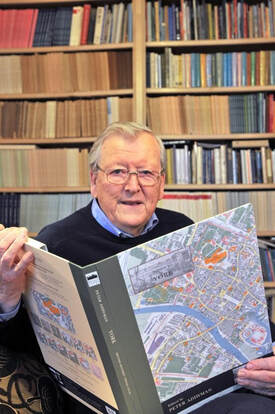
York Historical Atlas
The former Director of York Archaeology Trust, Dr Peter Addyman gave a very interesting illustrated talk on 18th June on the newly published York Historical Atlas. This was our Festival of Ideas event and was attended by some 45 people, many of whom were not FFH members.
Soon after joining YAT as its founding Director, the Chairman, Maurice Barley, suggested that Peter should begin compiling the York edition of the Historic Towns Atlas, suggesting it could be fitted in to his spare time. That was 43 years ago and the publication is a triumph of scholarship that describes the current understanding of the history of York and is so much better for the knowledge that has been accumulated by academics and archaeologists over the years.
The York Historic Towns Atlas is based on the remarkably detailed 1852 Ordnance Survey map of York and traces the history of the city from its Roman origins to the 21st century. Its editor Peter Addyman described working with a group of expert colleagues to create the Atlas and explained its significance to our understanding of the city today.
Peter set the Atlas in the context of the other publications in the series across Europe and brought copies of Central London, Winchester and other cities for everyone to look at.
The Atlas has 11 maps, period by period, bringing together topographical, archaeological, historical and cartographic evidence to present a clear picture of what is known of the city through time. In addition, 9 sheets of plates present numerous illustrations, including the earliest medieval images of York, reproductions of early maps and plans, views of the city and its buildings, and the latest aerial records.
A substantial scholarly gazetteer explains every name on the maps, ancient or modern, and for each period there is an introductory essay by the specialist contributing authors:
Patrick Ottaway (Roman York),
Richard Hall and Ailsa Mainman (Anglian York; Anglo-Scandinavian York),
David Palliser and Sarah Rees-Jones (York 1066-1272 and 1272-1536),
William Sheils (York 1536-1840 and York since 1840).
An article about the Atlas appeared in the York Press on 3rd Feb 2016. click here
The former Director of York Archaeology Trust, Dr Peter Addyman gave a very interesting illustrated talk on 18th June on the newly published York Historical Atlas. This was our Festival of Ideas event and was attended by some 45 people, many of whom were not FFH members.
Soon after joining YAT as its founding Director, the Chairman, Maurice Barley, suggested that Peter should begin compiling the York edition of the Historic Towns Atlas, suggesting it could be fitted in to his spare time. That was 43 years ago and the publication is a triumph of scholarship that describes the current understanding of the history of York and is so much better for the knowledge that has been accumulated by academics and archaeologists over the years.
The York Historic Towns Atlas is based on the remarkably detailed 1852 Ordnance Survey map of York and traces the history of the city from its Roman origins to the 21st century. Its editor Peter Addyman described working with a group of expert colleagues to create the Atlas and explained its significance to our understanding of the city today.
Peter set the Atlas in the context of the other publications in the series across Europe and brought copies of Central London, Winchester and other cities for everyone to look at.
The Atlas has 11 maps, period by period, bringing together topographical, archaeological, historical and cartographic evidence to present a clear picture of what is known of the city through time. In addition, 9 sheets of plates present numerous illustrations, including the earliest medieval images of York, reproductions of early maps and plans, views of the city and its buildings, and the latest aerial records.
A substantial scholarly gazetteer explains every name on the maps, ancient or modern, and for each period there is an introductory essay by the specialist contributing authors:
Patrick Ottaway (Roman York),
Richard Hall and Ailsa Mainman (Anglian York; Anglo-Scandinavian York),
David Palliser and Sarah Rees-Jones (York 1066-1272 and 1272-1536),
William Sheils (York 1536-1840 and York since 1840).
An article about the Atlas appeared in the York Press on 3rd Feb 2016. click here
Fulford Biscuits in the paper!
Louise Wheatley was featured in the York Press in September 2015 in a feature about the Fulford Biscuits that the FFH have been researching - and Louise has been cooking!
Download a copy of a leaflet on the Fulford Biscuit here.
Louise Wheatley was featured in the York Press in September 2015 in a feature about the Fulford Biscuits that the FFH have been researching - and Louise has been cooking!
Download a copy of a leaflet on the Fulford Biscuit here.
Lord Deramore's Primary School in Heslington have built replica WW1 trenches as part of their projects to learn about the conflict - More on this link
Our Fourth Annual General Meeting, 19th March 2016
Chairman’s Report
I must begin by expressing my very special thanks to Barbara, Judy, Louise and Roger for their outstanding work in researching, writing and publishing our biographies of the 86 Fishergate and Fulford men named on the St Oswald’s WW1 memorial. The subsequent exhibition at the York Cemetery Chapel, which we shared with other groups and interesting speakers, greatly impressed the many visitors who saw it, including the MP for York Central, Rachael Maskell.
As you will probably be aware, we eventually agreed a 75% reduction in the cost of the 64 photographs from the King’s Book of York Heroes; to £4.64each. This was, I think, mainly due to the intervention of Dean Vivienne Faull, and it allowed us to use good quality digital copies of the photographs of the men in our biographies. I worked on preparing one of the booklets for publication and was taken aback at the power of these images, as their faces looked back at me across time and I read the brief details of their cruelly truncated lives.
The committee are very grateful to FFH members who gave very generously towards the cost of the King’s Book photographs. Their donations, together with a grant from the Western Front Association and the (reasonably) healthy state of our funds, subsidised the cost of the pamphlets so we sold many more than we thought was possible - 87 and rising!
Judy, Barbara and Robert are now gathering information on the lives of the seven men named on the Heslington church WW1 memorial window. During the year we were given photographs of the area from the Jim Murphy collection, so they are combining these and other images with the biographies to give a picture of early 20th century life in Heslington. Please let them know if you have anything which may be useful, and also if you would like to join them with this interesting research project.
We have recently made contact with Fishergate School, in preparation for research into the lives of the 87 former pupils listed on the memorial in the school porch. We have been given access to the Head Teacher’s log books, and we are hoping to involve former pupils and parents to show how the war affected the school. We will also need to approach the Minster Library for more photographs. Again, please let us know if you are interested in joining this research team.
In July, many of our members took part in the geophysical investigations at the Sir John Hunt Memorial Cottage Homes. This Festival of Archaeology event came about following a suggestion by Paul Durdin after last year’s AGM. The results confirmed that the area was mostly cultivated in ridge and furrow strips, and the only specific sign of occupation was at the north-western corner, close to where Roman building materials had been found in 2014.
The year has been filled with interesting walks and talks. My favourite combined both when Mr Jagger showed us around Water Fulford Hall and Judy and Barbara explained the complex history of the hall and its owners. Other highlights included Mary Garrison bringing the 8th century alive with a lively explanation of Alcuin, York’s Anglian period ecclesiastical scholar, and Jane Cullen on the Backhouse Nurseries in York.
Louise organised two evening visits to Heslington Hall and she also gave us a typically scholarly examination of Jacobian York, based around the Heslington Hall painting of Mrs. Brooke that she successfully encouraged the art gallery to purchase last year.
On the northern fringes of Heslington, we learnt much about the Siward’s Howe area during a walk led by Jon Kenny and supported by Al Oswald. Al is leading a further walk in April this year, beginning where we left off at Green Dykes Lane and heading towards Lamel Hill.
In June, the internationally distinguished Professor Sir John Lawton led us on a walk into the Heslington Outgang, explaining the landscape history and ecology of this ancient trackway. In June this year we will have another visit to Heslington, when Nick Allen will lead us on an evening walk around the village.
More recently, Judy Nicholson finally persuaded me to apply the experience of a life-long watery career and to join her in a talk on the river Ouse through time. Judy’s appreciation of the social, economic and political significance of the river was an inspiration, and I hope you all enjoyed mixing her insights with my ramblings on tide levels, ships and navigation problems.
Thanks to the generosity of local Scouts, our Fulford Show exhibition was both larger and drier than previous years. Hundreds of people saw the exhibits and some visitors gave us yet more interesting personal stories to add to the Fulford and Heslington village history files.
Terry Court, Martin Lomas and I have been preparing a small walking guide to Main Street, Fulford. Much of the information is drawn from the Fulford village files, and Martin’s wonderful artwork has created a new standard for the genre!
Our meetings are very well attended, and as Louise Wheatley will explain in her finance and membership report, we have a (reasonably) sound foundation for our activities. This is largely due to the generosity of our members – many thanks to you all.
One important area where we need help is the FFH website. I am grateful to Margaret Scott for giving it life support, but we desperately need a new ‘webmaster’ to keep it up to date with reports on our activities, details of forthcoming events and information about our area. Please let me know if you are able to help. (it’s a weebly, which may mean something to someone!)
We are very keen to support members in their local history research and would welcome new faces on the steering committee. Please let me know if you are interested.
This is a wonderful group, with interesting and warm-hearted members. I look forward to seeing you all at our talks and walks during the coming year. Do Get Involved!
Chris Rainger
Chairman, March 2016
Chairman’s Report
I must begin by expressing my very special thanks to Barbara, Judy, Louise and Roger for their outstanding work in researching, writing and publishing our biographies of the 86 Fishergate and Fulford men named on the St Oswald’s WW1 memorial. The subsequent exhibition at the York Cemetery Chapel, which we shared with other groups and interesting speakers, greatly impressed the many visitors who saw it, including the MP for York Central, Rachael Maskell.
As you will probably be aware, we eventually agreed a 75% reduction in the cost of the 64 photographs from the King’s Book of York Heroes; to £4.64each. This was, I think, mainly due to the intervention of Dean Vivienne Faull, and it allowed us to use good quality digital copies of the photographs of the men in our biographies. I worked on preparing one of the booklets for publication and was taken aback at the power of these images, as their faces looked back at me across time and I read the brief details of their cruelly truncated lives.
The committee are very grateful to FFH members who gave very generously towards the cost of the King’s Book photographs. Their donations, together with a grant from the Western Front Association and the (reasonably) healthy state of our funds, subsidised the cost of the pamphlets so we sold many more than we thought was possible - 87 and rising!
Judy, Barbara and Robert are now gathering information on the lives of the seven men named on the Heslington church WW1 memorial window. During the year we were given photographs of the area from the Jim Murphy collection, so they are combining these and other images with the biographies to give a picture of early 20th century life in Heslington. Please let them know if you have anything which may be useful, and also if you would like to join them with this interesting research project.
We have recently made contact with Fishergate School, in preparation for research into the lives of the 87 former pupils listed on the memorial in the school porch. We have been given access to the Head Teacher’s log books, and we are hoping to involve former pupils and parents to show how the war affected the school. We will also need to approach the Minster Library for more photographs. Again, please let us know if you are interested in joining this research team.
In July, many of our members took part in the geophysical investigations at the Sir John Hunt Memorial Cottage Homes. This Festival of Archaeology event came about following a suggestion by Paul Durdin after last year’s AGM. The results confirmed that the area was mostly cultivated in ridge and furrow strips, and the only specific sign of occupation was at the north-western corner, close to where Roman building materials had been found in 2014.
The year has been filled with interesting walks and talks. My favourite combined both when Mr Jagger showed us around Water Fulford Hall and Judy and Barbara explained the complex history of the hall and its owners. Other highlights included Mary Garrison bringing the 8th century alive with a lively explanation of Alcuin, York’s Anglian period ecclesiastical scholar, and Jane Cullen on the Backhouse Nurseries in York.
Louise organised two evening visits to Heslington Hall and she also gave us a typically scholarly examination of Jacobian York, based around the Heslington Hall painting of Mrs. Brooke that she successfully encouraged the art gallery to purchase last year.
On the northern fringes of Heslington, we learnt much about the Siward’s Howe area during a walk led by Jon Kenny and supported by Al Oswald. Al is leading a further walk in April this year, beginning where we left off at Green Dykes Lane and heading towards Lamel Hill.
In June, the internationally distinguished Professor Sir John Lawton led us on a walk into the Heslington Outgang, explaining the landscape history and ecology of this ancient trackway. In June this year we will have another visit to Heslington, when Nick Allen will lead us on an evening walk around the village.
More recently, Judy Nicholson finally persuaded me to apply the experience of a life-long watery career and to join her in a talk on the river Ouse through time. Judy’s appreciation of the social, economic and political significance of the river was an inspiration, and I hope you all enjoyed mixing her insights with my ramblings on tide levels, ships and navigation problems.
Thanks to the generosity of local Scouts, our Fulford Show exhibition was both larger and drier than previous years. Hundreds of people saw the exhibits and some visitors gave us yet more interesting personal stories to add to the Fulford and Heslington village history files.
Terry Court, Martin Lomas and I have been preparing a small walking guide to Main Street, Fulford. Much of the information is drawn from the Fulford village files, and Martin’s wonderful artwork has created a new standard for the genre!
Our meetings are very well attended, and as Louise Wheatley will explain in her finance and membership report, we have a (reasonably) sound foundation for our activities. This is largely due to the generosity of our members – many thanks to you all.
One important area where we need help is the FFH website. I am grateful to Margaret Scott for giving it life support, but we desperately need a new ‘webmaster’ to keep it up to date with reports on our activities, details of forthcoming events and information about our area. Please let me know if you are able to help. (it’s a weebly, which may mean something to someone!)
We are very keen to support members in their local history research and would welcome new faces on the steering committee. Please let me know if you are interested.
This is a wonderful group, with interesting and warm-hearted members. I look forward to seeing you all at our talks and walks during the coming year. Do Get Involved!
Chris Rainger
Chairman, March 2016
On 18 April 2015, Community Archaeologist Jon Kenny, and Archaeology Lecturer Al Oswald, led a walk to Siwards Howe. Photo by Andrew Scott
Our Third Annual General Meeting, 21st March 2015
Chairman’s Report
This has been a great year for FFH. We have become recognised as a dynamic and enterprising local history group and we are firmly ‘on the map’ with the great and good of York’s history establishment!
As Louise Wheatley will tell you in her report, we have reasonably sound finances and a growing membership, with good numbers of people coming to our interesting and stimulating programme of monthly meetings. Huge thanks to Louise for her recent Newsletter and for planning and arranging the speakers. Also, many thanks to everyone who helps to make these events such a sociable treat. Suggestions for future meetings and walks will be very welcome.
One major event of 2014 was the conference on Anglian Fishergate, where over 90 people heard fascinating talks by leading specialists, followed by a wide ranging discussion chaired by City Archaeologist, John Oxley.
The ‘buzz’ around the conference led to Yorkshire Museum inviting us to partner an Art-Fund sponsored event where the Fishergate Ring was shown to local people at the Novotel. Particular thanks to Anne Akeroyd and Louise Wheatley for helping to distribute flyers around Fishergate to publicise the event. Since then, I have been working with the museum on the design of a poster about the ring, copies of which will be given to us shortly.
The centenary of the First World War has loomed large throughout 2014. Roger Thompson presented biographies of some of the men named on the St Oswald’s memorial to our November meeting, where we also had an interesting display of WW1 memorabilia and an exhibition on York women during the war by pupils from The Mount School.
Roger, Barbara King and Judy Nicholson have been working hard throughout the year on researching and compiling short biographies of all 86 men named on the Fulford memorial. The research has been quite complicated, but also very worthwhile. The stories they have uncovered have been both interesting and harrowing.
A small grant from the Western Front Association will help with the cost of publishing the biographies to commemorate these men. Edited and prepared for publication by Louise, the edition covering the 26 Fulford men will be available for sale at the AGM. It is hoped to publish the Fishergate section at an event York Cemetery Chapel in November.
An unfortunate issue has arisen during the WW1 research work. The Minster Library has refused to allow us copies of photographs, at cost price, of men pictured in the King’s Book of Heroes, and has insisted on charging us their normal, unaffordable, fee. We are still trying to resolve this matter through negotiation and have asked the Dean for help in reaching an amicable settlement.
As well as excellent presentations in the church hall, we have also had some great walking tours, including old St Oswald’s church (which I sadly missed), led by Alan Francis and Roger Walton, and New Walk Terrace area led by Margaret Scott. Rob Griffiths led us around the grounds of The Retreat, where we learned about the history of the site and the hospital’s pioneering approach to treating mental illness.
Judy and Barbara took us on the second of their detailed and fascinating walks along Fulford Main Street. On this occasion, we looked at the buildings on the west side and learned of the families and business that occupied them over the years. Judy and Barbara have accumulated an amazing archive on the village which is proving very useful for other research, including the WW1 project. People are still giving them information, including the former owner of the Saddle Inn during the campaign to prevent its re-development.
We struggled with a windy afternoon at Fulford Show, but the WW1 displays were very well received and we sold a good number of ‘Fulford type’ biscuits to raise funds for the group.
Another battle of Fulford has recently been lost and the large housing development and road realignment at Germany Beck looks set to go ahead. Some pre-works archaeology has already been undertaken along the route of the access road and part of the development site. A couple of Roman brooches and medieval coins have been found, but nothing so far relating to the 1066 battle. City Archaeologist, John Oxley insisted on an extensive programme of archaeology being undertaken on the site, so we should find a lot more about early Fulford during the coming year.
The archaeological dig at Connaught Court found medieval and Roman fields and artefacts, suggesting there was a Roman trackway, defensive palisade and buildings nearby.
Judy’s recent presentation of her photos and Geoff Shearsmith’s postcard collection brought a record turn-out to hear about the history of the Cattle Market. Like so many of our meetings, the lively discussion added even more colour to the picture.
We recently won a council grant for a Community Notice Board at Fishergate shops. Sponsored by FFH, funding was also given by the Friends of New Walk and Friends of the Cemetery Trust and a generous contribution from Mirchiz restaurant.
Work has recently begun on writing and designing a Local History Train along Fulford Main Street.
We are very keen to support members undertaking local history research and would welcome anyone who wants to join the committee and/or become more involved in the activities of the group. Please let me know if you are interested.
I look forward to seeing many of you at our talks and walks during the coming year.
Chris Rainger
Chairman
Chairman’s Report
This has been a great year for FFH. We have become recognised as a dynamic and enterprising local history group and we are firmly ‘on the map’ with the great and good of York’s history establishment!
As Louise Wheatley will tell you in her report, we have reasonably sound finances and a growing membership, with good numbers of people coming to our interesting and stimulating programme of monthly meetings. Huge thanks to Louise for her recent Newsletter and for planning and arranging the speakers. Also, many thanks to everyone who helps to make these events such a sociable treat. Suggestions for future meetings and walks will be very welcome.
One major event of 2014 was the conference on Anglian Fishergate, where over 90 people heard fascinating talks by leading specialists, followed by a wide ranging discussion chaired by City Archaeologist, John Oxley.
The ‘buzz’ around the conference led to Yorkshire Museum inviting us to partner an Art-Fund sponsored event where the Fishergate Ring was shown to local people at the Novotel. Particular thanks to Anne Akeroyd and Louise Wheatley for helping to distribute flyers around Fishergate to publicise the event. Since then, I have been working with the museum on the design of a poster about the ring, copies of which will be given to us shortly.
The centenary of the First World War has loomed large throughout 2014. Roger Thompson presented biographies of some of the men named on the St Oswald’s memorial to our November meeting, where we also had an interesting display of WW1 memorabilia and an exhibition on York women during the war by pupils from The Mount School.
Roger, Barbara King and Judy Nicholson have been working hard throughout the year on researching and compiling short biographies of all 86 men named on the Fulford memorial. The research has been quite complicated, but also very worthwhile. The stories they have uncovered have been both interesting and harrowing.
A small grant from the Western Front Association will help with the cost of publishing the biographies to commemorate these men. Edited and prepared for publication by Louise, the edition covering the 26 Fulford men will be available for sale at the AGM. It is hoped to publish the Fishergate section at an event York Cemetery Chapel in November.
An unfortunate issue has arisen during the WW1 research work. The Minster Library has refused to allow us copies of photographs, at cost price, of men pictured in the King’s Book of Heroes, and has insisted on charging us their normal, unaffordable, fee. We are still trying to resolve this matter through negotiation and have asked the Dean for help in reaching an amicable settlement.
As well as excellent presentations in the church hall, we have also had some great walking tours, including old St Oswald’s church (which I sadly missed), led by Alan Francis and Roger Walton, and New Walk Terrace area led by Margaret Scott. Rob Griffiths led us around the grounds of The Retreat, where we learned about the history of the site and the hospital’s pioneering approach to treating mental illness.
Judy and Barbara took us on the second of their detailed and fascinating walks along Fulford Main Street. On this occasion, we looked at the buildings on the west side and learned of the families and business that occupied them over the years. Judy and Barbara have accumulated an amazing archive on the village which is proving very useful for other research, including the WW1 project. People are still giving them information, including the former owner of the Saddle Inn during the campaign to prevent its re-development.
We struggled with a windy afternoon at Fulford Show, but the WW1 displays were very well received and we sold a good number of ‘Fulford type’ biscuits to raise funds for the group.
Another battle of Fulford has recently been lost and the large housing development and road realignment at Germany Beck looks set to go ahead. Some pre-works archaeology has already been undertaken along the route of the access road and part of the development site. A couple of Roman brooches and medieval coins have been found, but nothing so far relating to the 1066 battle. City Archaeologist, John Oxley insisted on an extensive programme of archaeology being undertaken on the site, so we should find a lot more about early Fulford during the coming year.
The archaeological dig at Connaught Court found medieval and Roman fields and artefacts, suggesting there was a Roman trackway, defensive palisade and buildings nearby.
Judy’s recent presentation of her photos and Geoff Shearsmith’s postcard collection brought a record turn-out to hear about the history of the Cattle Market. Like so many of our meetings, the lively discussion added even more colour to the picture.
We recently won a council grant for a Community Notice Board at Fishergate shops. Sponsored by FFH, funding was also given by the Friends of New Walk and Friends of the Cemetery Trust and a generous contribution from Mirchiz restaurant.
Work has recently begun on writing and designing a Local History Train along Fulford Main Street.
We are very keen to support members undertaking local history research and would welcome anyone who wants to join the committee and/or become more involved in the activities of the group. Please let me know if you are interested.
I look forward to seeing many of you at our talks and walks during the coming year.
Chris Rainger
Chairman
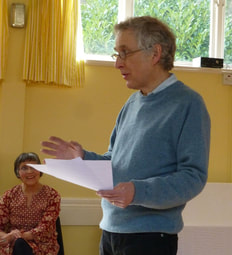 Chairman Chris Rainger recaps the FFH year.
Chairman Chris Rainger recaps the FFH year.
Second AGM March 15th 2014
Around 30 members turned up on a bright Saturday morning for our 2nd AGM. Our acting Chairman Chris Rainger opened the meeting by presenting his Chairman’s report (appended below), which was followed by short reports by our Treasurer Louise Wheatley and Webmaster Gavin Thomas. The committee was re-elected with Chris Rainger confirmed as the Chairman.
Also, committee member Barbara King and member Mary Maldon Owen revealed their first batch of Fulford Biscuits, using an ingredients list passed down through the Leng family and a recipe that Barbara and Mary, after many different variations, think was most like the original biscuit. Look out for batches of these for sale at future meetings!
Report of the Chairman (shortened for the WWW site), but available in full here. "This time last year, our first AGM elected John Hurd as Chair of the Society. He was leading us with great vigour and intellect, but was forced to resign due to ill health, so the steering committee elected me to be acting chair until this AGM. I’m delighted to report that John is making a good recovery and is hoping to become involved again before too long. One of John’s last actions for FFH was handing over some exquisite Stone-Age tools and other items, collected by the late Geoff Rounthwaite at Lingcroft Farm, Naburn, to the Yorkshire Museum.
This has been an exciting year for FFH, with growing membership and attendance at meetings and events. We have made a mark on the local history scene, and thanks to Gavin Thomas the website also has many more articles. We have also attracted grants to support our activities. One of our research projects which has been particularly successful is Barbara King and Judith Nicholson’s work on Fulford Main Street. They are gathering an increasing collection of family history stories, linked to past and present buildings in the village, and have received warm appreciation from local people as they draw together the family threads and make local history come alive. It was wonderful to see the pleasure of the people they gathered together last year in this hall to exchange stories and meet old friends. Judith and Barbara have developed an amazing filing system to manage the information they are continuing to gather, and this will be invaluable as the project moves towards some form of publication.
Main Street information and pictures also created much interest at Fulford Show, where the story of one family during WW1 was also presented, along with a variety of ‘Fulford-type’ biscuits made by Louise Wheatley. After the talk by Mary Malden-Owen in January, we now know much more about how changes in farming led to the foundation of a specialised biscuit making business in the village and shops selling them in the city.
We published our first local history walk around Fishergate during the summer and arranged a launch-event at the Postern Tower, with an exhibition of photographs, maps and drawings of the area opened by York MP, Hugh Bayley. This was arranged in association with the Friends of York Walls, and FFH members joined their volunteers in the daily opening the Tower for the British Council for Archaeology’s Archaeology Fortnight. Particular thanks are due to FFH member, Martin Lomas, whose help in designing and installing the exhibition was invaluable, and also to the Shepherd Family Trust for their generous grant. The Fishergate History Walk leaflet was partly funded by donations from local shops, pubs and other businesses, including Mecca Bingo, where we discovered that the archaeological finds from the site are being stored in the building. We are now working with City Archaeologist, John Oxley, to negotiate the transfer of these items to the Yorkshire Museum.
I have already mentioned some of the splendid monthly meetings over the year and I could fill this report reviewing all of them. Louise Wheatley deserves our heartfelt thanks for arranging such a fascinating and stimulating programme for us.
Roger Thompson is leading our preparations to commemorate WW1 and has successfully applied for a grant from the Western Front Association to support publication of a booklet later this year about the men listed on the Fulford and Heslington memorials. This dovetails well with the research and knowledge of committee members and others in FFH and will aim to give a rounded picture of the lives of these men. I hope you will continue to give us your support, and perhaps become drawn in to some of these activities. Every encouragement will be given to anyone who has an idea for their own research and we will help in any way we can."
Around 30 members turned up on a bright Saturday morning for our 2nd AGM. Our acting Chairman Chris Rainger opened the meeting by presenting his Chairman’s report (appended below), which was followed by short reports by our Treasurer Louise Wheatley and Webmaster Gavin Thomas. The committee was re-elected with Chris Rainger confirmed as the Chairman.
Also, committee member Barbara King and member Mary Maldon Owen revealed their first batch of Fulford Biscuits, using an ingredients list passed down through the Leng family and a recipe that Barbara and Mary, after many different variations, think was most like the original biscuit. Look out for batches of these for sale at future meetings!
Report of the Chairman (shortened for the WWW site), but available in full here. "This time last year, our first AGM elected John Hurd as Chair of the Society. He was leading us with great vigour and intellect, but was forced to resign due to ill health, so the steering committee elected me to be acting chair until this AGM. I’m delighted to report that John is making a good recovery and is hoping to become involved again before too long. One of John’s last actions for FFH was handing over some exquisite Stone-Age tools and other items, collected by the late Geoff Rounthwaite at Lingcroft Farm, Naburn, to the Yorkshire Museum.
This has been an exciting year for FFH, with growing membership and attendance at meetings and events. We have made a mark on the local history scene, and thanks to Gavin Thomas the website also has many more articles. We have also attracted grants to support our activities. One of our research projects which has been particularly successful is Barbara King and Judith Nicholson’s work on Fulford Main Street. They are gathering an increasing collection of family history stories, linked to past and present buildings in the village, and have received warm appreciation from local people as they draw together the family threads and make local history come alive. It was wonderful to see the pleasure of the people they gathered together last year in this hall to exchange stories and meet old friends. Judith and Barbara have developed an amazing filing system to manage the information they are continuing to gather, and this will be invaluable as the project moves towards some form of publication.
Main Street information and pictures also created much interest at Fulford Show, where the story of one family during WW1 was also presented, along with a variety of ‘Fulford-type’ biscuits made by Louise Wheatley. After the talk by Mary Malden-Owen in January, we now know much more about how changes in farming led to the foundation of a specialised biscuit making business in the village and shops selling them in the city.
We published our first local history walk around Fishergate during the summer and arranged a launch-event at the Postern Tower, with an exhibition of photographs, maps and drawings of the area opened by York MP, Hugh Bayley. This was arranged in association with the Friends of York Walls, and FFH members joined their volunteers in the daily opening the Tower for the British Council for Archaeology’s Archaeology Fortnight. Particular thanks are due to FFH member, Martin Lomas, whose help in designing and installing the exhibition was invaluable, and also to the Shepherd Family Trust for their generous grant. The Fishergate History Walk leaflet was partly funded by donations from local shops, pubs and other businesses, including Mecca Bingo, where we discovered that the archaeological finds from the site are being stored in the building. We are now working with City Archaeologist, John Oxley, to negotiate the transfer of these items to the Yorkshire Museum.
I have already mentioned some of the splendid monthly meetings over the year and I could fill this report reviewing all of them. Louise Wheatley deserves our heartfelt thanks for arranging such a fascinating and stimulating programme for us.
Roger Thompson is leading our preparations to commemorate WW1 and has successfully applied for a grant from the Western Front Association to support publication of a booklet later this year about the men listed on the Fulford and Heslington memorials. This dovetails well with the research and knowledge of committee members and others in FFH and will aim to give a rounded picture of the lives of these men. I hope you will continue to give us your support, and perhaps become drawn in to some of these activities. Every encouragement will be given to anyone who has an idea for their own research and we will help in any way we can."
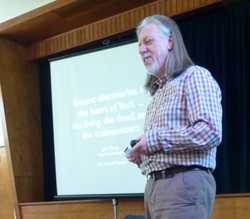 John Oxley during his fascinating talk.
John Oxley during his fascinating talk.
After the close of the formal AGM business, we were treated to a presentation by York City Archaeologist John Oxley on the Archaeology in and around York over the past year. This was a fascinating exposition of recent work in the City covering some aspects of the Hungate and King’s Square digs, including some wonderful evidence of the Viking reusing old boats in making their houses. More locally we discussed finding from the All Saint’s Fishergate dig (which is under the Barbican car park) showing the site of the church and the 17th century mass graves that were discovered that are likely Fairfax’s troops who died of infection during the siege of York in 1644. John closed with some comments on the Germany Beck development and stated that in his professional opinion as an archaeologist he thinks that it is ‘possibly’ the site for the Battle of Fulford, but that there isn’t enough hard evidence to support this site over a number of other in the area. He also showed a particularly revealing overlay of the contours of York over an OS map, which he used to shoe the lines of the York and Escrick glacial moraines that were important areas of raised land in prehistoric times. York sits on a break in the York moraine at the modern confluence of the Ouse and Foss and the aerial map reveals the wash through of the breakpoint likely formed the slightly higher ground to either site of the river, on which now sits the Fulford Road on one side and the Bishopthorpe Road on the other.
Finally the members had assembled a wonderful lunch spread which was enjoyed by the members while many interesting discussions about the FFH continued.
Finally the members had assembled a wonderful lunch spread which was enjoyed by the members while many interesting discussions about the FFH continued.
May 2013 Committee meeting
A full meeting of the committee and a new member to introduce, Chris Rainger, who led the Fishergate walking tour early this year and will be preparing some material for the site on Fishergate. Hence, the committee is now John Hurd (Chair), Judy Nicholson (Secretary), Louise Wheatley (Treasurer), Gavin Thomas (Web), and Anne Akeroyd, Barbara King, Chris Rainger and Dr. Robert Visick. The Chairman reported that he has submitted a bid to the Heritage Lottery Fund for some support for the FFH. We appear to be getting closer to tracking down the Boer War memorial that went missing from some cottages in Fulford - more on this later. Also, Chris will be launching his Fishergate walking tour leaflet on Wednesday 24th July at 2pm at Fishergate Postern Tower - come along and celebrate.
A full meeting of the committee and a new member to introduce, Chris Rainger, who led the Fishergate walking tour early this year and will be preparing some material for the site on Fishergate. Hence, the committee is now John Hurd (Chair), Judy Nicholson (Secretary), Louise Wheatley (Treasurer), Gavin Thomas (Web), and Anne Akeroyd, Barbara King, Chris Rainger and Dr. Robert Visick. The Chairman reported that he has submitted a bid to the Heritage Lottery Fund for some support for the FFH. We appear to be getting closer to tracking down the Boer War memorial that went missing from some cottages in Fulford - more on this later. Also, Chris will be launching his Fishergate walking tour leaflet on Wednesday 24th July at 2pm at Fishergate Postern Tower - come along and celebrate.
September committee meeting
Biggest news this month is that we have a new Chairman, John Hurd, who has taken over from Bob Cook who resigned due to being over-committed. We also welcome a new Committee member, Barbara King from Fulford. Barbara will be helping Louise Wheatley with the membership list. The Committee also consists of Robert Visick, Anne Akeroyd, Gavin Thomas and Judith Nicholson.
We hope to start 2013 with real membership of the group which is likely to be £5 per year, with £1 per meeting and £2 for visitors, unless we have to pay more for certain speakers. We now have a bank account and insurance, with an archival policy and health and safety policy underway. We also intend to apply for a lottery grant to help us to buy some equipment and get the group up and running, so we can begin to work on more projects in Fishergate, Fulford and Heslington. At the moment the projects we are working on include, WW1 memorials, the history of the Cavalry Barracks, buildings of note, oral history and Fulford biscuits.
We hope to start 2013 with real membership of the group which is likely to be £5 per year, with £1 per meeting and £2 for visitors, unless we have to pay more for certain speakers. We now have a bank account and insurance, with an archival policy and health and safety policy underway. We also intend to apply for a lottery grant to help us to buy some equipment and get the group up and running, so we can begin to work on more projects in Fishergate, Fulford and Heslington. At the moment the projects we are working on include, WW1 memorials, the history of the Cavalry Barracks, buildings of note, oral history and Fulford biscuits.
May Steering group meeting
At our second meeting we have made some working appointment for the next year so we have some structure in assembling and submitting our constitution. The acting Chairman of the FFH is Bob Cook, acting secretary Judith Nicholson, acting treasurer Louise Wheatley and acting Webmaster Gavin Thomas. Along with Anne Ackroyd and Robert Visick we will work toward gaining constitution for the society by the end of 2012. The programme is in place until the end of 2012, which is available on the Event page of this site. Also, we are working towards a stand at the Fulford Show which will be themed around the Fulford Biscuit, manufactured in the 19th century by the Leng family of Fulford as its a good excuse for people to make their favourite biscuits!
February Steering group meeting
We had our first steeting group meeting on the 8th February 2012 and have resolved to form a constitution and actually become a real society! Also, we firmed up the rest of the programme for 2012 which will be available here soon. We are excited that the York Historian Hugh Murray has agreed to lead a walk for the FFH around the York Cemetery in July.
Steering group
Following the January meeting we put out a call for members of a small steering committee which will now try and meet relatively frequently to coordinate FFH activities. The steering group at the moment consists of Louise Wheatley, Gavin Thomas, Judith Nichols, Anne Ackroyd, Robert Visick and Bob Cook. Informal minutes of our meetings will be posted on the site once we have arranged our first session.
FFH projects for 2012-2014
_Following our January 20112 meeting we have decided to start a group project to learn more about the 77 soldiers named on the Fulford memorial for 1914-1918 and the 7 soldiers named on the 1914-1919 memorial window in
Heslington Church. We aim to produce short biographies for all of these
brave local men and use some of them as starting points for larger
activities following family history in the FFH area through involvement of local schools. Watch this space!
We also plan a more ambitious project "3000 Years Down on the Farm", which will involved an archeaological study of Lincroft Farm, which is being led by Louise Wheatley. Lots of potential activities to do here including some Time Team style geophysics!
.
We also plan a more ambitious project "3000 Years Down on the Farm", which will involved an archeaological study of Lincroft Farm, which is being led by Louise Wheatley. Lots of potential activities to do here including some Time Team style geophysics!
.
